






reimAgining PubLic SAfety
By Sophie Hurwitz For the St.
Louis American
On Monday, February 24, the Peace Be Still coalition will hold two parallel marches in St. Louis and East St. Louis to kick off a week of advocacy for peace. Each march will be held on the city’s respective Martin Luther King Boulevard. Both marches will occur at night.
“A coalition of community-based organizations, churches, night club owners, barbers, rappers, singers, former gang members and drug deals have banded together to call for a week of peace,” they announced in a press release.
The Justice Coalition protested at the St. Louis Police Officers Association office at 3017 Hampton Ave. on Monday, February 17, demanding the removal of Jeff Roodra, its business agent and spokesman. Roorda has publicly called for St. Louis Circuit Attorney Kimberly Gardner to be removed from office “by force or by choice.”
“Martin Luther King Boulevard was chosen because it bears the name of Dr. King, but it was also chosen because that’s where the gunshots are taking place,” said James Clark, vice president for Community Outreach at Better Family Life and one of the
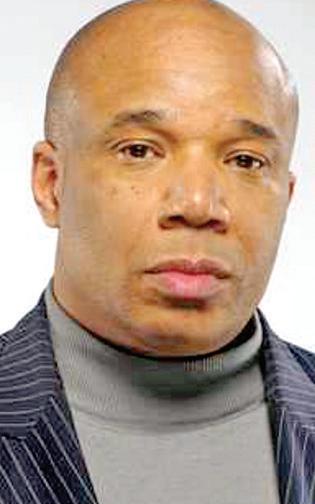
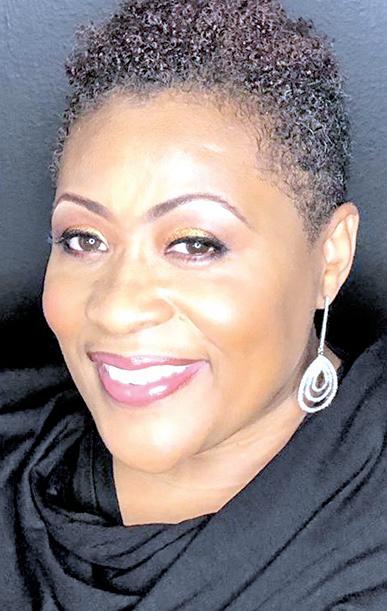
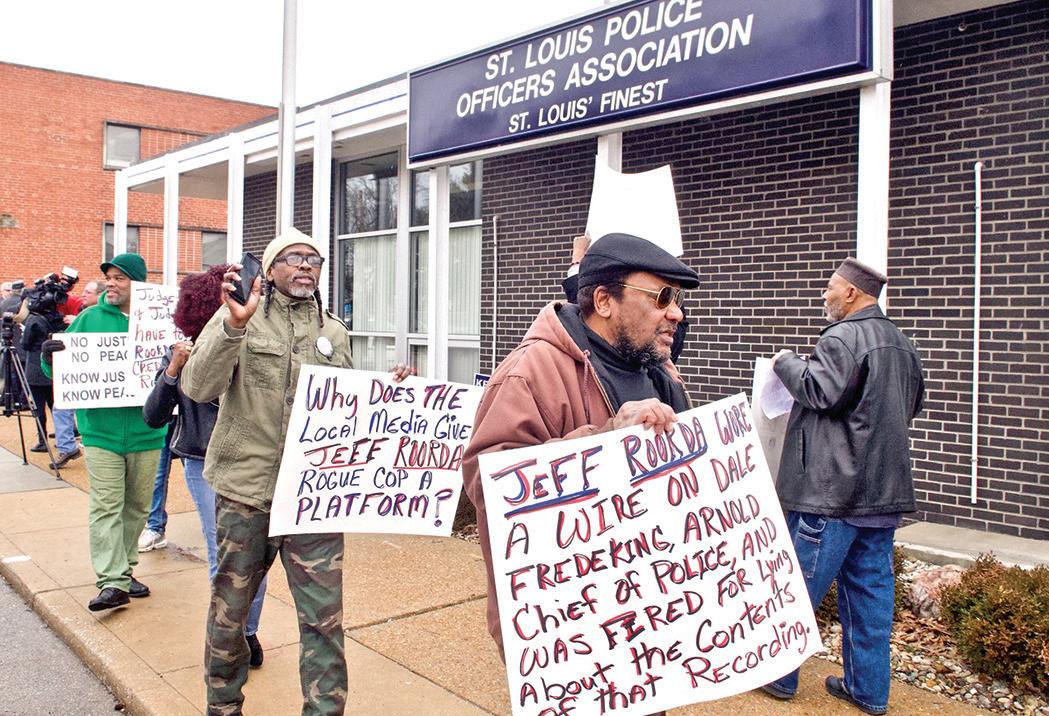
‘I would love our congressman to stand with the people’
Cori Bush wonders why Clay backs McKee on stealing Homer G. Phillips name
By Rebecca Rivas Of The St. Louis American
Zenobia Thompson was serving as a head nurse at Homer G. Phillips Hospital when she became a leader in the fight to keep city leaders from closing the iconic black teaching hospital. It was a fight she lost, alongside a strong coalition of hospital employees and activists in 1979.
Now she is on the frontline again fighting to keep developer Paul McKee Jr. from tarnishing the legacy of this black institution by naming his proposed three-bedroom hospital and freestanding emergency department the “Homer G. Phillips Hospital.” McKee
See CLAY, A6
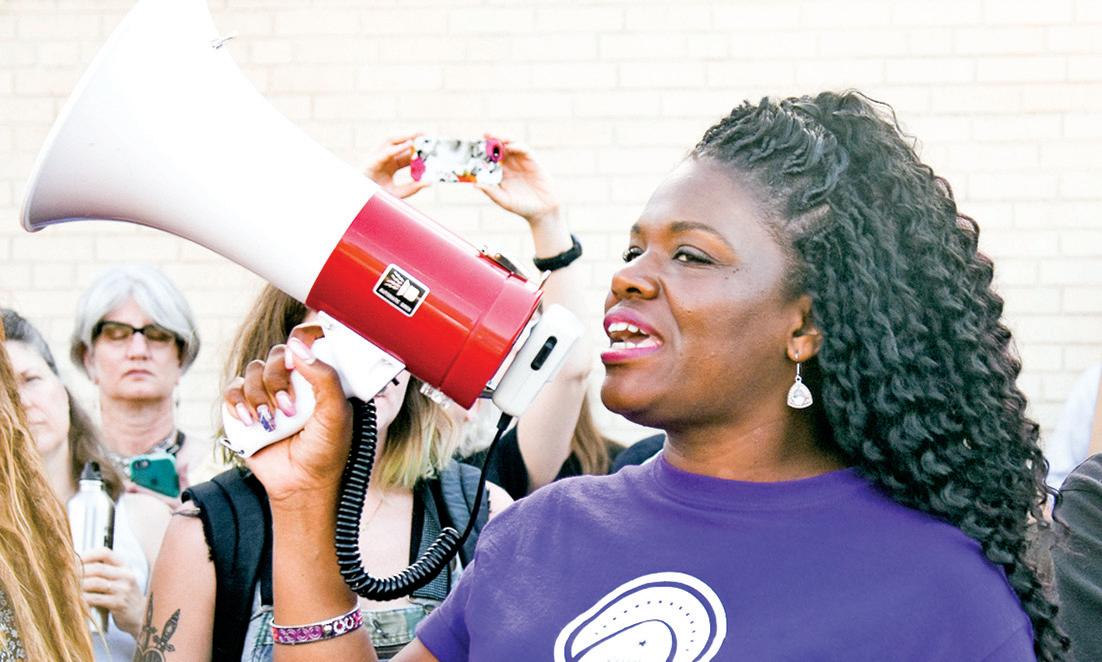
“He could pay tribute by taking care of his properties,” Cori Bush said of Paul McKee Jr. appropriating the name of Homer G. Phillips Hospital. “Pay tribute that way.”
45 elected prosecutors argue that Missouri Supreme Court should grant new trial
By Rebecca Rivas Of The St.
Louis American
Does an elected prosecutor have the authority to correct the wrongful convictions of their predecessors?
Last week, 45 elected prosecutors from around the country signed and submitted a brief to the Missouri Supreme Court fervently arguing that they did.
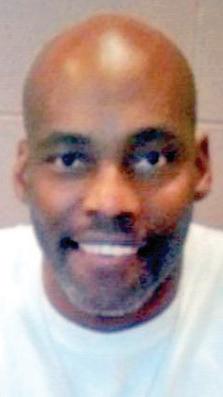
Lamar Johnson
“When an innocent person becomes enmeshed in the gears of that system, the officials empowered by the public to turn on the machinery are not powerless to turn it off,” they state in an amicus curiae brief filed on Monday, February 10.
“It would be a perverse system indeed if elected representatives may ask the courts to imprison innocent citizens but not to free them.”
The brief was submitted as part of the Lamar Johnson case, which the Supreme Court is currently reviewing and is being closely watched by elected prosecutors
Monitor reports little progress on police training and community engagement
By Sophie Hurwitz For the St. Louis American
Two areas that were part of its agreement with the U.S. Department of Justice have “remained largely stagnant,” according to consent decree monitor Natashia Tidwell: police training and community-police engagement.
In March 2016, the City of Ferguson entered into a consent decree with the DOJ. In that document, Ferguson agreed to overhaul many aspects of the city’s governance, particularly around policing
See FERGUSON, A7


Queen expected to ban Harry and Meghan from using ‘royal’ as description
The use of the word “royal” by Prince Harry and his wife, Meghan, for their new venture is being reviewed, according to a royal source. Discussions are still underway, but the likely direction is that the term will not be a part of the Sussex’s branding.
The Duke and Duchess of Sussex surprised the world last month when they announced plans to step back from their duties in the British royal family and “transition into a new working model.”
Prince Harry and Meghan agreed to stop using the titles His and Her Royal Highness. At the same time, it emerged that couple had applied for UK trademark for the term “Sussex Royal,” covering hundreds of items.
An aide to the Queen warned the Duke and Duchess against using the term, The Times of London newspaper reported earlier this month.
“I don’t think it’s satisfactory. One cannot be two things at once. You either are [royal] or you’re not,” Thomas Woodcock, Garter King of Arms, told the publication, speaking in a personal capacity.
“It is such unusual times that it is a matter of waiting and seeing how things develop,” he added.
The couple’s official Instagram account, dubbed @sussexroyal has over 11.2 million followers and the couple have accompanying website for their brand under the domain sussexroyal.com.
‘Good Times’ star Ja’net DuBois passes at 74
Beloved sitcom star Ja’net DuBois, best known for her role as Wilona Woods in the 1970s sitcom “Good Times,” passed away on Tuesday, February 18. She was 74.
Celebrity news and gossip site TMZ.com was the first to report the news. According to the outlet, DuBois died “unexpectedly in her sleep at her home in Glendale, California.
DuBois starred as Wilona Woods, best friend of Esther Rolle’s character, Florida Evans, on the hit show that ran from 1974-1979.
DuBois is also known for singing and co-writing “Moving on Up,” the theme song for “The Jeffersons,” in addition to guest roles on
television and films. She is survived by three children: Yovanne DuBois, Burghardt DuBois and Rani DuBois.
Dwyane Wade hopes openness about Zaya’s transition will help other families
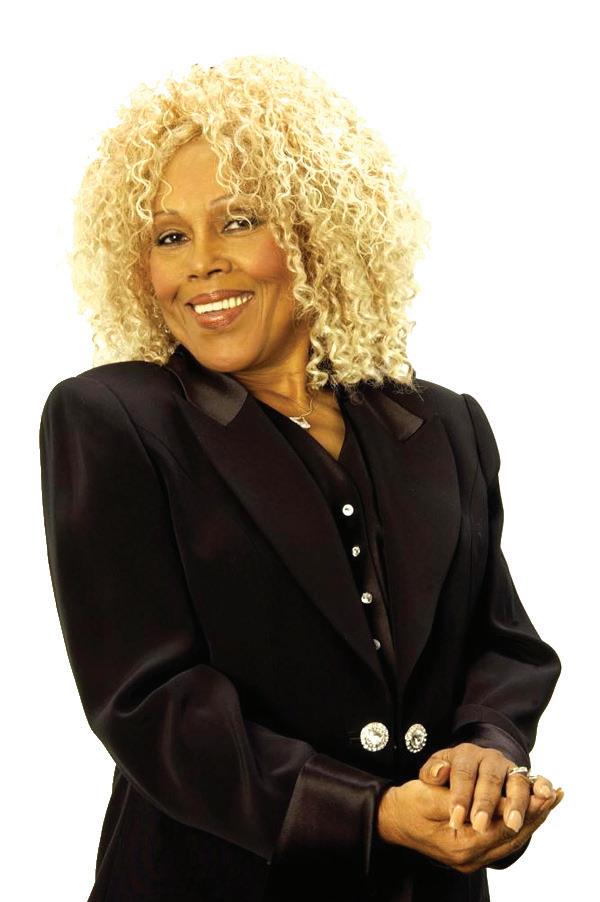
Dwyane Wade told “Good Morning America” this week that he “struggled” to know how much he wanted to talk about 12-yearourney of gender transition in his new documentary “D. Wade: Life Unexpected,” but ultimately felt it was important to shine the spotlight on her because other people will be going through similar experiences.
making a decision about her life. But we also know our child.”
Wade said that his family, which includes wife Gabrielle Union, two sons from his former wife and a previous relationship and a daughter with Union, has been through so many different things that other people and other families go through, and those families thank them for using their platform to bring attention to the issues.

“I struggled on how much I wanted to talk about it in the doc,” Wade said. “I actually didn’t talk about it a lot, but I knew if I put it in the doc at all, it would be a big conversation.
“We struggled with what people would say about a 12-year-old
“That’s what we’re trying to do,” Wade said. ‘We know there are other families out there dealing with their kid finding themselves and learning who they are.”
He admitted his daughter has been figuring out who she was since she was just three years old and recalled the “process” of helping her while trying to follow her lead.
“Zaya, early on, knew two things: She knew straight, and she knew gay,” Wade said. “But Zaya started doing more research. She is the one who sat down with us, as a family, and said, ‘Hey, I don’t think I’m gay.’ She went down a list and said, ‘This is how I identify myself. This is my gender identity. I identity myself as a young lady. I identify as straight trans because I like boys.’
It was a process for us to sit down with our daughter and find out who she is and what she likes and not put something on her because, as parents, we put our hopes and we put our fears on our kids.”
Sources: TMZ.com, ABC.com,








































































State law provides for students who would walk through areas with criminal gang activity
By Chris King For The St. Louis American
Some 1,800 students in the East St. Louis School District will receive free bus rides to school beginning with the 2020-2021 school year thanks to state legislation passed at the instigation of district parents. Illinois House Bill 5195, adopted in late 2018, allows qualifying schools to provide free bus transportation to students who reside in an area with high incidence of criminal gang activity. Previously, free school transportation was only provided to students who live more than 1.5 miles from school or for those who live less than 1.5 miles but who walked through hazardous areas as identified
n “Our parents are the ones who raised this issue and worked tirelessly to advocate for free bus transportation for all students.”
– East St. Louis School District Superintendent Arthur Culver
by the Illinois Department of Transportation. Data from the Illinois State Police, as well as the City of East St. Louis, City of Washington Park, City of Centreville and the Village of Alorton, were used as evidence for determining eligibility in the application to the Illinois State Board of Education. The East St. Louis School District was the first school district in Illinois to apply and receive a waiver for all of its students and the first to receive a transportation waiver from the Illinois State Board of Education. According to the school district, its transportation provider, Illinois Central, is in the process of adding new fleet and recruiting additional drivers to meet the increased service demand.

East St. Louis School District students from Avant Elementary School
The bill was championed by Rep. LaToya Greenwood, Rep. Jay Hoffman and Sen. James Clayborne Jr. to ensure approval in the House and Senate. East St. Louis School District Superintendent Arthur Culver noted that the district and concerned partners have been working for several years to get free transportation for students who reside in areas with high incidences of criminal gang activity.
“Our parents are the ones who raised this issue and worked tirelessly to advocate for free bus transportation for all students,” Culver stated in a release. “Their advocacy has led to this win for our students. We also want to thank our Board of Education and the Financial Oversight Panel for their support and steadfast concern for the safety of our students.”
The district also thanked
local municipalities and police departments for their assistance with compiling the data reports needed for the waiver application.
“The chances of being murdered in East St. Louis are 19 times greater than the national average,” the Belleville News-Democrat reported last April. “The national homicide rate is around 5 murders for 100,000 people; in East St. Louis,
it’s 96 murders per 100,000, topping cities like Chicago, St. Louis, Detroit and Washington, D.C. Yet only 25 percent of the murders are charged in criminal court, compared to a national average of 60 percent.” The News-Democrat noted that there were 453 murders within the 14-square-mile border of East St. Louis from 2000 to 2018.

Those of us who support St. Louis Circuit Attorney Kimberly Gardner’s reform agenda and want her to succeed have to be realistically concerned about the ongoing special prosecutor’s investigation of her office. This is nothing specific to Gardner or to her dual disadvantaged minority status as a black woman prosecutor. It’s a reasonable assumption that any prosecutor’s office and any police department would face tough questions about decisions made and situations handled in the course of doing the people’s business if the details of their work were known. What is true in most cases is that the prosecutor works harmoniously with the police, and neither turns evidence on the other. The potential complaining witnesses who know about the mistakes made (and covered up) end up as silent accomplices, either before or after the fact.
The lawyers who charged Tisaby with those felonies know that, even if the charges are true, Tisaby did something that prosecutors and their investigators do all of the time.
The difference, however, is that most prosecutors and their investigators cover the backs of the police officers they work with, so the cops have their backs. They would never get down into the kind of dogfight where the cops are walking into a prosecutor’s office with a search warrant for the email server and a private attorney – familiar and friendly to the police – empowered as the special prosecutor of the elected prosecutor.
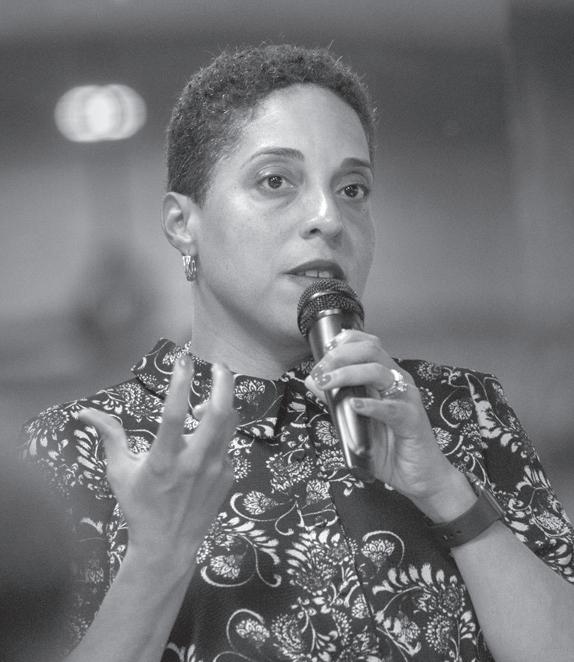
A reform prosecutor – of any race or gender – disrupts old ways of doing things, and that includes old ways of covering up for each other and turning a blind eye rather than state’s evidence. This puts the reform prosecutor at extreme risk. Gardner could be described as facing the nightmare scenario for a reform prosecutor who has tried to disrupt the status quo. Her adversaries finagled the appointment of a special prosecutor who obtained a search warrant for her office server with its email records. In an age of digital communications, many difficult decisions will have been made and precarious situations handled via office email.
Again, we think it’s a reasonable assumption that no prosecutor’s office or police department would emerge unscathed from an adversarial investigation where the office email server was emptied out into the evidence locker and principals were served subpoenas for sworn depositions. The William Tisaby indictment is an important indicator. Tisaby stands accused of multiple perjury felonies for doing what, if the charges are valid, amounts to coaching a witness while trying to keep his coaching off the record.
Gerard Carmody, the special prosecutor whose investigation led to the charges against Tisaby, has made no announcement regarding any evidence he may have found pursuant to the search warrants and subpoenas he has had served on Gardner’s office. Carmody, the police and many others who have assisted in his investigation now stand accused by Gardner of a racist conspiracy – referencing the Ku Klux Klan act, which are fighting words. We can expect Carmody and company to respond with the most damaging evidence they can find and the hardest charges they can file.
n A reform prosecutor – of any race or gender –disrupts old ways of doing things, and that includes old ways of covering up for each other and turning a blind eye rather than state’s evidence.
Assuming and yearning for the best, we can only offer at this point two pieces of advice for reformer prosecutors and those who find fault in the agenda, competence or ethics of reformer prosecutors.
Reformer prosecutors need to know they can’t make the mistakes and questionable decisions that status quo prosecutors can (and routinely do) get away with making. Everything you do in office can and will be used against you. And standard bearers of the status quo, if you want to oppose and even investigate a reformer prosecutor, especially if she is a black woman, when you have a loudmouth, bigoted white male representing the police on your side, then don’t be surprised if you’re cited for violating the Ku Klux Klan Act.
As I See It - A Forum for Community Issues
By Mike Jones
Of The St. Louis American
I cast my first presidential vote in 1972, and I’ve never not voted. I’ve never consider voting for a Republican as a matter of principle: we believe completely different things about the role and purpose of government in civil society. It doesn’t mean we can’t coexist, as long as I have enough power to balance their power. Over 48 years of voting, every Democratic presidential candidate I’ve voted for is someone I would have never chosen. I voted for them not because they were the best option for the black community but because the Republican option was always worse for the black community. This is our political fate: every four years we get to choose between bad and worse. This year will be no different but the stakes will be much, much higher. It’s these much higher stakes that make our decision this year so consequential.
This not a question of Western political philosophy or presidential preferences. It’s about the malignant cancer that has spread to the vital organs of American society and will metastasize if Donald Trump is reelected in November.
As a cancer survivor, I know that in battle with cancer there is no accommodation, no compromise – either you prevail or cancer does. If fact, you don’t cure cancer; you send it into remission. When confronted with cancer, you have to be totally committed to fighting for your life or cancer
will take your life. It’s war with no quarter given and none asked, which means you have to be as merciless as cancer if you want to maximize your chances of living. I want to give a more factbased, historical example of what I mean.
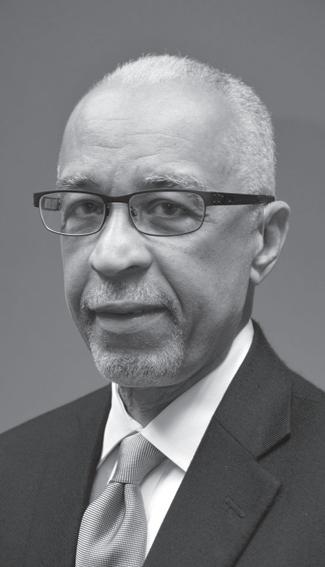
In World War II, an American president (Roosevelt) and a British prime minister (Churchill) formed a military alliance with a Russian communist (Stalin) in order to defeat a German Nazi (Hitler). As soon as the Nazi Germany was defeated, the United States and Russia engaged in a competition for global dominance known as the Cold War. At the same time, on the other side of the world a revolutionary Chinese communist (Mao Zedong) was engaged in a civil war with a reactionary Chinese nationalist (Chiang Kai-shek). Mao declared a truce and formed an alliance to defeat the Imperial Japanese Army occupying China. The minute the Japanese were defeated, the civil war resumed, Mao routed the Chinese nationalist and founded the People’s Republic of China. The point is that when faced with an existential threat to your existence, you have only one moral imperative: to do what’s required to prevail. Whether it’s a personal battle
By Richard OmoniyiShoyoola For The St. Louis American
The recent acquittal of President Trump by the U.S. Senate has paved the way for an expansion of his antiimmigrant policy agenda.
The Trump administration recently announced bans on permanent resident visas to nationals of Tanzania, Eritrea, Sudan, and Nigeria in Africa, the Southeast Asian state of Myanmar, and the Central Asian state of Kyrgyzstan. Effective February 21, these new bans will compound the ongoing 2017 ban to six majority Muslim countries among others, a policy upheld by the U.S. Supreme Court in June of 2018.
The stated rationale from Acting Homeland Security Secretary Chad Wolf is that these new visa bans are in response to security concerns over terrorism, passport technology, and a failure of information sharing between governments. This dubious policy stance, however, only raises more questions.
Why must all future permanent residency visas be banned, but temporary visas for tourism, business, students,
Letters
and workers be allowed to continue? Why risk alienating key allies, particularly in Africa, given the efforts of the Kremlin and Chinese government to expand their political influence on the continent? Why do immigrants from countries like Sudan and Eritrea get sanctioned because of information-sharing concerns, yet the slate of domestic terrorists carrying out mass shootings in the U.S. not warrant sweeping preemptive measures by the executive branch?
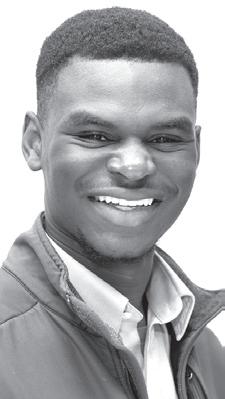
Clearly the Trump administration’s priority with these sweeping bans is not to improve domestic security standards. The goal here is rather to limit the number of immigrants entering the United States from the wrong countries, those President Trump chose an especially ugly word to describe in 2018.
But the strong resistance to enacting common-sense gun
Correction
In Lora Gulley’s column about proposed changes to Medicaid, she stated that black babies are two times more likely to die than white babies in the St. Louis region. In fact, the disparity is that black babies in the St. Louis region are three times more likely to die than white babies.
Shame on our Missouri senators
with cancer or the fate of millions of people, you can’t afford an argument about the good versus the bad when you’re at war with the worst.
Over the next two months, black political and cultural leadership will have to ask the black community to make a decision about a Democratic nominee. That nominee won’t be someone we would have chosen for ourselves. That nominee might not be the most qualified person to be president. The nominee may be someone whose record is so foul we would have never even considered them. But that won’t be the question. The only question is: who can beat Trump and take out Senate Republicans?
This notion of an existential threat to your existence is the context that black Americans ought to use when they consider November 2020. Donald Trump and right-wing Republicans are emblematic of and amplify a mendacity and cruelty in the American character that has been the bane of our existence since we arrived on these shores in August 1619.
If Donald Trump is re-elected and Republicans maintain control of the U.S. Senate, the lives of every African American in the United States will literally be at risk. There are many reading this who will charge me as grossly overstating the consequences of a Trump win; in fairness, they could be right. But the real question is: do you want to bet your life and the lives of those you love on it?
Though I am appalled and revolted by the U.S. Senate Republicans’ vote not to have witnesses or introduce new evidence in Donald Trump’s impeachment trial, I did find one shining example of integrity displayed by a Republican senator. I am referring to U.S. Senator Mitt Romney in his speech on the Senate Floor denouncing Trump’s withholding of funds to Ukraine unless they helped him in his attempt to find dirt on his political opponent Joe Biden.
Romney, about whom I have had some doubt in the past, really stepped up and displayed moral integrity and courage that no other Republican displayed in this impeachment trial. I highly commend Senator Romney for having the courage to stand up for what is right, to stand up for his country, and to stand up to his Republican colleagues, who completely lack his moral courage and conviction.
He chose not to march in lock step with his fellow Republicans, who chose to cover up for a president who has time and again displayed his contempt for American values, the rule of law, and the Constitution of the United States. Shame on our Missouri senators for lacking the courage and conviction of Senator Romney.
Ross Caravelli Florissant,
Enact early voting legislation
I am writing as a strong advocate of giving the citizens of Missouri the benefit and convenience of early voting. But just as importantly, I believe we should pay more attention to the possibility of cyber-attacks. An extended period for voting would give our election officials a greater opportunity to address any
control legislation that would improve background checks, close loopholes, and keep guns out of the hands of those with serious mental illnesses all point to a bizarre conclusion. Apparently, in the eyes of the president, a Nigerian immigrant wielding a permanent resident visa is a greater threat to American peace than a madman with an assault rifle.
Despite the permission of the U.S. Supreme Court and the deafening silence from many Republicans, this policy fails to reflect the deeply American political tradition of openness and kinship with peoples the world over. From the ambitious Eritrean cab driver looking to start anew as a business owner, to the sharp Sudanese woman excited by the possibility of an American education, this policy only serves to dash those hopes and to affirm America as a majority-white nation. Yet another reason why elections matter and why sitting out has global consequences.
Richard Omoniyi-Shoyoola is a graduate of the University of Chicago with a B.A. in political science. He has a passion for political advocacy and public service, and lives on the South Side of Chicago.
problems that may surface, help to reduce and prevent mistakes, and reduce and prevent the possibility of a corruption of our voting systems. For those of us who have been around long enough, we can remember the human mistakes and mechanical mishaps that have occurred on Election Day preventing voters from being able to cast their ballot. Now as we add to this a modern age of technology with the real possibilities of digital interference in our systems, we increase the opportunity for compromising our election data.
We owe it to our election officials to give them the best opportunity possible to do a good job. We do not pay them a lot of money, so let’s eliminate the stress of the Tuesday-only Election Day and enact early voting legislation in Missouri. After all, early voting is working in 39 other states, why not Missouri?
Joan Hubbard St. Louis
Catfish and cops
Do you fish? I was fishing in a stocked lake recently in Northwest Arkansas. I had a stringer with several fish and was casting for more when a young fellow appeared. He
looked at my fish, then at me, and commented that I must be having a good day. I responded that the day was enjoyable but lamented that I kept catching catfish. The young fellow, an area resident, laughed: “The state stocks only catfish in this lake, mister. That’s all you can catch!”
And so it is with the St. Louis Metropolitan Police Department. They recruit from the same pool of candidates that they’ve been recruiting from for decades. How then is it possible to hire personnel who have a broad perspective with regard to social and racial issues, public service and a variety of other elements that contribute to an educated, wellrounded police officer? It’s not! So, when the dung of criticism hits the fan, police management and city officials are astounded. How is it possible, they publicly wonder, that these many allegations of mismanagement and errant law enforcement behavior are being thrown at us? We are, after all, St. Louis’ finest! If you limit your fishing to the lake stocked with one kind of fish, you will keep catching only one kind of fish. You can take that to the bank.
Michael K. Broughton Green Park



SIUE East St. Louis
Charter High School
sophomore Chaquana Gomiller explained her robotic invention to SIUE Chancellor Randy Pembrook in the school’s first gymnasium, which was made possible by a generous gift, on February 5. “The new space can still be used as a meeting space for both on- and off-campus groups, but its retrofit will also allow it to be used for basketball, and any other sport that uses court space.”
Said Vice Chancellor for Administration Rich Walker. Joel Scott, who has a 3.5 GPA, and Allen Williams, who has a 3.2 GPA, both received scholarships to SIUE funded by the same anonymous donor.
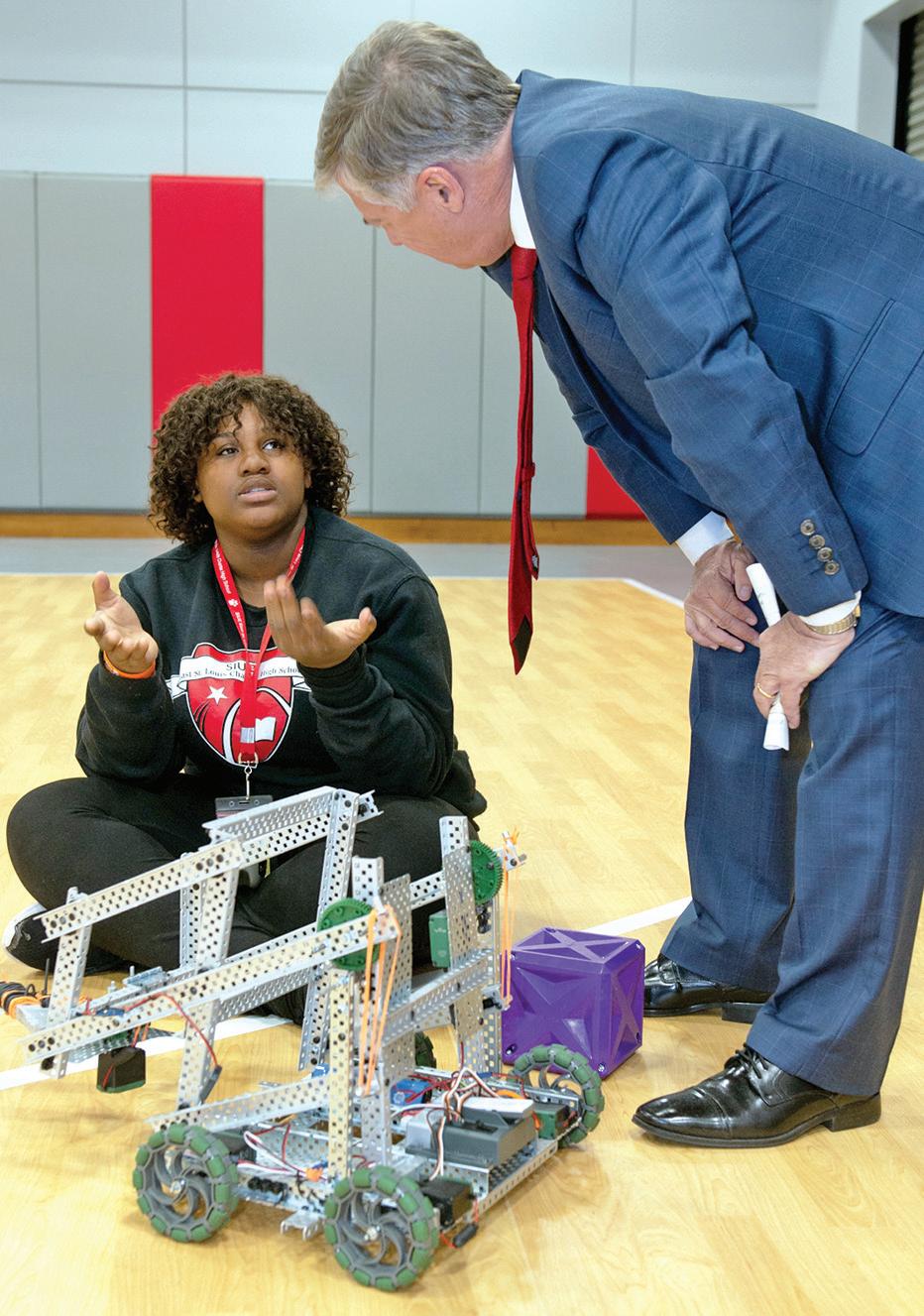
Project CommuniTree provides free trees to community groups for planting projects on public and nonprofit-owned land. Trees are grown at CommuniTree Gardens nursery, its volunteer assisted tree nursery in Creve Coeur Park. Trees are available on a firstcome, first served basis. Tree pickups will begin in March. For more information, visit http:// moreleaf.org/plant/steps-applyfree-trees/.
Violinists who are 16 to 26 years of age as of November 21 have until June 21 to apply for the Kosciuszko Foundation Wieniawski Violin Competition. Over $8,000 in monetary prizes along with other special awards are offered.
Distinguished violinist and a former member of the New York Philharmonic Orchestra Hanna Lachert serves as competition artistic director. The other judges include Grammy-nominated violinist Robert McDuffie and virtuoso violinist, composer, conductor and concert presenter Mark Peskanov.
The competition was established in 1969 to provide young musicians with an opportunity to further their creative development and to encourage them to study the repertoire of Polish composers. It honors Henryk Wieniawski (1835-1880), Poland’s legendary violinist and composer, one of the greatest violinists of the Romantic era.
For more information and to apply, visit www.KFWieniawski.org.
By Malaika Horne For The St. Louis American
As Missouri’s legislative session opens, this is a great time to discuss closing the pay gap, a public policy issue deserving urgent attention.
Also known as Equal Pay for Equal Work, it addresses the fact that men, particularly non-Latino white men, make more money than women doing the same work with comparable experience.
The struggle for wage equality has received much attention and indeed has been a long hard slog. et women are still being shorted the money owed due to blatant gender bias.
African-American and Hispanic women have the largest wage gap. They make 64 cents and 57 cents, respectively, to a white man’s dollar; white women make 78 cents.
Women represent 51 percent of the labor force, and African-American women make up more than 53 percent of the black labor force.
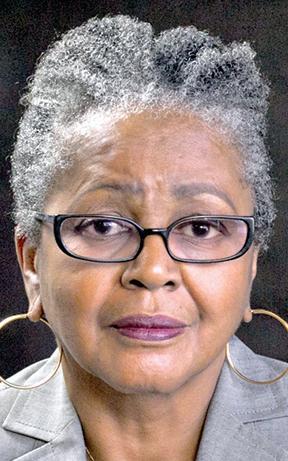
Some may be surprised to learn that AsianAmerican women make the most, 87 cents. But bear in mind that Asian-American women are only about three percent of the U.S. population. Missouri generally mirrors these national figures.
African-American men also experience pay gaps in relation to their white male counterparts, but black men still earn more than black women doing the same work. Even African Americans may find this surprising. The old saw that black women are freer than black men could contribute to this thinking. This myth has been debunked on numerous occasions and needs to be laid to rest once and for all
State Senator Karla May (D-St. Louis) recently filed a bill seeking to rectify these pay differentials. Senate Bill 682 addresses “provisions relating to employment practices based on gender.” May assumed office in 2019, representing District 4 of St. Louis city and county, having served in the House until 2018. She
has not let grass grow under her feet. However, this issue needs a full-court press with a broad base of support to make sure that this bill becomes law. Because there are racial and gender structural barriers for black women, they are hardest hit. Many are concentrated in low-paying jobs, trapped in a cycle of poverty, consequently relegated to a permanent underclass. They are triply oppressed by class, race and gender and knocked out by a one, two, three punch. But – get this – men earn more in traditional women’s work (undervalued and underpaid) such as servers (waitresses), teachers, administrative assistants (secretaries) childcare workers, social workers and healthcare. Professional women are not spared. For example, women college professors –even physicians, including surgeons – experience pay gaps. Hence all women lose, driving home the point that economic justice for all is a civil rights issue. Furthermore, our livelihoods are increasingly dependent on women’s wages as they are the primary or co-breadwinners in more than 60 percent of American households.
Women are well-springs of resilience and resistance, but they can’t do it alone. That’s why we applaud and support Senator May for her forward-thinking leadership. Groups such as the American Association of University Women (AAUW ) and the Women’s Foundation of Greater St. Louis (WFSTL) along with others have joined to push for pay equality and Senator May’s legislation. AAUW has been campaigning for this right for decades. It’s now time to get solidly behind this critically important issue for women to get paid like everybody else and receive what they deserve.
Co-written with the AAUW/WFSTL Pay Equity Working Group. Malaika Horne is an academic writer, book author and journalist, who writes extensively on topics from politics, health, social causes to women’s issues.

proposes to build the $20.5 million hospital project at the site of the former Pruitt-Igoe housing project, and it’s set to receive $8 million in public funding.
“In this Black History Month, I think that it’s most important we educate people about the legacy and the meaning of our culture,” Thompson said. “We are 1,000 percent opposed to Paul McKee stealing the name of this legacy.”
From 1937 until 1955, Homer G. Phillips was the only hospital of scale for African Americans in St. Louis. It continued to serve largely the AfricanAmerican community after desegregation, and it was the first teaching hospital west of the Mississippi River for black students. By 1961, Homer G. Phillips had trained the largest number of black doctors and nurses in the world.
The coalition opposing McKee’s name for the hospital includes those who stood side-by-side in the protests in 1979: the Organization for Black Struggle; the Coalition for Black Trade Unionists; The Campaign for Respect, Fairness and Human Dignity; and the Homer G. Phillips Nurses Alumni Inc.
Since the beginning of the year, the coalition leaders have been requesting a meeting to talk “respectfully” with the developers, they said.
Alderwoman Tammika Hubbard (D-Ward 5) — who sponsored the legislation for the hospital’s public subsidy — has “angrily” refused to sit down with the former nurses and doctors of the institution, coalition leaders said. McKee also has not returned their requests for a meeting.
Some are wondering why U.S. Rep. Wm. Lacy Clay, who has a working relationship with McKee and represents the area, has been so silent on the issue and has not helped to orchestrate a

by
A major traffic jam that lasted an hour took place on Monday, Feb. 17 at Natural Bridge and Kingshighway when the BP station at that location gave out free gas for a while.
meeting for the coalition.
One of those people asking the question is Cori Bush, who challenged Clay in the last election and will challenge him again in the August primary.
“The people are saying, ‘We are the ones on the frontline, and this is our voice,” said Bush, who is also a nurse. “I stand in solidarity with the doctors and nurses and community members to say, ‘No.’ I would love our congressman to stand with the people and not with his buddies.”
The American reached out to
Clay twice about the issue, and his spokesman said the congressman was traveling. Bush said she remembers her grandparents talking about Homer G. Phillips Hospital. If McKee wants to pay tribute to this legacy, he could do it in other ways, she said.
“He could pay tribute by taking care of his properties,” Bush said. “Pay tribute that way.”
McKee’s proposed hospital will be located within his NorthSide Regeneration development
footprint, which covers much of North St. Louis and was originally awarded a $390 million TIF in 2009.
In June 2018, city officials attempted to end the development agreement for the NorthSide Regeneration project. The default notice that the city issued to McKee stated, “After a decade, the promised redevelopment has not come, nor is there any indication that it will.”
Now McKee and the city are in an ongoing legal battle over the default notice. Thompson said that what’s

even more concerning to her than the name is the fact that project leaders have not been able to confirm that the facility will be able to accept Medicaid or Medicare — despite the hospital being located in the middle of one of the most impoverished and medically underserved areas in the region.
Freestanding emergency departments — which is what project leaders have called the proposed facility — are not recognized by the federal government and cannot accept Medicaid and Medicare. In fact, studies have found that freestanding emergency rooms end up costing patients more than
Continued from A1
co-organizers of the marches.
“That’s where the heroin is being sold. That’s where our people who are trapped in addiction walk. It was chosen because it has all of the social ills present that we must stop ignoring. And we chose it to do it at night, because that’s going to take some bravery.”
As part of Black History Month, the coalition will reflect on Dr. King’s legacy through an “aggressive call” for nonviolence for the final week of February. Organizers are calling for individuals to embrace strategies for promoting peace, both internally and externally.
First, they request that people open each day with prayer and meditation. Then, they lay out guidelines for more peaceful interactions: speaking to people you pass, helping those in need each day, and avoiding arguments and debates. Finally, they suggest that participants “embrace heritage and accept current internal challenges.”
Clark is leading the effort with Marty K. Casey, actress and owner of the Show Me Arts Academy.
Other organizations involved include Feed the Families Inc., iHeartRadio, the City of St. Louis, CrimeStoppers, the Spirit of St. Louis professional basketball team, and churches on both sides of the river.
“The larger vision here is to tie this call for peace into Black History Month,” said Clark. He said that while the Civil Rights Movement addressed external challenges, the anti-violence movement he envisions is more geared towards addressing violence within the black community. These marches will be part of a larger effort to reflect on violence, Clark said – “what we do to each other and how we do not support each other. And we cannot leave that to another generation.” Casey highlighted the
standard emergency room fees.
“There are some serious issues with credibility,” Thompson said. “A facility in North St. Louis City that doesn’t accept Medicaid? What kind of nonsense is that? We have real serious concerns that the naming seems minor in comparison.” Bush, who was a frontline Ferguson protestor, said she plans to stand behind the coalition in any actions they plan on holding.
“Let’s make some noise,” Bush said. “Let’s make sure we are heard. If they are paid to represent us, you can’t represent us by putting your hands over our mouths.”
importance of bringing together several sectors of the community to address violence.
“We understand that the only way we’re going to bring the community together is by coming together with all organizations, all hands on deck, at a table that’s big enough to include everyone,” she said. “It’s really about being inclusive.”
As the owner of an arts academy, Casey’s vision of that inclusivity requires that children be just as engaged as adults. This march, she believes, could teach young people the importance of mobilizing for a cause.
“I believe that’s something that has to be taught,” Casey said. “This would be a missed opportunity if we didn’t bring them to be a part of this march.”
One of those children, she said, is a nine-year-old gun violence survivor who will be speaking at the St. Louis march and receiving an award for his advocacy from Jefferson City.
“His mother was shot and killed in August 2016, [when] he was 5 years old,” Casey said. “His mother was shot and killed in front of him. This young man, now, has been an advocate for the community, and we need to know him, we need to support him, to stand up with him. We need to unify because of him.”
Clark and Casey hope to use these marches to galvanize people away from research and towards action.
“We’ve studied the crisis long enough. The root cause of crime and violence is poverty. That’s what 15 years of research has taught us,” Clark said.
“It would take five generations to address poverty, at least five generations. We don’t have five generations. But what we can do is, St. Louis can make a decision: we’re going to take a deep dive, we’re going to invest in the future in a substantial way. That’s where we are right now. We’re at a very critical crossroads.”
and criminal justice, in order to “ensure protection of the constitutional and other legal rights of all members of the community, improve Ferguson’s ability to effectively prevent crime, enhance both officer and public safety, and increase public confidence in the Ferguson Police Department.”
Now, four years since the decree was implemented, it is unclear when all 37 provisions it entails will be fully complete. As of last year, the municipality was at least partially in compliance with 36 of them. On Wednesday, February 12, representatives of Hogan Lowell, the law firm which staffs the independent Consent Decree Monitor team held an open meeting where residents gathered to ask how things were progressing.
While police training and community-police engagement were lacking, Tidwell stated in her most recent report on January 31 that most of the court-related provisions of the Consent Decree have been successfully implemented.
“Significantly, at the close of 2019, the city reported its near total compliance
Continued from A1 nationwide. It’s a case dredged up by St. Louis Circuit Attorney Kimberly Gardner’s Conviction Integrity Unit.
Twenty-four years ago, Johnson was convicted of murdering Marcus Boyd on October 30, 1994, though evidence shows that Johnson was at a friend’s house and would not have been able to commit the crime. He was sentenced to life in prison without the possibility of parole.
with the Consent Decree’s Comprehensive Amnesty Program (“CAP”),” they announced.
This program has allowed at least 3,000 people to get out from under outstanding warrants for things like traffic violations — the type of finebased policies that used to fund up to a quarter of the municipality’s budget. With regards to aspects of police department policy such as, for example, maintaining an up-to-date policy manual or creating a committee dedicated to training officers, the work is not yet complete.
For the remainder of the fourth year since the Consent Decree, Ferguson will be pursuing two main goals: first, to incorporate a series of best-methods trainings into police department work, and then to work more seriously on community engagement between the police and the people of Ferguson.
The bulk of the trainings, Tidwell explained, will be short protocol adjustments carried out during roll call. Although she suggested that many of these trainings would be open to the public at the City Council meeting, she was less certain the following day.
“Whether the police department would invite people to come to roll call to view
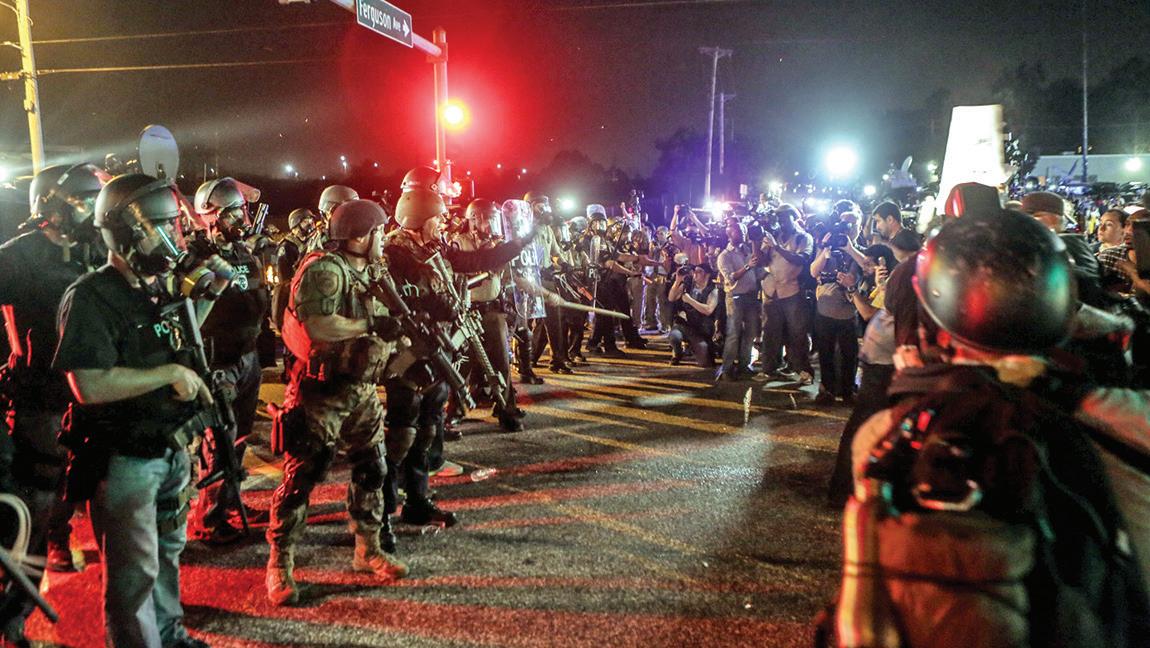
the new policies, that is their decision to make,” Tidwell said. “Or whether or not, if a new policy is developed and the Civilian Review Board wanted to have its own briefing on a particular policy that’s been implemented, I think there could be a discussion between the CRB and the police department about having a similar briefing for the CRB.”
Jean Franks, a member of the Civilian Review Board, pushed for the CRB to have access to the trainings in order to do their job of handling
police complaints.
“We have a role in making sure that the police department understands the policies, is involved with the policies,” Franks said. “How do we understand what they have gotten in the trainings, and what they have not?
Because there can be a lot of miscommunication if we’re not included in that actual training. If we get a complaint, if we don’t already understand it, how do we know how to respond?”
The Consent Decree monitor
recommended that the city hire a full-time engagement or outreach coordinator, as this is “critical to not only achieving substantial compliance with the Consent Decree, but to achieving a sustainable, community-oriented approach to policing that fosters trust and transparency within Ferguson.”
That work on outreach, along with the roll-out of the police training plans created this past year, is projected to take up much of the remainder of this fourth year.
While many residents
are frustrated that the city’s compliance with Consent Decree reforms are not progressing fast enough, some members of city government assert that the amount of money required to comply with the decree is so great that the municipality may dissolve.
In early January, interim City Manager Jeffrey Blume said that Ferguson is spending so much money – about $1.1 million so far – on complying with the Consent Decree that the city may end up financially insolvent, according to the Associated Press.
For resident Cassandra Butler, the main question is where the money is going, and whether it’s accomplishing the goals set out in the decree, as she explained in City Council the day before the consent decree monitors’ meeting.
“I see the council continues to make decisions that lead towards furthering efforts of amassing power instead of making the best decisions for the city,” Butler said, “and in that way I see this as being on a trajectory – the council being on a trajectory of trying to bring the future back to the past.”
Tidwell said that her goal is not that at all, but to keep Ferguson moving forward into the future.
In July, Gardner’s prosecutors asked Circuit Judge Elizabeth Hogan to set aside Johnson’s 1995 murder conviction. Gardner’s team alleges that former prosecutors and police fabricated evidence to get the conviction.
County Prosecuting Attorney Wesley Bell, who have also established a Conviction Integrity Unit.
Hogan brought in Missouri Attorney General Eric Schmitt to represent the state, which is what voters elected Gardner to do. Schmitt has argued all the way to the state’s highest court that Gardner doesn’t have the authority to ask for a new trial if she thinks an innocent person has spent more than two decades in prison wrongfully.
The Missouri Supreme Court’s ruling in the Johnson case would impact other prosecutors throughout the state, including St. Louis
“If allowed to stand, this decision would not only leave Lamar Johnson behind bars, but create a severe barrier to justice for any person wrongfully convicted in Missouri by blocking the ability of prosecutors to ask courts to remedy such cases, thus rendering all conviction integrity efforts across the state null and void,” said Bell, a signatory to the brief.
Through 2018, Conviction Integrity Units have been responsible for producing 344 exonerations nationwide, according to the brief.
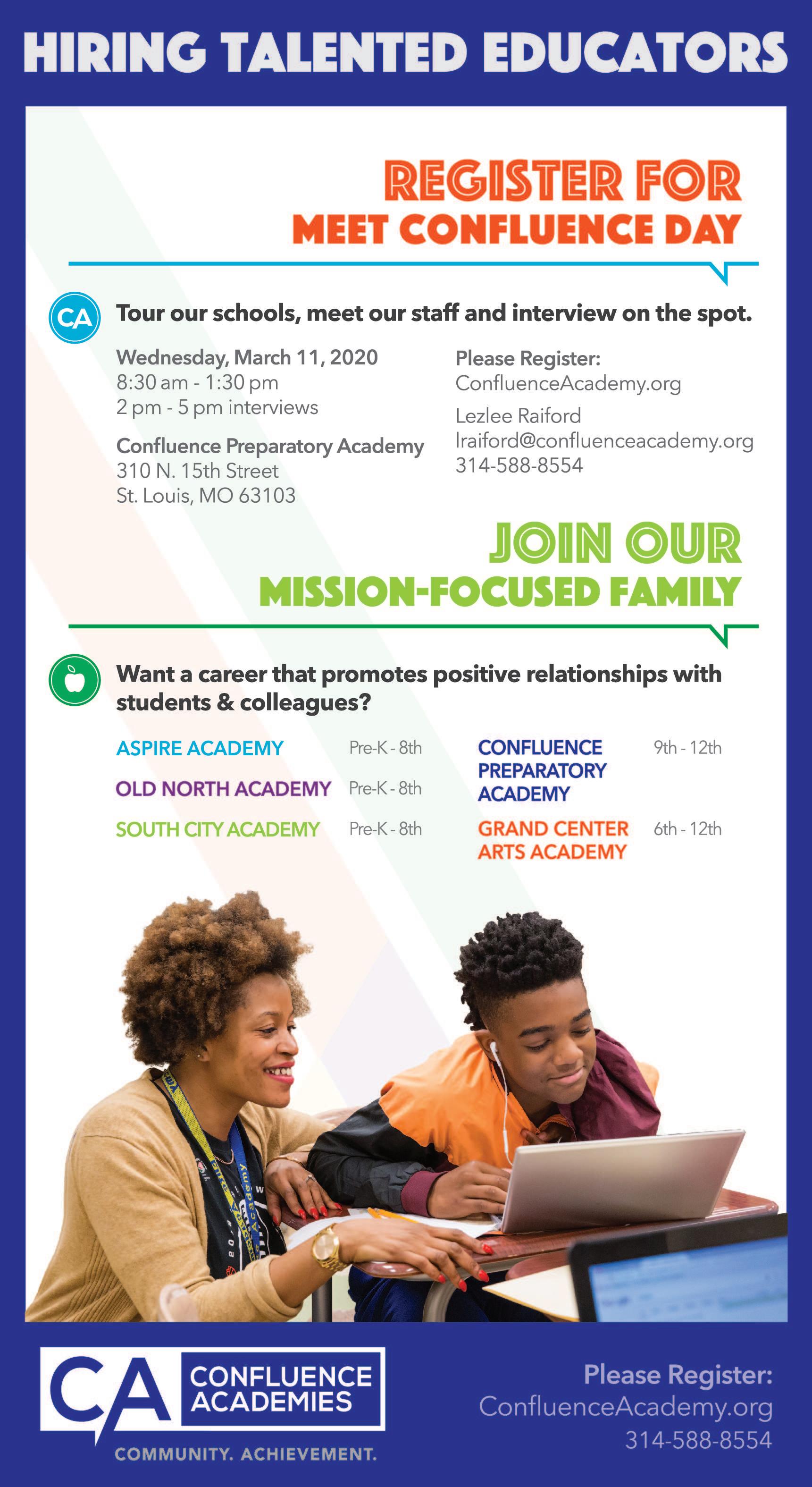
“A loss in this case could also send a message to those who are trying to undermine the work of elected prosecutors nationally who are looking to increase accountability,” said Miriam Krinsky, executive director of Fair and Just Prosecution. “And it could embolden those who are trying to push back on these reformminded leaders.”
The brief argues that nationally Conviction Integrity Units have grown into a “recognized benchmark” for local prosecution offices, and they are now “well-settled vehicles” for reviewing and seeking to overturn convictions when there is evidence of actual innocence or misconduct
by prosecutors or law enforcement. By the end of 2018, such units operated in 44 jurisdictions across the country, including in many of amici’s own cities and counties.
“Although prosecutors serve as legal representatives of the state, they are not onedimensional advocates charged with obtaining convictions and resisting the reversal of a wrongful conviction at all costs,” the brief states.
Gardner has faced fierce resistance during her tenure as prosecutor, and she recently filed a civil rights lawsuit against the City of St. Louis, the St. Louis Police Officers Association and other individuals. The lawsuit argues that the resistance and attacks aimed at ousting her from office are racially motivated. The pushback to Gardner’s Conviction Integrity Unit is a reflection of the pushback she is facing, one signatory said.
“Allowing politics to determine whether relief is granted or denied in a case where there are credible claims of innocence and serious concerns about prosecutorial and law enforcement misconduct is unconscionable,” said Andrew Warren, state attorney of Florida’s Thirteenth Judicial Circuit, another signatory to the brief. “This is a matter of justice for Lamar Johnson and the integrity of our system.”

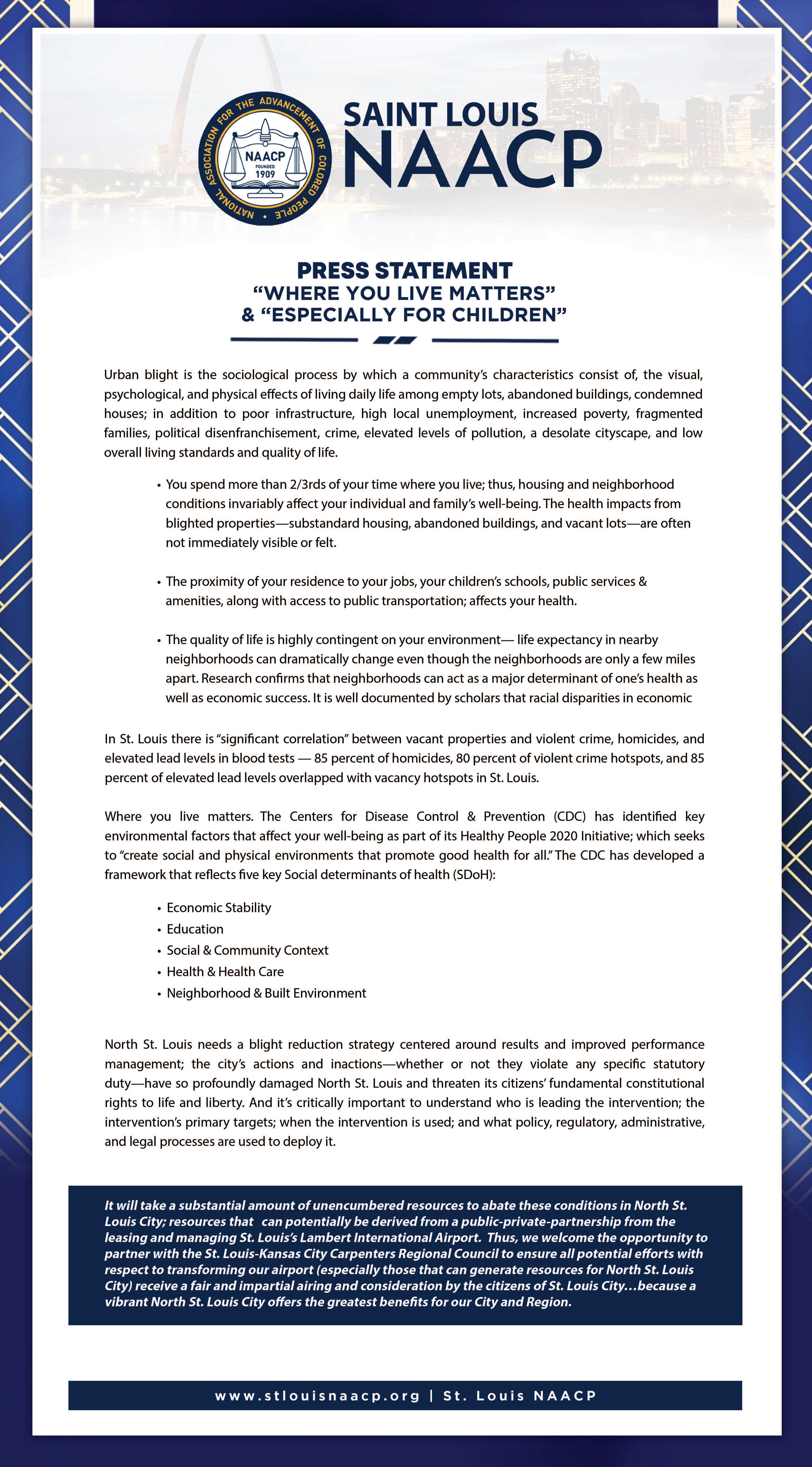
This open letter was submitted by the undersigned 31 residents of St. Louis County. With the recently announced retirement of our current St. Louis County Police Chief Jon Belmar in April, we turn to our Board of Police Commissioners and its Chairman William Ray Price Jr. to help us set the intention for how St. Louis County will be led in matters of law enforcement. It is our recommendation, as members of the St. Louis County community, that the best, most qualified candidate for the position is Lt. Col. Troy Doyle. Lt. Col Doyle is the most qualified and experienced candidate for the position. He has shown, in over 28 years in law enforcement, the ability to lead officers from all over St. Louis County. He has been a commanding officer in the North County and South County precincts with real success establishing and building respect and rapport. not only within the ranks of his officers but also within the greater community.
He is the founder of the St. Louis County PAL (Police Athletic League), which builds character, helps strengthen police-community relations, and deters children from becoming involved in criminal activity. He is also the current president of the St. Louis Chapter of NOBLE (the National Organization of Black Law Enforcement Executives), which has a goal to ensure equity in the administration of justice in the provision of public service to all communities. These are the kind of qualities needed to continue to build public trust in the police throughout the county.
Lt. Col. Doyle is well prepared to lead on day one as he has already been in integral leadership roles during the majority of his time with the department. In 2011, he served as interim police chief and commander of the City of Jennings Detail, where he was an agent of change and successfully implemented policies and practices to move the organization in a new direction. Those policies resulted in a 30 percent reduction in crime. He has been commander of the
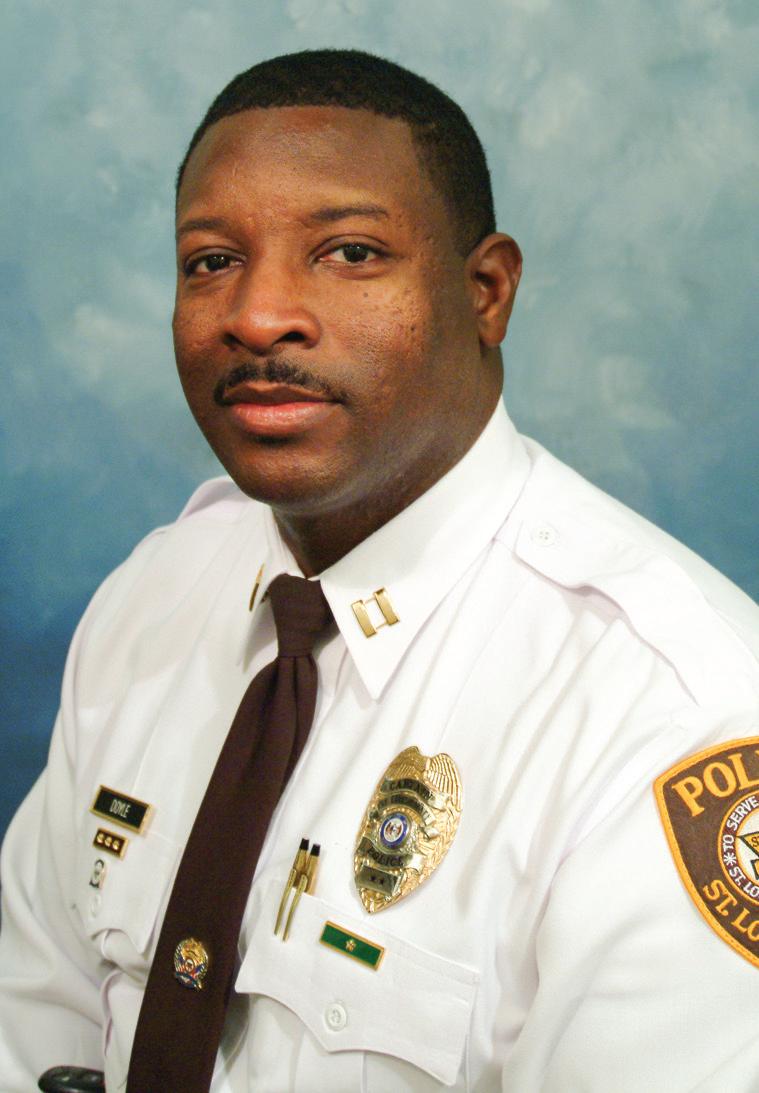
need. Lt. Col. Doyle has said that “learning and listening are among my first priorities.”
It is this thought process that makes him most effective in building culture. That kind of thinking grows from his many years of training and personal and professional development, including earning a Bachelor’s degree in Criminal Justice from Lindenwood University and being a graduate of the 245th session of the FBI National Academy.
Lt. Col. Doyle is the person we need leading our police department this year and beyond. He is a family man, a respected officer and leader
in the community. There are no other options as qualified as him, and we implore you to make the correct choice for our region and appoint Lt. Col. Doyle as chief of police.
Signed, Jennings Councilman Terry Wilson, Jennings Mayor Yolanda Austin, Jennings Councilman Gary Johnson, Jennings Councilman Alan Stitchnote, Hazelwood School Board Director Mark Behlmann, Dellwood Mayor Reggie Jones, Bellefontaine Mayor Tommie Pierson Sr., Bellefontaine Alderwoman Alease Dailes, Beverly Hills Mayor Brian Jackson, Rodney
North County Precinct and commander of the Criminal Investigation Division. Currently, in his role of commanding officer of Operational Support, he is responsible for the overall operation and management of the Communications, Central Police Records, Computer Services, County Municipal Police Academy, Emergency Communications Network, and Personnel Services work groups. This means he has effectively had success within the department in positions in the field and in administration. The variety and elevation of responsibilities in his career have unequivocally prepared him for the next step of leading the entire department.
Outside of his success in Jennings, he was also appointed to serve as interim director of St. Louis County Justice
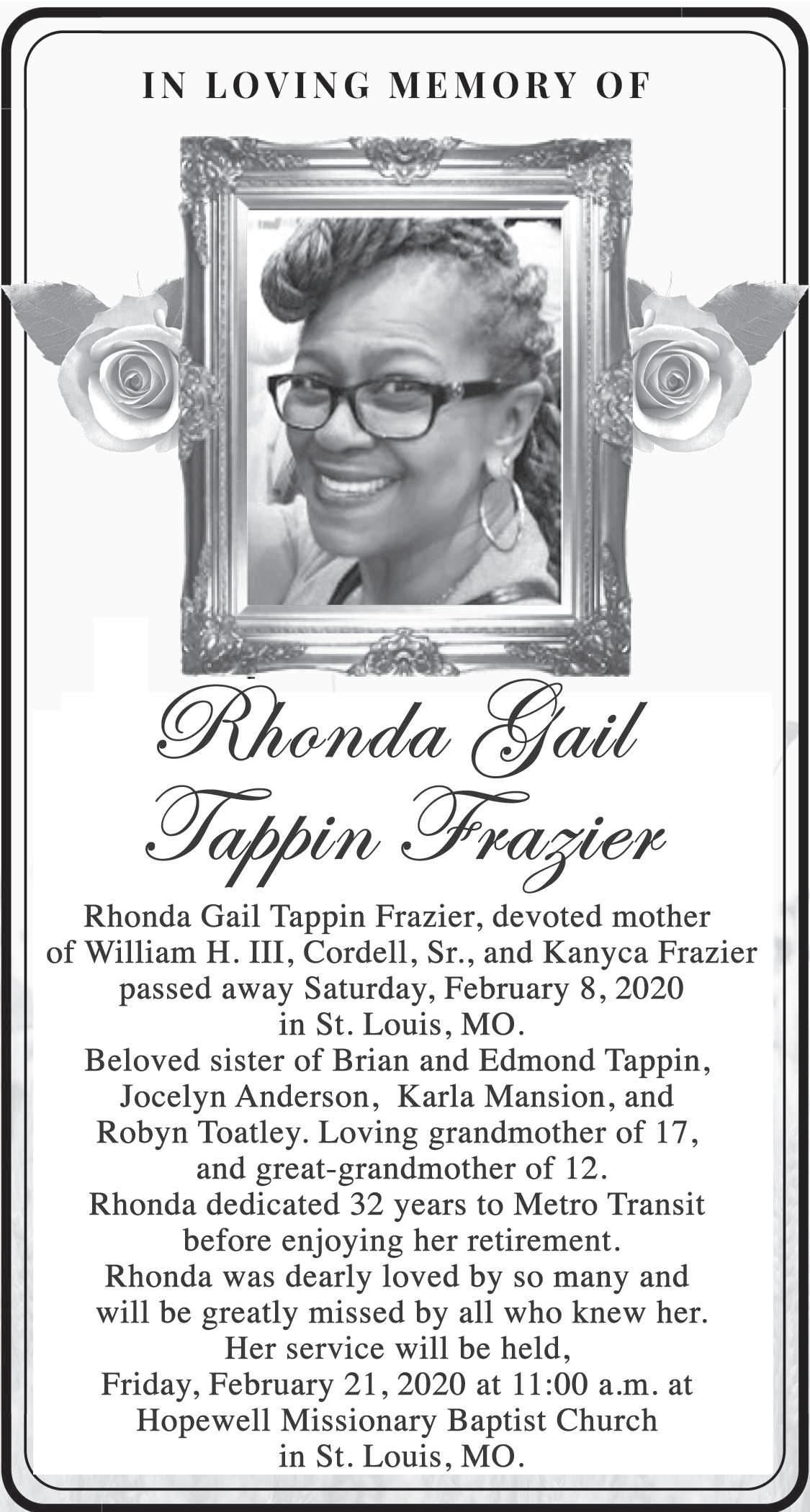
Services and was able to stabilize and turn that division toward success while in that role. He has, over his career, been looked to as a problem solver, someone who can provide leadership in areas and times of


th 2019 Honoring


Forms can be emailed to Kate Daniel at kdaniel@stlamerican.com or emailed to 2315 P

Former Mayor Vince Schoemehl is going full throttle in support of 20th Ward
Alderperson Cara Spencer who recently announced that she is going to run for St. Louis mayor in 2021. Vince was a strong supporter of current Mayor Lyda Krewson, St. Louis’ first woman mayor, but since Lyda teamed with then-St. Louis County Executive (now federal inmate #REDACTED) Steve Stenger to remove him from the Bi-State board, Vince developed an acute but common political virus called buyer’s remorse. (One only wishes that Rex Sinquefield was less stratospherically wealthy and could catch some buyer’s remorse and revisit his political investment strategy.)
The Spencer campaign for mayor is Schoemehl’s second attempt at payback on that mayor-county exec team that diminished his political relevancy by dumping him from the Bi-State board. He also supported Mark Mantovani’s close but failed attempt in 2018 to beat Stenger. The EYE obtained an email that Schoemehl sent to an African American influential in the region. The pitch is an interesting indicator of what to expect in this campaign, at least from Schoemehl. The payback may be to Krewson, but clearly he anticipated a black candidate whom Spencer will have to beat. St. Louis Treasurer Tishaura O. Jones is seeking reelection and has not responded to questions from other media about running for mayor, but
Schoemehl and Spencer know that Jones forged a multi-racial progressive coalition to come within beating a white status quo candidate (and the only white candidate in a crowded field) by only 888 votes.
Schoemehl going directly after a black influential on Spencer’s behalf suggests his belief that the multi-racial progressive coalition will be up for grabs.
“Cara is a white woman running for mayor in a city that’s about half black,”
Schoemehl. “But she’s got experience and demonstrated success and in representing the interests of black people, really all her constituents. Cara represents the 20th Ward in South City, which is about 70 to 75 black.”

Schoemehl goes on to point out to this black influential that Spencer has beaten a black woman candidate before.
“She ran for reelection last year and faced a young black woman, who was very capable, very well educated, very articulate and who had worked as a community organizer for the neighborhood organization for a couple years,” Schoemehl.
“Her opponent knew the neighborhood. Cara carried that election with 70 percent of the vote. Why?”
Schoemehl offers an answer.

“Because people – black, Hispanic, white – knew Cara and they knew her work. We’re living in times where leaders can create a new future and this has to be done by people of good will and sturdy character, and I believe Cara fills those requirements.”
The EYE offers an alternate answer to why? In that election, Spencer raised and spent more than $62,000 and got 660 votes in this ward that is 70 percent to 75 percent black.
Bill “Archie Bunker” McClellan has dubbed Tishaura Jones the “shadow mayor.” In this Schoemehl spiel, Jones is the phantom candidate whom this Spencer surrogate is crafting friendraiser appeals around.
Schoemehl ends his pitch on a more naked appeal for the multi-racial progressive coalition to give a white

candidate a chance: “Our community – the city and the entire region – need new generation leaders and they will come from all walks of life, and races and all backgrounds. We’ve just got to empower leaders like Cara to create the future well all want and desperately need.”
Revenge of the zombie
Tishaura Jones may have been drafted as a phantom mayoral candidate by Schoemehl, but that’s nothing in Missouri today. We also have a phantom gubernatorial candidate – who is also a zombie.
Ladies and gentlemen, newly risen from the political grave, meet Eric Greitens. He resigned from office, of course, when the state Legislature deadline for subpoenaed campaign fundraising documents was due and St. Louis Circuit Attorney Kimberly Gardner was pressing charges against Greitens for allegedly committing the felony of invading someone’s privacy by taking an unwanted picture of someone and storing it in a way that could transmit it electronically.
Gardner’s dropped charges are old news, but Greitens was zombie walking to the tune of a news opportunity, the Missouri Ethics Commission concluding its review of his campaign by issuing a fine rather than an indictment. Greitens spent thousands over the weekend on Facebook ads promoting his so-called “total exoneration.” This is like a bank robber bragging about being exonerated when a municipal police department dismisses a speeding ticket he got while driving the getaway car during the police chase. In other words, the Missouri
Ethics Commission didn’t even address any of the crimes with which Kim Gardner had charged him or the state Legislature was investigating. Greitens distorted the MEC’s finding against him, which in fact resulted in one of the largest penalties in state history – a $178,000 fine. The fine – which Greitens signed a statement agreeing to – was a result of illegal coordination between his campaign and a third party, to the tune of roughly $6 million expended by the third-party group. Greitens had previously denied any knowledge of such coordination in representations to the MEC. Covering up coordination with a third-party group – involving far smaller amounts of money – has earned others felony convictions and even time in the joint. Yet Greitens is crowing “total exoneration.”
Greitens let loose one real howler of a line in his social media post. “Many people have asked about revenge,” Greitens said. “That’s not what we need. Revenge is about the past. Justice is about the future. And, I’ll tell you, the future is bright.”
That “the future is bright” is just zombie smack talk: watch your shadows, Mike Parson and Josh Hawley. But the high-minded shrugging aside of revenge is hilarious to anyone following the hell that Gardner and the investigator she employed on the Greitens case, William Tisaby, have been catching from Greitens’ legal team he engaged to defend himself. The proper statement would be “some people have been reporting in detail about my revenge.”
Mantovani’s money
By the way, has anyone asked Mark Mantovani how he feels about Greitens using some
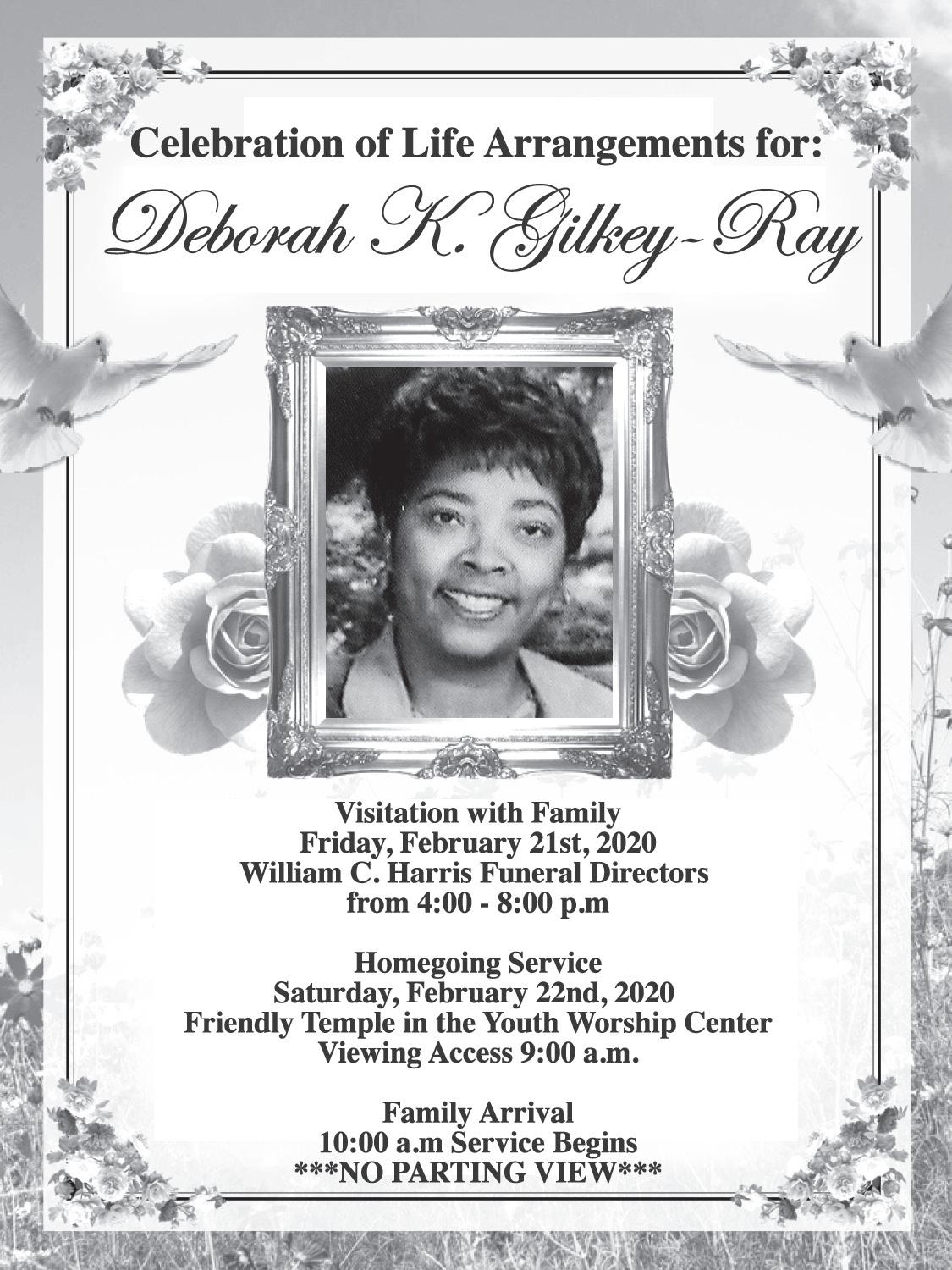
of the dough leftover from Mantovani’s $20,000 campaign donation to pay off the MEC fine? Mantovani will now have a chance to fund his favorite candidate, himself, as he has announced his second run for county executive.
G-men in Jeff City
Jefferson City is crawling with G-men interested in the state’s process for awarding medical cannabis licenses. This could be a sleeper issue for Nicole Galloway vs. Governor Parson, whose administration is handling the licensing. If the G-men are smelling anything other than good medical-grade skunk bud, this could Galloway a bump she needs badly, based on current polling. On the other hand, if Missouri voters find a ballot initiative to expand Medicaid in November, and if they approve it as they approved a raft of progressive indicatives last cycle – and if they actually vote for the candidate who embraces such progressive policies (Galloway) and reject the candidate who rejects them (Parson) – then Galloway would need no bumps to win.
Good old cowboys
As a break from all of this scary stuff, all these phantoms and zombies, revenge fantasies and criminal investigations, we have another Republican candidate in Raleigh Ritter Mr. Ritter bills himself as a cattle rancher, 2nd Amendment advocate and anti-abortion stalwart. That means Missouri now has two Republican candidates who farm cows and want guns but no abortion rights, as the incumbent, Mike Parson, who came to office via Greitens’ implosion, counts cattle farming among his past lives, along with sheriff and state senator.
Sad move from Jake
It’s sad to see Jake Zimmerman, long admired as a progressive, running to the right of incumbent St. Louis County Executive Sam Page in his primary campaign. In a campaign email, Zimmerman quotes the odious PostDispatch editorial board doing its smarmy, unfair thing at Page’s expense. Zimmerman messaged that “unfortunately, the Post-Dispatch is right: “the county executive’s behavior resembles that of his predecessor: evasive, defensive, and the opposite of transparent.” Conflating Page with Stenger – a political criminal produced by the circus of the Post-Dispatch editorial board – is ridiculously unfair. For Zimmerman to campaign on it is very disappointing. The EYE wants to know now: Will Jake try to run to the right of Mantovani and Page, or just look for some daylight in between them?
Should student leaders receive harsher punishment over acts of youthful indiscretion, while officials and politicians receive mere slaps on the wrists or awards for their alleged actions or actual convictions? That question arose from what has become a local high school altercation gone wrong and captured on video.
In that video, cheerleading squads from East St. Louis Senior High and Trinity Catholic High of Spanish Lake are shown participating in a brawl resulting from a February 1 cheer-off in which each cheerleading team, alternately, performed dueling routines replete with taunts and putdowns of the opposing squad.
At one point, a Trinity cheerleader violated the space of the East St. Louis cheerleaders, leading to shoving, which devolved quickly into punches being thrown. The video was captured by City of Champions TV videographer Larry Duncan Allen and soon went viral, with over 350,000 hits at press time.
Both cheerleading teams have since been suspended according to Dan Grumich, president of Trinity Catholic High School, and East St. Louis Superintendent Arthur R. Culver, over mission and safety issues.
And while the extent of the punishment may be arguably extreme for one incident, one can’t argue that the incident was wrong; but that blame could also be passed along to the cheer coaches who put these young people into a scenario that they perhaps were too emotionally immature to handle.
Recall that Superintendent Culver also cancelled the ESL Senior High boy’s track season following a brawl during the Southwestern Conference

Championship boy’s track meet back in 2018.
But what of politicians and leaders, some being felons, who are convicted/ accused of actual crimes yet receive what amounts to a mockery of justice when it comes to their actions?
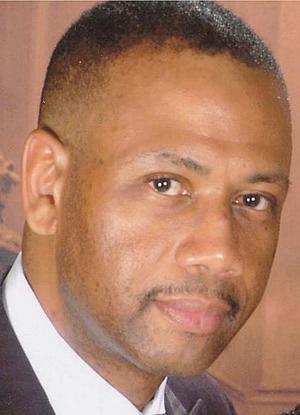
June Hamilton Dean, a former ESL official, was recently sentenced to a mere 30 months’ probation, a 10-year ban from public office, a $3,100 fine and 120 hours of community service after being found guilty of forgery and public contractor misconduct.
Despite the outcry from the ESL community, consisting of a letter writing campaign of over 100 citizens to Judge John O’Gara, asking for the maximum sentence, Dean was given what amounts to a slap on the wrist and a stiff-arm to an outraged public.
Joann Reed, the current mayor of Alorton, received a similar break after being removed from office back in 2013 following a guilty plea to a felony charge of smuggling a cell phone and food to her niece in the village jail. Reed was allowed to be reelected to the position because of a loophole in Illinois law that allows a felony to be erased if an “independent evaluator” determines the crime to be the result of substance abuse
and provided that the official completes drug treatment and probation.
Superintendent Culver was sued in 2019 (along with the ESL Board of Education) in a five-count federal lawsuit by fired employee Yvette L. Jackson, who alleged that Culver made sexually explicit remarks about Jackson and other school staff and made “repeated unwelcome advances.” Culver and the board members denied the allegation ESL NAACP president Stanley Franklin presented Culver with the “Education and Commitment” award during their 65th Annual Freedom Fund Awards banquet amid the scandal.
Why are our youth can be crushed because of their youthful indiscretions and bad decision making, while convicted felons and other officials, who are suspected of being involved in areas of potential felonious activities, can thumb their nose at the system and maintain their good standing or capacity to move on to their next political hook-up?
In communities like East St. Louis, cheerleading and athletics are often the very activities that keep students engaged and away from pitfalls such as teen pregnancy, drugs, gangs and other counterproductive lifestyles.
Likewise, these same teens see the mixed messages when felons, administrators and elected officials are acquitted, exonerated or given leniency despite their criminality and because of their political connections. It makes them become bitter, cynical and ultimately believers in the culture of entitlement that is the order of the day in ESL politricks.
Email: jtingram_1960@ yahoo.com; Twitter@ JamesTIngram.
Introducing Vivent Health, founded on the combined expertise of AIDS Resource Center of Wisconsin, Rocky Mountain CARES and St. Louis Effort for AIDS. And steadfastly dedicated to serving anyone and everyone affected by HIV through our comprehensive prevention, care and treatment programs. Learn more at ViventHealth.org


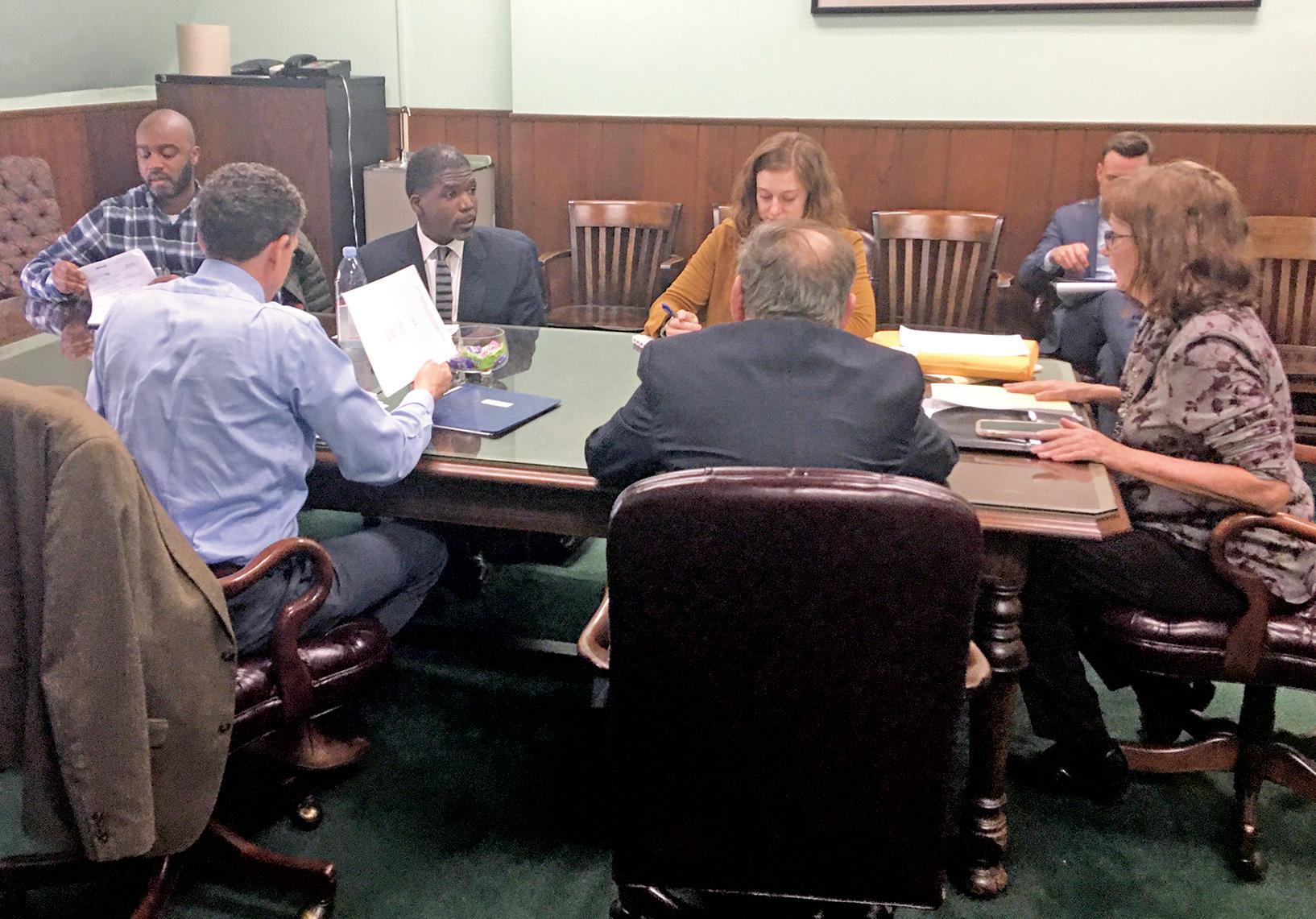
On Tuesday, February 11, a City of St. Louis selection committee chose Employment Connection to implement a Cure Violence site in the Wells Goodfellow/Hamilton Heights neighborhood out of eight bids responding to the Request for Proposals.
By Rebecca Rivas Of The St. Louis American
Employment Connection, a nonprofit that has long focused on reducing recidivism in ex-offenders, has won the contract to implement a Cure Violence site in the Wells Goodfellow/Hamilton Heights neighborhood. The site is scheduled to open on April 1. The Cure Violence model — which treats violence as an epidemic outbreak and therefore a public health issue — is active in more than 25 cities throughout the world. Cure Violence employs local residents with street credibility to prevent gun violence by de-escalating potentially violent situations before they happen.
On Tuesday, February 11, a City of
n “They met all the components of the program that are needed for proper implementation of Cure Violence.”
– Fred Echols, MD
St. Louis selection committee chose Employment Connection out of eight bids responding to the Request for Proposals.
On February 19, the Board of Estimate and Apportionment (E&A) — which is comprised of the mayor, comptroller and president of the Board of Aldermen —
approved the $750,000 contract.
Sal Martinez, CEO of Employment Connection, said he would withhold comment until the agency has an executed contract.
Employment Connection was founded in 1977 after a study by the Young Lawyers Division of the Bar Association of Metropolitan St. Louis (BAMSL) discovered that employed ex-offenders were 66 percent less likely to return to incarceration, according to the organization’s website. They assist about 2,000 people annually to find employment and focus on recidivism.
“They met all the components of the program that are needed for proper implementation of Cure Violence,” said
Doing away with Step 1 scores will hurt medical students from disenfranchised backgrounds
By Kenneth G. Poole Jr.
For The St. Louis American
When I was accepted to medical school coming out of Tennessee State University I knew very little about the long, arduous process ahead of me. Much like the community of HBCU collegiate faculty, family members, friends, and folks from my church home who were invaluable cheerleaders along my path, I thought the hard part was over. I was basically a doctor, right?
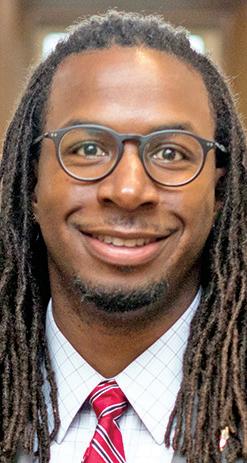
Wrong.
The reality was that the real work was just beginning. Medical school was full of challenges, obstacles, and hurdles that stretched me to the limits of what I thought was intellectually – and, at times, physically – possible. In addition to the immense volume of complex material and foreign medical jargon and nomenclature, I had to adjust to a socio-economic world I knew nothing about and unfortunately deal with some who thought I did not belong to be there.
Like virtually all medical students, the biggest academic mountain to overcome for me was the USMLE Step 1 examination. Known by all physicians as “Step 1,” the United States Medical License Examination Step 1 is the first of three examinations that are required to obtain a license to practice medicine.
Step 1 is routinely taken between second and third years of medical school as a rite of passage between the two classroom years of medical school and the two clinical years, where students rotate in the hospital. Step 2 is divided into two exams generally taken the fourth year of medical school, and Step 3 is normally completed following graduation in residency training. These are
The Missouri Nurses Association, Missouri’s largest association of registered nurses, has endorsed the ballot initiative that would give Missouri voters the choice to approve Medicaid expansion in the state.
“As nurses, we are on the front lines of healthcare delivery in the state of Missouri,” said Terry Reese, a family nurse practitioner in Branson and board president of the association, which has 2,803 members.
“So our members can see firsthand how increased access to health insurance will improve the health, well-being and quality of life for hundreds of thousands of hardworking Missourians.”
In a release, the association said the expansion would help provide health coverage to more than 230,000 uninsured adults in the state, bring more than $1 billion of in tax dollars to Missouri from Washington each
n “Our members can see firsthand how increased access to health insurance will improve the health, well-being and quality of life for hundreds of thousands of hardworking Missourians.”
– Terry Reese, Missouri Nurses Association
year, create thousands of jobs, boost the state’s economy and keep struggling rural hospitals open.
Thirty-six other states have moved to expand Medicaid in recent years, including See MEDICAID, A13

Guillory, a family nurse practitioner, provides care at Access Family Care Medical and Dental Clinic in Joplin. On Friday, February 7, the Missouri Nurses Association announced its support for a November ballot initiative that would expand Medicaid to an estimated 230,000 state residents who don’t now qualify.


“TakingCareofYou”
Continued from A12
Fred Echols, MD, director of the city’s health department, who is now leading the Cure Violence effort. “Looking at all the applications, this organization really spoke best about their ability to provide the services, as well as their history for providing the services for the City of St. Louis.”
On November 8, Mayor Lyda Krewson announced that the City of St. Louis Department of Health will lead the violence-prevention program Cure Violence, which is set to receive $8 million in city funds over the next three years. The Cure Violence sites — which target areas of about 15,000 people — will be located within approximately 10-by-10 blocks in the Wells Goodfellow/Hamilton Heights, Walnut Park and Dutchtown neighborhoods.
The selection committee will now issue RFPs for the next two sites in Walnut Park
By Chris King Of The St. Louis American
In a legislative report dated January 27, state Senator Ed Emery, a Republican from western Missouri, wrote that the Roe vs. Wade Supreme Court opinion legalizing abortion has had effects “surpassing the barbarism even of slavery.” It prompted the Missouri Democratic Party to respond.
“Comparing healthcare to slavery is not only disingenuous and irresponsible, it fundamentally ignores the systemic horrors that have and continue to plague African Americans today,” the Missouri Democratic Party said in a statement.
this only reopens the wounds for generations still fighting for equality. Senator Emery should immediately apologize and recant these statements immediately.”
Instead, Emery doubled down.
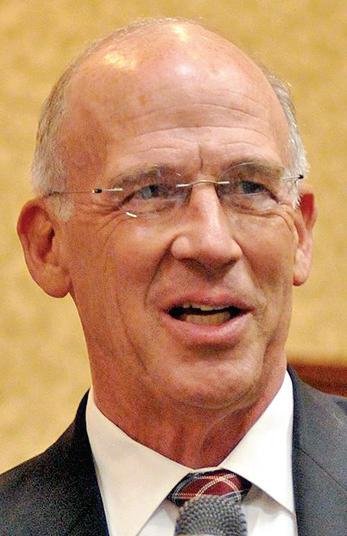
State Senator Ed Emery
“It’s a shame that Senator Emery, who has the honor of serving on the Committee on Education, would so blatantly diminish the cruelty and gruesomeness that was America’s original sin. It was not so long ago that discrimination was completely legal, and downplaying the lasting effects of slavery like
Continued from A12
neighboring Arkansas, Illinois, Iowa, Kentucky and Nebraska. Expansion efforts are also
Continued from A12
separate and distinct from the board examinations physicians must take to obtain board certification for specific medical specialties following residency training. I had no clue that any of this existed prior to medical school.
Of the three, Step 1 is by far the most important. In fact, one could argue that Step 1 is the most important test that physicians take throughout their journey from high school through retirement. On the surface Step 1 is an examination that simply assesses basic medical knowledge that is foundational to patient care. Between the lines, however, Step 1 scores are used by residency programs to evaluate and screen applicants for coveted residency training slots.
At the start of medical school, I thought medical students picked their eventual specialties in the same manner that college students choose a major or minor area of concentration. Once again, wrong.
“Slavery was about dehumanizing an entire people group to make life more convenient for those responsible for creating that group,” the legislator emailed to KCUR. “Abortion is about dehumanizing an entire people group – the pre-born for the convenience of those responsible for creating that group – parents.”
Nimrod Chapel Jr., the president of the Missouri NAACP State Conference, told KCUR that Emery’s remarks were “ludicrous” and “disconcerting.”
“Any comparison of slavery to anything else is inappropriate,” Chapel told KCUR, “and really shows a complete lack of understanding of the issues faced by generations today as a result of that legal system.”
underway in Kansas and Oklahoma.
An expansive body of research shows that Medicaid expansion will not just save lives but could also save taxpayers money, the association noted. Researchers at Washington
I also was not aware of the income variability amongst physicians. All physicians do not make the same amount of money, do not have the same lifestyles, and are not afforded the same opportunities for career advancement. Medical specialty and employment dictates much of that. Per a 2018 Merritt Hawkins report, the average starting salary for a family medicine physician is $241,000; the average starting salary for a radiologist is $371,000; the average starting salary for a gastroenterologist is $487,000; and the average starting salary for an orthopedic surgeon is $533,000.
It should also be noted that there is great variability in debt burden attributed to the astronomical costs of medical schools, with many students graduating debt-free and many graduating with upwards of $300,000 in student loans. As one can imagine, there is a great deal of competition for residency spots in highpaying specialties and at prestigious institutions, and politics, favoritism and bias are scattered throughout the process.
and Dutchtown.
On October 4, the Board of Aldermen passed a bill to approve $5 million for Cure Violence over the next three years. On September 17, the Board of E&A approved $1.5 million for the program, and the Board of Aldermen approved $500,000 in July as part of the regular budget process. Board President Lewis

University in St. Louis have shown that expansion could save Missouri more than $1 billion by 2026 by reducing many of the healthcare costs the state now pays. And a new analysis by Health Management Associates
With that said, the raw, exposed truth is that physician specialty selection is predicated upon Step 1 scores, nuanced extracurricular activities, medical school performance, medical school reputation, and letters and phone calls that vouch for students. Of those, Step 1 scores are clearly the most objective measure.
As a physician who holds a master’s degree in business administration and who has spent a considerable amount of time doing medical school admissions, I know a little something about standardized tests. As an African-American male physician who holds a master’s degree in business administration and who has spent a considerable amount of time doing medical school admissions, I’m more than fine stating that there is inherent cultural bias in standardized testing, which all too often puts racial and ethnic minorities at a disadvantage, particularly
Reed said the city will have a couple of years to secure the last $1 million — for a total of $8 million.
The Cure Violence funding bill states that there have been 138 homicides in 2019, and there were 186 murders in 2018 — 93.6 percent of them were committed with a gun.
“Cure Violence is proven to reduce shootings and killings dramatically in urban settings in just one year,” the bill states. Cure Violence leaders will be guiding the implementation of their de-escalation model in St. Louis and training staff. All staff will come from the specific neighborhoods where they will be working, said Marcus McAllister, an international trainer with Cure Violence.
On February 12, 2010, Keetra Thompson woke up to the unthinkable. The entire left side of her body was paralyzed. Fortunately, she was still able to speak. She called her parents, who immediately took her to the ER. “My mom is a RN so that was reassuring,” the St. Louis area woman said.
“I’m grateful for my family and their quick response,” she said.
Once she was examined, doctors determined she’d had a stroke. “In my mind I was too young,” said Thompson, who was 33 years old at the time.
“How could this be?”
Thompson spent three months in in-patient therapy relearning the basics of day-today living. During that time she found support in educational material provided by the American Heart Association.
“At the time my son was two years old, so we were both learning how to walk at the same time,” she said.
of Medicaid expansion in Arkansas, Indiana and Ohio shows how those states have used Medicaid-derived savings to cut income taxes, increase government efficiency and improve worker productivity. That report concluded that
African Americans.
There’s a “but,” however – and behind that “but” is the reality that standardized tests often provide the best opportunity to level playing fields rife with inequity, prejudice, and racism.
n One could argue that Step 1 is the most important test that physicians take throughout their journey from high school through retirement.
This week, the Federation of State Medical Boards (FSMB) and the National Board of Medical Examiners (NBME), co-sponsors of the USMLE, announced that Step 1 score reporting would become pass/ fail no earlier than 2022 and that the allowable number of exam attempts on each USMLE Step exam would be reduced from six to four no earlier than 2021. So much for an opportunity to level that playing field.
It’s unknown how pass/ fail reporting for Step 1 will affect the residency application process. Will residency programs start looking at pre-medical collegiate performance, Medical College Admissions Test (MCAT)
This year marks Thompson’s 10th anniversary as a stroke survivor, and she and her family are planning a year-long celebration of the milestone, including participating in the St. Louis Heart Walk. Thompson and family members have walked in the event every year since 2011.
Medicaid expansion in Missouri “can be designed to budget for savings and revenue opportunities that significantly exceed the state’s cost of implementation.”
The Missouri Nurses Association joins more than
scores, or perhaps USMLE Step 2 scores? Will medical school reputation matter more? What about medical school performance or grades, which are commonly pass/fail at many medical schools? Or what about those letters and phone calls that vouch for students?
What is known is that testing aside, all of the aforementioned can be presented and interpreted with a great deal of subjectivity – opening the door to bias, especially against students of color, low-income students, students from less reputable medical schools, and students from foreign or international medical schools. The decision to do away with Step 1 scores just made navigating the mine fields of medical education more difficult for students from disenfranchised backgrounds.
As medical school acceptance notices go out to tens of thousands of bright pre-meds hopeful of a fulfilling, lucrative career as a physician, it’s good on one hand to know that Step 1 will not hold the weight that it has for decades and will
“I am currently organizing my largest team ever to walk with me at the St. Louis Heart Walk,” she said – “family, friends, church family, neighbors, Facebook friends and coworkers. I am excited!” Their team name? Stroke of Genius. Thompson said that now she’s “living life on purpose with purpose,” and she wants others to learn from her experience and understand that there’s no age limit for having a stroke. “Now I am able to live a full and productive life,” she said. “Every person I meet, I tell my story of survival.”
The 2020 Metro St. Louis Heart Walk takes place at 9 a.m. on Saturday, May 16 at Busch Stadium. For more information, email MWA. StLouisHeartwalk.org or call 314-692-5615.
120 organizations to pledge support of the Healthcare for Missouri campaign — a coalition that includes businesses, hospitals, insurers, medical organizations, civic and charitable groups and citizens –working on the ballot initiative.
no longer decide where and how they’ll practice medicine for the rest of their lives. In that other hand is the sticky reality that something more subjective will. To the young black man coming out of Tennessee State University who knows very little about the long, arduous process ahead of him, you certainly are not a doctor yet. The hard part is not over. A graduate of Northwestern University Feinberg School of Medicine and Washington University’s Olin School of Business, Dr. Kenneth G. Poole Jr. is the medical director of Patient Experience for Mayo Clinic Arizona, chair of the Mayo Clinic Enterprise Health Information Coordinating Subcommittee, and a member of the Mayo Clinic Alix School of Medicine admissions committee. He is a North St. Louis County native and a product of the Mathews Dickey Boys and Girls Club, Hazelwood Public Schools, Lutheran North High School, and Tennessee State University. The views expressed above are his own and do not represent those of the Mayo Clinic.


Nutrition Challenge:
Yogurt is a healthy food powerhouse. It is a great source of calcium, vitamins A and D, potassium and protein. Greek yogurt is usually the highest in protein.
Yogurt is also a great way to regulate your
It seems that we might not quite be over the cold weather, so how can we stay fit when it might be too cold to go outside?
Ask your parents where you can set up a workout corner in your house for exercising (jumping jacks, stretching, dancing, etc.) Here’s an idea — why not stay active while watching TV? It’s easy to do! Instead of sitting
When you find yourself in a conflict (fight/disagreement) with someone, practice these 5 steps for conflict resolution.
1. Identify the conflict. (Why aren’t we getting along?)
2. Agree to disagree. (Nobody has to be “wrong.”)
3. Listen to each other. (Really listen to the other person’s side.)
digestive system. It contains “good” bacteria called probiotics that can help your stomach and intestines work better. If you’ve ever been constipated or had diarrhea, you know how uncomfortable it can be when your digestion isn’t working properly.
and watching your favorite TV show, you can stand and walk briskly in place. Raise your knees and swing your arms as you walk. You can easily get in 20-30 minutes every night just by remembering this easy fitness trick!
Learning Standards: HPE 2, HPE 3, HPE 5, NH 1
4. Negotiate. (Discuss possible options.)
5. Compromise on a solution. (Each person can give a little.)
Look through the newspaper for a story where two people (or groups of people) are in a conflict. Write out how each of these steps could help the situation.
Learning Standards: HPE 2, HPE 5, NH 4
How to “sneak” yogurt into your diet:
> Substitute your usual sour cream with plain Greek yogurt.
> Use plain yogurt as a dip for celery or carrots.
> Mix vanilla yogurt, fruit and granola into a tasty breakfast parfait.
Learning Standards: HPE 2, HPE 5, NH 1, NH 3, NH 5
Directions: Combine yogurt, cocoa and honey until smooth. Sprinkle with chocolate chips and use as a dip for graham crackers or fruit slices.
Tiffany K. Adams-Holmes, MD, MPH

Where do you work? I am a family medicine physician for BJC.
Where did you go to school? I graduated from Lincoln Park High School in Chicago, Illinois. I then earned a Bachelor of Arts in Psychology from Washington University in St. Louis, a Post-Baccalaureate at Southern Illinois University School of Medicine, a Master of Public Health from Saint Louis University School of Medicine, and I completed my Family Medical Residency at Northwestern, near Chicago, Illinois.
What does a family medicine physician do? I take care of patients of all ages (newborns, children, teenagers, and adults). I help with the medical conditions that patients have had for a long time such as high blood pressure and diabetes, but I also help with any new medical concerns that patients may have such as a sprained ankle or a bad cold.
Why did you choose this career? I chose the field of family medicine because I enjoy making people feel better and I enjoy taking care of patients of all ages. I also meet different members of the family, both young and older, and help to make everyone healthier and have a better quality of life. I am also able to order different labs and tests on patients, review their medical records, and refer them to specialists if needed. What is your favorite part of the job you have? My favorite part of my job is getting to know patients outside of just their medical concerns, which helps me to provide the best care for my patients. I also enjoy seeing a patient smile after we have worked together to successfully treat their medical concerns. Lastly, I enjoy practicing true FAMILY medicine and building a connection with my patients and their families as we see each other over the years.
Learning Standards: HPE6, NH3
“Questions or comments? Contact Cathy Sewell csewell@stlamerican.com or 314-289-5422




The St. Louis American’s award winning NIE program provides newspapers and resources to more than 8,000 teachers and students each week throughout the school year, at no charge.
Questions or comments? Contact Cathy Sewell csewell@stlamerican.com or 314-289-5422

Clark
grade teacher at Hanrahan
School


Snow is a form of precipitation. When the temperature drops to 32 degrees Fahrenheit, water can freeze. Snow is formed when water vapors freeze into ice crystals. Most snowflakes are formed from over 200 tiny ice crystals! Snow can be light and powdery or it can be heavy and wet. Heavy snow is referred to as a snow storm. Blizzards are formed when there is snow with high wind. Sleet occurs when water droplets freeze on the way to the ground. “Thundersnow” occurs when there is thunder and lightning with the snow. This usually results in a higher snowfall.

Although snow can be a lot of fun, it can also be dangerous. Slips and falls are common, so walk with caution. Hold on to hand rails when possible. Cover any skin to protect it from the cold. Wear layers, so you can remove wet clothing. Snow reflects UV rays. Be sure to wear sunglasses or goggles.
For more information, visit: http:// easyscienceforkids.com/how-is-snow-made/. Learning Standards: I can read nonfiction text for main idea and supporting details. I can make textto-text and text-to-world connections.
In this experiment, you’ll be creating your own form of snow.
Materials Needed:
• 2 16oz. Boxes of cornstarch
• 1 Can of shaving cream
• Silver glitter • Large bowl Process:
q Pour both 16-oz. boxes of cornstarch into a large bowl.
w Add a small amount of shaving cream into the bowl and stir gently. Repeat this process until you have added all shaving cream.

STEP ONE: Create a winter scene on a piece of construction paper. This will be placed on the floor as a target.
STEP TWO: Use a cotton ball to represent a snowball.
STEP THREE: Each student will take turns dropping the “snowball” onto the target 20 times.
STEP FOUR: Use a grid to record which target the snowball hits, or gets the closest to.
STEP FIVE: Calculate ratio. Example: 3 out of 20 throws landed on the tree.
DID YOU KNOW?

e Continue to knead the shaving cream into the cornstarch until well blended.
r Add silver glitter into the mixture.
Final product should be fluffy and similar to the consistency of freshly fallen snow.
Learning Standards: I can follow sequential directions to complete an experiment.


As a young child, Vivian Brown was fascinated by the weather. She wondered how it could be so drastically different from day to day. As she got older, she became interested in cloud development and weather patterns.
Brown earned a degree in Meteorology from Jackson State University and graduated in 1986. In an interview with Ebony magazine, Brown said that college was difficult because she didn’t have many people she could identify with, and she was a minority in meteorology as an African-American female.
Brown worked as an intern at Georgia Tech. She decided to take a chance and contacted The Weather Channel to seek a job. The Weather Channel hired her as a forecaster, working behind the scenes. She began studying and preparing to work as an on-air personality. This presented new challenges as she had to learn how to think on her feet, as well as memorize information. Brown said the hardest part of her job at The Weather Channel was reporting on Hurricane Katrina and watching the damage via satellite. She has also hosted other shows, such as Afternoon Outlook (2003-2006), PM Edition Weekend (2006-2010), and Day Planner (2010-2013).
Brown offers the following advice, “You have to follow your heart and your passion. You just have to stick with it.”
She hopes to develop a scholarship or mentor program to help encourage students who are interested in science and meteorology.
Learning Standards: I can read a biography about a person who has made contributions to the fields of science, technology, engineering, and math. I can make text-to-text connections.
STEP SIX: Use decimals and percentages for each target. Example: 25% of the snowball throws hit the scarf. 25% = .25
STEP SEVEN: Calculate the mean, median, and mode for your snowball throws.
STEP EIGHT: Choose a graph style (line, bar, plot, pie) to display your data.
Learning Standards: I can add, subtract, multiply, and divide to solve a problem. I can create graphs to represent data.

Enjoy these activities that help you get to know your St. Louis American newspaper.
Activities —
Sales: There are many sales this time of year. Look at the advertisements in the newspaper. What items are for sale? Place all sale items into a “category” and create a graph to represent those categories.


Front Page Verbs: On the front page of the newspaper, circle in red all forms of the verb “to be,” and in blue, all forms of the verb “to have.”
Learning Standards: I can use the newspaper to locate information. I can classify items into a category. I can identify verb forms.

From the desk of MIKE BLOOMBERG
Dear Reader,
Thank you for taking the time to learn about The Greenwood Initiative.
As someone who has been very lucky in life, I often say my story would only have been possible in America — and that’s true. But I also know that because of the artificial barriers of discrimination, my story likely would have turned out very differently if I had been Black, and that more Black Americans of my generation would have ended up with far more wealth, had they been white.
Building Generational Wealth for Black Families is Critical. That’s why I launched The Greenwood Initiative in Tulsa last month. I visited the site of the Black Wall Street Massacre, where a white mob decimated the prosperous community of Greenwood. It is to the memory of the lost lives and promise of Greenwood that we’ve dedicated The Greenwood Initiative: a plan to address the systematic bias that has kept Black Americans from building wealth.
• Create 1 million new Black homeowners
• Double the number of new Black-owned businesses
• Invest $70 billion in the country’s 100 most disadvantaged neighborhoods
Fixing the System for Black Families. When I was mayor of New York, I was proud to take on the systematic inequality that held back too many New Yorkers. We increased education funding, built 650 new schools and raised Black graduation rates to record highs. We led an ambitious effort to reduce poverty and managed the largest amount of affordable housing in the nation. And as President, I will work even more aggressively to combat inequality nationwide.
I understand that undoing generations of systematic discrimination won’t happen overnight, but we can make progress with a clear vision and a comprehensive plan. I’ve included a pamphlet along with this letter that lays out my plan. When I’m President, implementing The Greenwood Initiative: will be a top priority.
Join me in ending the systemic inequality that has held Black Americans back for too long!
Sincerely,


A
2018.
spurred $2.1B in economic activity in 2018
Also generated 7,300 jobs in St. Louis region, according to TEConomy Partners
By Corinne Ruff
Of St. Louis Public Radio
In nearly two decades, the Cortex Innovation Community transformed a once-blighted, industrial part of St. Louis’ Central West End neighborhood into a bustling tech haven. A study of the district released on February 6 found Cortex is bringing more money, jobs and development to St. Louis. Cortex commissioned Ohio-based economic development research firm TEConomy Partners last year to conduct the study, which looked at the tech district’s first 16 years. The report found that the innovation district has evolved from its early days as a biosciences-focused research campus into a successful innovation district.
It got off the ground in 2002 with an
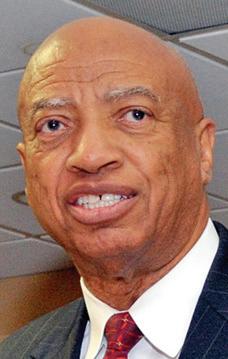
n “People are coming to St. Louis because of the district, but they’re locating all over the region.”
– Otis Williams, St. Louis Development Corporation
n
is an
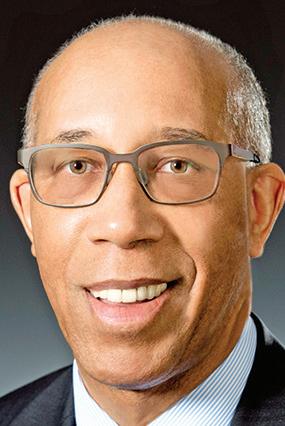
Keith Williamson was appointed president of the Centene Charitable Foundation. Previously he was secretary and general counsel of Centene. Since joining Centene in 2006, Williamson has overseen all legal functions for the enterprise, aiding in the company’s growth and expansion.
He has chaired the board of the Urban League of Metropolitan St. Louis, served on the board of the Saint Louis Art Museum, co-founded the KIPP charter school network and worked with The Opportunity Trust, which seeks to improve St. Louis public education.
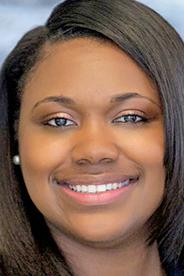
Jerina Phillips was named a member of the St. Louis office of law firm Lewis Rice. She represents individuals and companies in a variety of disputes, including complex commercial litigation, employment litigation, media and communications law, and consumer litigation. She has successfully represented clients throughout the United States and across nearly every industry.
Previously she clerked for judges at every level of the Missouri state court system, including an internship with the Missouri Supreme Court.
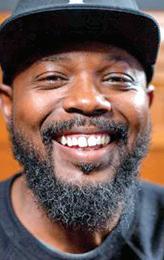
Kevin McKoy was one of 10 local artists awarded a $20,000 grant from the Regional Arts Commission of St. Louis as part of its annual Artist Fellowship program. He is a designer and interdisciplinary artist and half of the collaborative duo, WORK/PLAY, along with his wife, Danielle McKoy. His work has been exhibited in Small Talk at Crystal Bridges Museum of American Art, Overview is a Place at SPRING/BREAK Art Show in New York, and On & On at the Beard and Weil Galleries at Wheaton College.
Louis, the Missouri Botanical Garden and BJC Healthcare. Today, BJC Healthcare is the largest single employer at Cortex, with more than 1,000 workers.
The district houses more than 400 companies, including corporations like Microsoft and Boeing, as well as research institutions and startups. Together, they employ nearly 6,000 people.
The report found Cortex is also boosting the regional economy. Cortex-based economic activity and regional operations generate another roughly 7,300 jobs in the St. Louis region. In 2018, the district spurred $2.1 billion in regional business activity, according to the report.
Otis Williams, executive director of the St. Louis Development Corporation, said Cortex is a
CORTEX, B2
13 students advance to the state competition
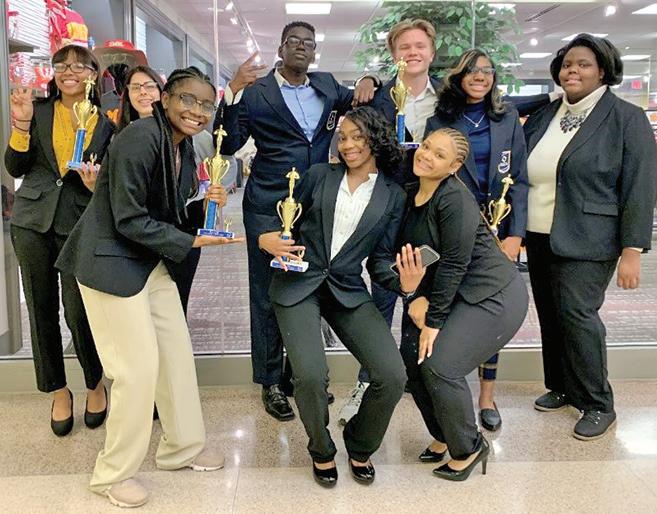
More than 40 Hazelwood School District students took part in a regional DECA competition February 4 at UMSL. DECA is an international association of high school students studying marketing, finance, hospitality, and management.
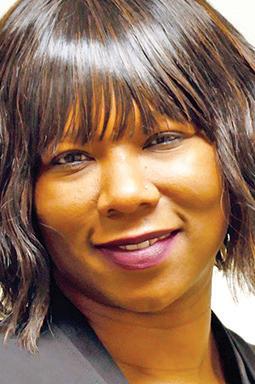
Deitra Colquitt was named co-principal of Pershing Elementary School in the School District of University City. She currently serves as a teacher instructional leader at Pershing Elementary School. She joined the district in 2015 after serving as a middle school English Language Arts teacher for the St. Louis Public and Hazelwood school districts from 2003 to 2012 and as an adjunct instructor for St. Charles Community College in 2013.
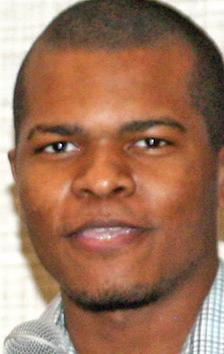
Scott McClendon received the annual Gateway Drive To Success Award (scholarship) from World Wide Technology Raceway. This scholarship is presented to a deserving individuals who have faced extreme obstacles in life that have obstructed their dream to go racing. The Gateway Kartplex at the raceway aims to help them overcome those challenges compete in motorsports. This award helps people who have demonstrated passion and commitment to the sport by providing them with an Ignite K3 kart to use for the 2020 racing season.
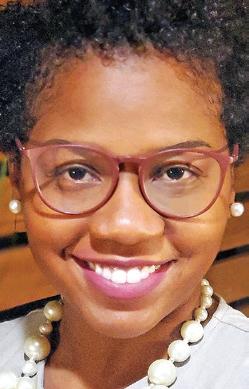
Jessica Hawkins was named co-principal of Pershing Elementary School in the School District of University City. She currently serves as a teacher instructional leader at Pershing Elementary School. She joined the District in 2017. She was previously an elementary school teacher from 2010 to 2017 in the Kirkwood School District, where she also facilitated several building- and district-level educational equity initiatives. On the move? Congratulations! Send your good professional news and a color headshot to cking@stlamerican. com
By Hazel Trice Edney and Hamil Harris Of TriceEdneyWire.com
Former New York City
Mayor Mike Bloomberg just made black history. The presidential candidate who has been running his campaign through television ads and private meetings spent a historic amount of money – $3.5 million – with black newspapers.
“Mike Bloomberg just made the largest single political ad buy in the history of the NNPA,” said Ben Chavis, president/CEO of the National Newspaper Publishers Association (NNPA) in an interview with the Trice Edney News Wire. “The money has already been distributed, and it’s running in our newspapers right now.”
Chavis said the money will be broken down among NNPA member newspapers in states that hold primaries on Super Tuesday and beyond. Super Tuesday states include Alabama, Arkansas, Colorado, Georgia, Massachusetts, Minnesota, Oklahoma, Tennessee, Texas, Vermont, and Virginia.
“It’s a national ad buy, and over 129 of our newspapers will benefit from that,” Chavis said. “What it shows is that the Bloomberg campaign is taking the black vote seriously and it’s taking the Black Press seriously.” The St. Louis American is among those newspapers benefitting from the ad buy.
NNPA, which turns 80 in March, has a membership of more than 200 black-owned newspapers around the country.
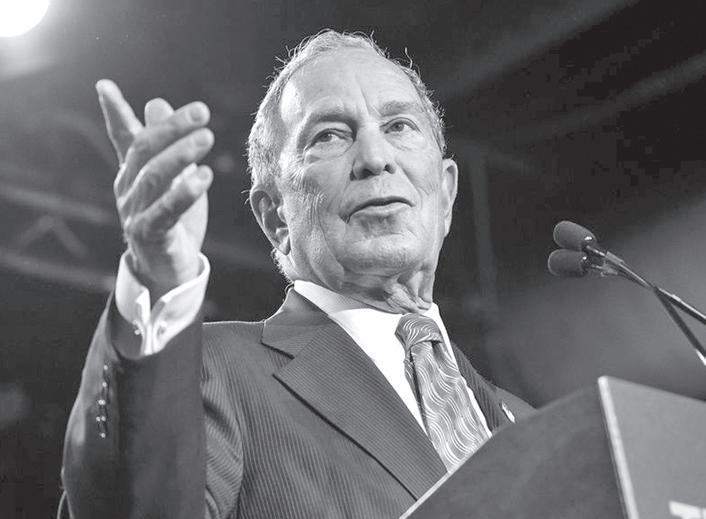
A longstanding grievance aired by the organization is that Democratic candidates and the Democratic National Convention have tended to take black newspapers and the black voters who read them for granted. This is despite the fact that African Americans vote for Democratic presidential candidates 95 percent of the time.
“NNPA is a 501-C6; so we don’t endorse,” said Chavis. “But our member newspapers have the freedom to endorse whatever candidate they feel will best serve Black America.”
n “It shows that the Bloomberg campaign is taking the black vote seriously and it’s taking the Black Press seriously.”
– Ben Chavis, president/CEO of the NNPA
Joe Biden has long been thought to be the front runner in the black community, especially because of his service as vice president to President Barack Obama. But it is clear that Bloomberg’s strategy is to meet him head

NNPA, which turns 80 in March, has a membership of more than 200 black-owned newspapers around the country.
on. While Biden has yet to lay out a black agenda, Bloomberg held a meeting in Tulsa, Oklahoma on January 19 to lay out his black economic agenda.
“It was very close to the U. S. Black Chambers’ economic agenda – from increasing the number of black-owned businesses to increasing
continued from page B1 success story that shows how early public funding can pay off in the long run.
“People are coming to St. Louis because of the district, but they’re locating all over the region,” he said. “We see the energy even transferring to downtown, and hopefully we can get some of that energy transferred north and south.”
TEConomy’s analysis found that over the past few years, Cortex has generated more than $40 million in net new taxes. The district has so far used about $100 million of an approved $167.7 million in tax increment financing assistance over a 30-year period starting in 2014.
Hank Webber, chairman of the Cortex board and executive vice chancellor of Washington University, said that money has helped to create a desirable location for startups and corporations.
“In the first stage, you couldn’t get development without providing some financial assistance in order for people to enter here, and now developers are willing to pay market rents,” he said.
Webber added that some projects under construction —
continued from page B1
evaluated by business and industry professionals as they problem-solve realistic workplace topics and case studies through one-on-one interaction with an executive or community member.
Nine students from Hazelwood Central High School and 35 from Hazelwood East High School competed, and several placed high enough to advance to the Missouri DECA State Career Development Conference in Kansas City in March.
The following students from
the number of deposits into black banks, increasing the number of African-American homeowners, increasing the number of contracts awarded to black businesses by the federal government,” said Ron Busby, president/CEO of the U.S. Black Chambers Inc., who attended that meeting.
Stressing that the Black Chambers is a non-profit and cannot endorse candidates, Busby said he has had no such meeting with Biden.
“For hundreds of years, America systematically stole black lives, black freedom and black labor,” Bloomberg told the audience – “a theft of labor and a transfer of wealth, enshrined in law and enforced by violence.”
During his speech in Tulsa, Bloomberg apologized for the controversial “stop and frisk” used by the New York Police Department while he was the mayor of New York City.
While Bernie Sanders and Pete Buttigieg are claiming front-runner status, Bloomberg will not be on any ballot until Super Tuesday, March 3, when voters go to the polls in 12 states where nearly one-quarter of the Democratic delegates will be selected.
One of the challenges that all of the candidates have is generating excitement, according to E. Faye Williams, president of National Congress of Black Women.
“There is no excitement in the race, and my concern is that people will stay home instead of going to the polls,” Williams said. “We had Senators Cory Booker and Kamala Harris but they are gone, and right now we in the black community feel left out.”
According to the Associated Press, at the Tulsa meeting, Bloomberg “spoke out against an American history of racebased economic inequality from slavery to segregation to redlining, and outlined a proposal aimed at increasing the number of black-owned homes and businesses. The plan includes a $70 billion investment in the nation’s most disadvantaged neighborhoods.” Bloomberg went to Tulsa to commemorate the 1921 race riots in Tulsa where AfricanAmerican business owners were killed and their shops burned in one of the worse race riots in U.S. history.
including the Aloft hotel slated to open this summer — haven’t received any public financing.
“Our goal is to move toward elimination of all public subsidies so there’s only gain from employee taxes — all the tax revenue that’s provided,” he said.
The report found that an additional $700 million in
n “Our goal is to move toward elimination of all public subsidies so there’s only gain from employee taxes — all the tax revenue that’s provided.”
– Hank Webber, chairman of the Cortex board
private investment has also helped develop nearly 2 million square feet in the district, including retail real estate and coworking spaces.
Cortex got off to a slow start in the early 2000s, but more recently, occupancy and real estate development have taken off.
The report credits that success to the development of Cortex’ identity as a “live/ work/play/learn” community
East High School placed in the top three of their events and will advance to the state competition:
• Iyinoluwa Aruwajoye, 1st place, Principles of Finance
• Sydneh Holmes, 1st place, Marketing Communications
• Krysta Utley, 2nd place, Principles of Finance
• Alijah Holmes, 2nd place, Automotive Services Marketing
• Maryjean Taylor-Hutt, 3rd place, Leadership Delegate and 3rd place in Hotel and Lodging Management
• Angelique Wilson, 3rd place, Apparel and Accessories Marketing
• Brandon Thomas, 3rd place, Business Finance
that attracts established and new companies looking for a collaborative environment.
During a press event on February 6 highlighting the report, Cortex CEO Dennis Lower said the presence of startups has attracted more than 20 established corporations to the district in the past few years.
“They’re moving in to follow these entrepreneurial startup companies,” he said. “They want to be close to that energy; they want to interact.” Cortex has also tackled an important barrier holding back business growth in many cities — access to capital.
Data from Pitchbook analyzed by TEConomy shows that 58 Cortex tenants have raised nearly $400 million in capital. Several venture capital and risk capital organizations are located on site.
Lower, who is expected to step down from his position early this year, said it takes about 35 years to complete an innovation district like Cortex, which is almost halfway toward meeting its goals.
By 2030, Cortex aims to house 600 companies and 15,000 jobs.
Follow Corinne on Twitter: @corinnesusan Reprinted with permission from news.stlpublicradio.org
• Jada Williams, 1st place, Marketing Communications
• Sebastian Dellrud, 2nd place, Business Services Marketing
• Jordan Brathwatte, 2nd place, Human Resources Management
• Taylor Davidson, 3rd place, Apparel and Accessories Marketing
• India Harris, 3rd place, Restaurant and Food Service Management.
• Shaniya McGhee, 3rd place, Restaurant and Food Service Management. The following students from Central High School placed in the top three of their events and will advance to the state competition:
A Special Anniversary Celebration honoring Minister Dr. Betty Jean Perry will be held on Sunday, March 8, 2020, 3:30 pm—6:30 pm at Memorial Baptist Church, 4001 Fair Avenue (at Margaretta). Please attend this celebration of miracle, blessing and spirit! We have Quest and visitors that will be praising and worshiping the Lord during this service event. For info call: 314-6521107. We expect to see you on this date!
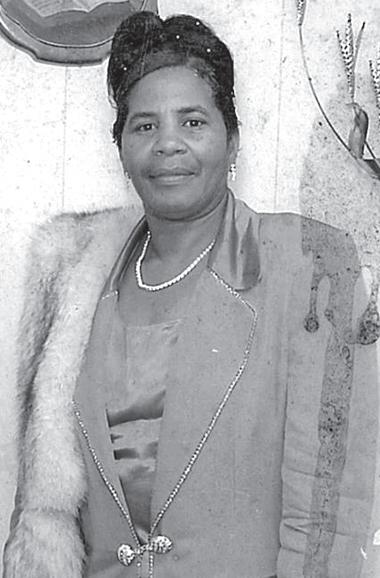
Beaumont Class of 1965 has scheduled its 55-year reunion celebration for the weekend of Sept. 25-26th 2020. The Meet and Greet (9/25) and Dinner/Dance (9/26) will be held at the Hilton Garden Inn St. Louis Airport, 4450 Evans Place, St. Louis, MO 63134. Cost is $100 per person.
Make your check payable to Beaumont Class of 1965 & mail to: Verdell Thomas Marshall, 1224 Hudson Hills Drive, 63135. For additional info contact Geraldine Reid (314)868-8284.
Beaumont Class of 1970 has scheduled its 50th class reunion celebration for the weekend of 10/16/2010/18/20. The banquet will be held at The Embassy Suites (downtown), 610 N. 7th St. We are currently working on finalizing plans to make this our best reunion yet! Please forward your
current contact info to: beaumontclassof1970@gmail. com, so that we can keep you informed.
Central High School Class of 1970 is in the process of planning its 50 year reunion in 2020. Classmates information to either Lillian McKinney at mamajoyce314@icloud. com or (314) 335-9760, Eric Armstrong at elarmstr@yahoo. com or (918) 650-3385, Sabra Morris-Pernod at Saboots@ centurytel.net or (314) 7030812. Sumner Alumni Association


Mother Pearl Shulton was born on February 22, 1920 in Forest City, AK and is about to celebrate her 100th birthday. She was married to Willie Shulton for over 50 years and they had two children, Willine and James Shulton. Mother Pearl has been a member of Rose Hill Missionary Baptist Church since 1971. She was also a beautician for over 50 years.
Happy Birthday to Susie Crenshaw, who turns 100 years old on February 22! She fought for Civil Rights in the 1950s and 1960s. May God continue to bless you. Love, Your family and friends
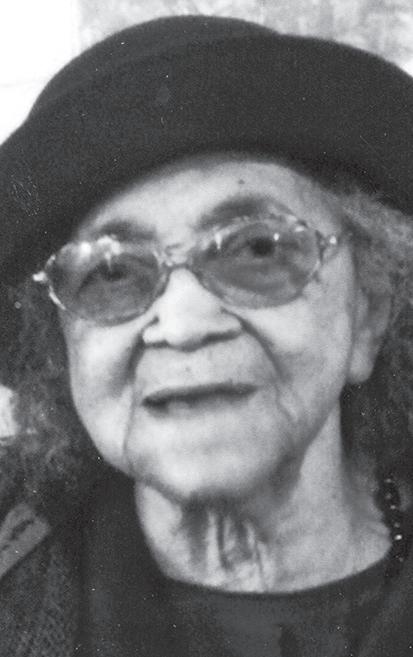

hosts its 17th Annual Membership Round-Up Sunday, February 23, 2020, 1-4 pm at Sumner High School. 1:45 pm Catered by Murray’s Catering, The Readus Miller Project, displays, souvenir items, vendors, SAA Membership & more. Program 2 pm. Coach Lawrence Walls ‘55, Lady Re “The Funny Lady”, Sumner Alumni A Cappella Choir, Angelo “Sax” Shaw & more. Bring Can Goods for a Ville’s church food pantry. Display your rich heritage; submit Ad. Vendors ($50 Fee) email:
sumneralumniassn@yahoo. com for vendor form, flyer, ad form or call J. House, Chairperson (314) 420-3442 for more info. Vashon High School Class of 1974 is planning for its 45th reunion. We are in the process of rounding up all classmates. To provide or update your contact information, please email ljbady@gmail.com or contact: Joe Verrie Johnson 314-640-5842, Jordan Perry 314-724-4563, or LaVerne James-Bady 314-382-0890.
Do you have a celebration you’re proud of? If so we would like to share your good news with our readers. Whether it’s a birth, wedding, engagement announcement, anniversary, retirement or birthday, send your photos and a brief announcement (50 words or less) to us and we may include it in our paper and website – AT NO COST – as space is available Photos will not be returned. Send your announcements to: kdaniel@stlamerican. com or

William J.
February 26
By Daphne Dorsey
American
Louis
For The St.
Throughout February, New Life in Christ Church in O’Fallon, Illinois, will celebrate Black History Month with a special sermon and lecture series that examines the current state of race relations within the United States through the lens of the Bible.
The series, White Privilege/ Black Pride – A Biblical Perspective, will feature nationally and locally known speakers who will provide diverse views on the topic each Sunday during the church’s 8 a.m. and 10 a.m. services and during its Wednesday evening service which begins at 7 p.m. The choirs from Friendly Temple Baptist Church and Central Baptist Church in St. Louis and The Impact Church in East St. Louis will also perform during the month’s various services.
“Our country is in a space that begs for clarity on the issue of White Privilege/Black Pride,” said Bishop Geoffrey V. Dudley Sr., senior pastor at New Life in Christ Church and founder of the O’Fallon, Illinois, chapter of the NAACP.
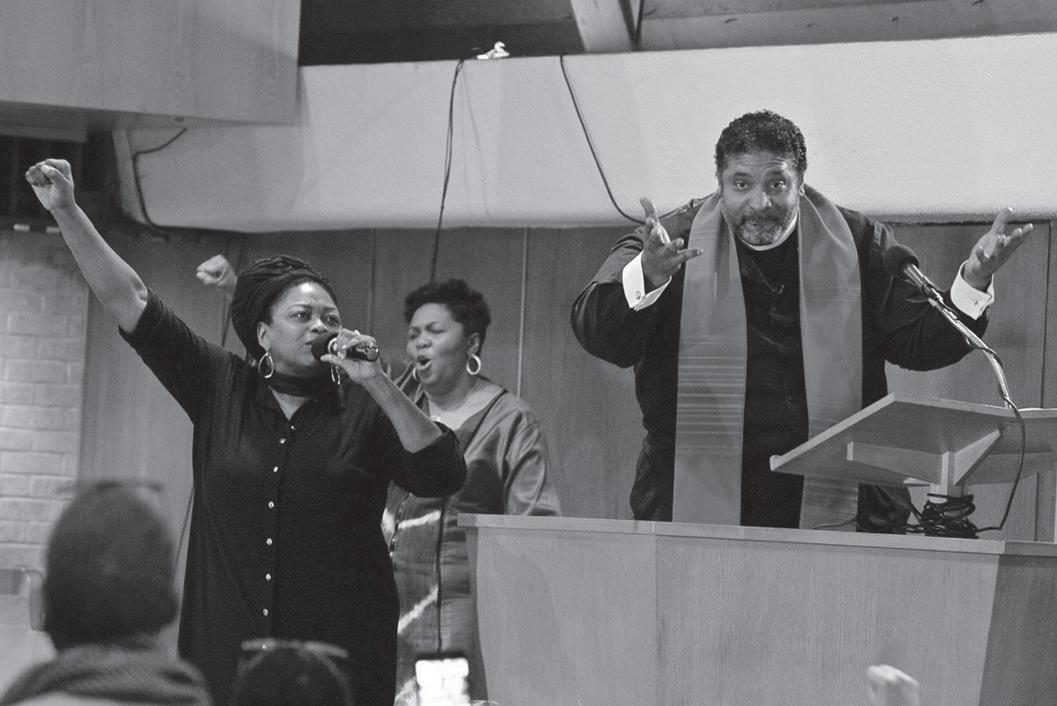
movement, opened the series on February 5, followed by Bishop Geoffrey V. Dudley Sr., senior pastor, New Life in Christ Church on February 9 and the Rev. Traci Blackmon, associate general minister of Justice & Local Church Ministries for the United Church of Christ and senior pastor of Christ the King United Church of Christ in Florissant, on February 12.
Then the Rev. Starsky Wilson, president and CEO of the Deaconess Foundation, board chair for the National Committee for Responsive Philanthropy and former co-chairman of the Ferguson Commission spoke on Sunday, February 16, followed by Minister Geoffrey Dudley II, young adult pastor, New Life in Christ Church, O’Fallon, on Wednesday, February 19.
Rev. William J. Barber II sang the gospel, along with Yara Allen and Rev. Traci Blackmon, during “The Revival: Time for a Moral Revolution of Values,” held at Christ The King United Church of Christ in Ferguson in 2016. He will speak and preach at New Life in Christ Church in O’Fallon, Illinois 7 p.m. Wednesday, February 26 as part of its White Privilege/Black Pride series. Law
“In recent years, our churches, which once were the spiritual and moral voice for civil rights, as a collective body, have been silent on volatile issues that impact our congregations. As a result, the wrong voices have filled the space.”
More than 150 years following enactment of the 13th Amendment which abolished slavery and nearly 57 years since the 1964 Civil Rights Act was signed into law, a 2019 Pew Research Center Poll says six in 10 Americans believe race relations in the United States are bad. Additionally, of the more than 6,000 respondents who participated in the survey, most indicated its now more common for people to express racist or racially insensitive views, while more than four in 10 say it’s more acceptable today to do so.
When it comes to educational and employment success, African Americans, more than any other group felt their race negatively impacted their ability to get ahead whereas whites felt they were most likely helped because of their race.
“We hope those attending this timely community event will learn how to navigate their lives in the current cultural and political climate we live in, while also understanding the biblical point of view on this important issue,” Dudley said.
Jamal Bryant, senior pastor of New Birth Missionary Baptist Church in Atlanta and a social justice advocate who’s active in the Black Lives Matter

Have you ever wondered how a lawyer feels who knows his or her client is guilty of a crime, but is able to get that person off based on a legal technicality? According to our legal system, the person is innocent. But actually, morally, that person is as guilty as, shall we say, sin.
This must have been one of the most important issues being debated by the traditional Jew of Christ’s time and those early Christians who chose to follow Him. This is probably the focal point of what got Him crucified and the focal point of many a debate today.
The point of God’s Word is that Christ is indeed His Son, risen from the dead, who died for our original sin and through Whom we have obtained everlasting life. Out of love and compassion for our fellow man, out of service in God’s name, out of honoring Him will we, too, fulfill our purpose here on earth.
The White Privilege/Black Pride lecture and sermon series will continue with the following speakers:
• Sunday, February 23 –Bishop Geoffrey V. Dudley Sr.
• Wednesday, February 26 – the Rev. William Barber II, national board member of the NAACP and senior pastor, Greenleaf Christian Church, Goldsboro, N.C.
With a membership of more than 2,000 members, New Life in Christ Church – located at 689 Scott Troy Rd. in O’Fallon, Illinois – is considered one of the fastestgrowing congregations in the Metro East.
For more information about the White Privilege/Black Pride, a Biblical perspective lecture and sermon series, call 618-632-6542 or visit www. nlinic.org.
When Jesus was trying to get the Pharisees and the Sadducees to understand that the will of God was more important than the strict traditional interpretation of the Law of Moses, they were more interested in being right than being moral. Thus, you nullify the Word of God for the sake of your tradition.

“You hypocrites! Isaiah was right when he prophesied about you: ‘These people honor me with their lips, but their hearts are far from me. They worship me in vain; their teachings are but rules taught by men.” Matthew 15:6-9.
Throughout the New Testament, Jesus tells us He is the fulfillment of the Law. He is the embodiment of God’s Word. He is the point, not the rule. The point of law is to protect the innocent, punish the guilty and thereby preserve the social and political order of man. Technicality or not, the law was never intended to let a murderer go free.
Law or no law, the Word of God was never intended to punish the pure of heart when acting on behalf of the Almighty. So, Jesus was constantly at odds with the religious scholars of His times (you know, church folk) about the literal interpretation of the Law of Moses versus the holy activities of serving the Lord. Hence his parables were constantly illustrating to those who would listen that, yes, you might be right, but according to the will of God, what’s your point? Can’t you hear Jesus imploring the traditionalists with, “Okay! You’re right. Technically I shouldn’t be healing the sick, giving sight to the blind, feeding the hungry and teaching the gospel on the Sabbath. But what are you arguing about? Why are you so angry? I’m merely doing my Daddy’s will. It seems you’re more interested in being politically correct than you are in bringing the righteous closer to God. So what you gone do, crucify me?”
Play by the rules. But, remember, don’t ever forget the point.
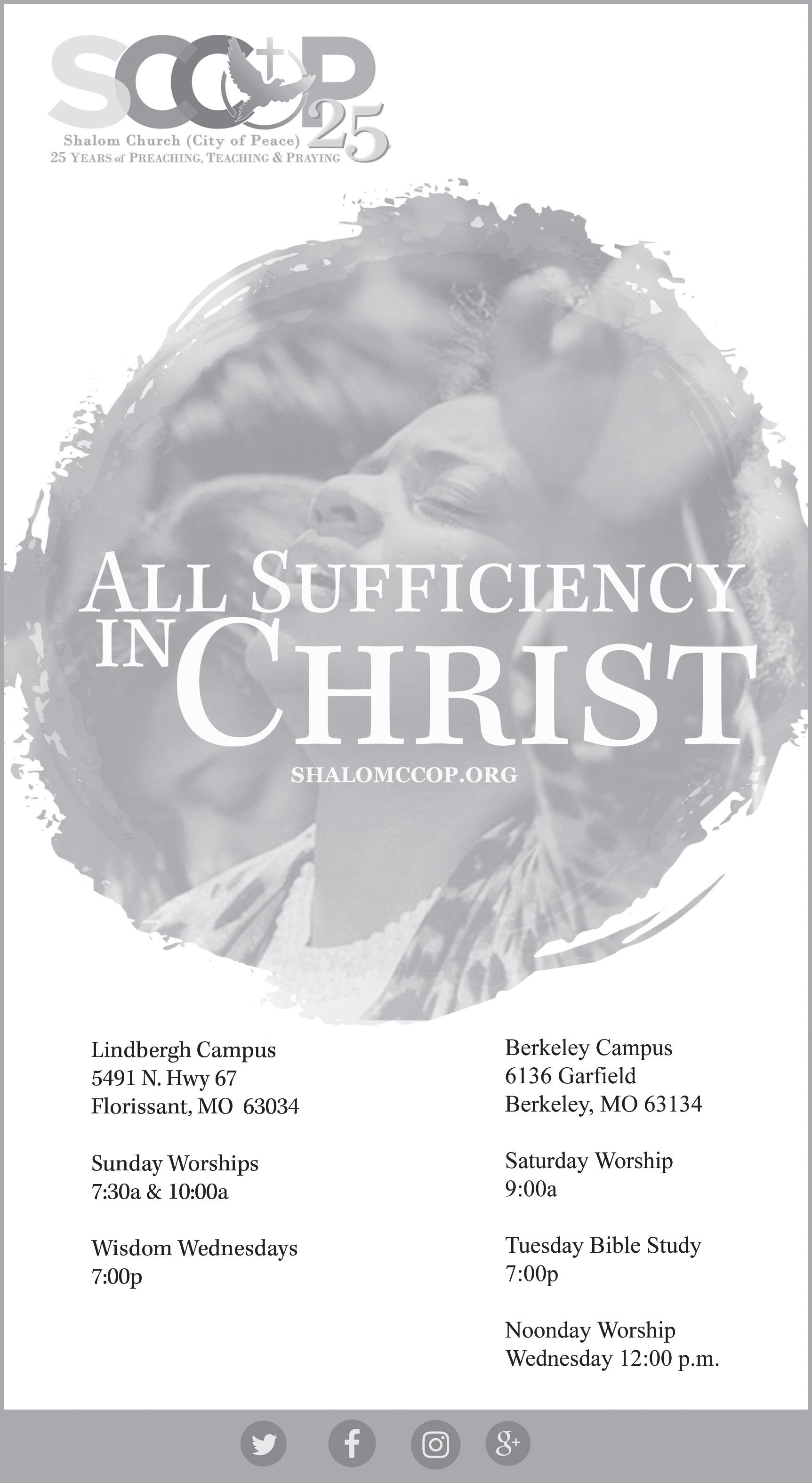
n “It’s a wrap. I feel like I should have two trophies. So, it’s over with that.”
— Orlando Magic forward Aaron Gordon, after finishing second in the NBA Slam Dunk Contest

road to Springfield commences this weekend for Class 1, 2 and 3 schools
The road to Springfield and the state championships will begin this weekend for Class 1, 2 and 3 schools around with the beginning of the district playoffs. All roads will lead to Missouri State University, which is the site of the Final Four from March 12-14 at the John Q. Hammons Arena in Springfield. Here is a quick preview of the upcoming district playoffs involving St. Louis area teams. To see the entire district tournament brackets, visit the state association website at www.mshsaa.org.
Class 3
District 5 (at Whitfield)
Boys: A very competitive district with Hancock as the No. 1 seed, followed by Bishop DuBourg, Whitfield, Lutheran South and Maplewood.
Championship Game: Friday, February 28, 7:30 p.m.
Earl’s Prediction: DuBourg
29, 2:30 p.m.
Earl’s Prediction: Cardinal Ritter
Girls: A very loaded district that features newcomer Miller Career Academy, which drops down from Class 4 after advancing to the Final Four a year ago. Others teams to watch are No. 2 seed Lift for Life, No. 3 Metro and No. 4 Cardinal Ritter.
Championship Game: Friday, February
29, noon

Earl Austin Jr.
Girls: Top seeded Whitfield is a young and talented team that has a chance to make a deep run in the playoffs. Hancock and Lutheran South also field quality teams in this district.
Championship Game: Friday, February 28, 6 p.m.
Earl’s Prediction: Whitfield
District 6 (at Vashon)
Boys: Cardinal Ritter gets the top seed as the Lions are also one of the main contenders for the state championship this season. Other quality teams in the field include Lift for Life, McKinley Classical and Miller Career Academy.
Championship Game: Saturday, February
Earl’s Prediction: Miller Career Academy
District 7 (at Lutheran North)
Boys: Top seeded Trinity is a contender for a state title after advancing to the state quarterfinals last season. A pair of worthy challengers loom in No. 2 seed Lutheran North and No. 3 seed Soldan.
Championship Game: Saturday, February 29, noon
Earl’s Prediction: Trinity
Girls: Lutheran North gets the top seed after advancing to the state championship game season. The Crusaders are a young team that has been getting better all season. They will get challenged from the likes of Trinity, Duchesne and Orchard Farm.
Championship Game: Saturday, February
29, 2 p.m.
Earl’s Prediction: Lutheran North
District 8 (at Winfield)
Boys: A very competitive district at hand with Christian-O’Fallon getting the top seed, followed by a 20-victory Montgomery County team, Winfield and Hermann, which won the district title last year.

Wilder and Fury face off for heavyweight supremacy
To call Tyson Fury a confounding individual would be a bit of an understatement.
At 6-foot-9 and north of 250 pounds, Fury is one of the biggest heavyweight champions in history. His name – Tyson Fury – is the perfect name for a heavyweight fighter. It’s a name I might have chosen for the create-a-boxer mode while playing Fight Night video games. It evokes images of carnage, viciousness and knockouts. In reality though, despite his massive frame, Fury is more Pernell Whitaker or Floyd Mayweather Jr. than Mike Tyson or George Foreman. The giant “Gypsy King” is extremely agile and fluid in the ring. The lineal heavyweight champion is a pure boxer who utilizes a stiff jab, excellent head movement and fantastic footwork to often leave his opponents confused and befuddled.
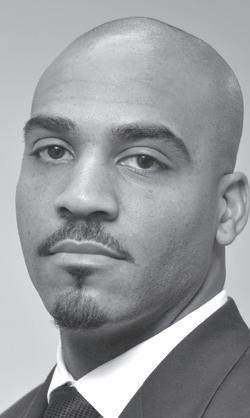
pion Deontay Wilder is no small man either. At 6-foot7, Wilder fits in just fine in the era of supersized heavyweights. Sitting south of 220 pounds, Wilder may not carry the weight of Fury. However, his vaunted right hand carries a ton of power. Count Wilder as one who was left befuddled by Fury’s technical wizardry. Over the first eight rounds of their December 2018 fight, Wilder landed just 43 of 289 punches (14.9 percent). Meanwhile, Fury landed 58 of 226 punches (25.7 percent). It seemed that Fury might be able to jab, feint and dance his way around the most feared puncher since “Iron” Mike Tyson. Fury put on a mini boxing clinic. However, in the ninth round, Wilder’s power caught up to Fury and sent him to the canvas. Then, in Round 12, Wilder landed a straight right hand followed by a left hook

WBC heavyweight cham-
With Alvin A. Reid
After a 42-25 home loss to Michigan on Oct. 12, it looked as though Illinois’ Lovie Smith would be yet another black head coaching casualty at season’s end.
But his team rallied to finish the regular season 6-6 and reach a bowl game. He’s happy, Illini fans are happy and the NCAA is very, very happy.
As pitiful as the hiring record of black head coaches and coordinators is in the NFL, it is far worse in the Power 5 conferences and with other members of the NCAA’s Football Bowl Subdivision.
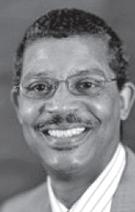
In fact, it’s a disgrace. According to alarming analysis by the Associated Press of all 130 FBS schools, there are just 13 black head coaches. Three of 32 head coaches in the NFL are black, and it is catching hell as a result. Why isn’t college football?
If that’s not scary enough, the number of black offensive and defensive coordinators is downright insulting.
Of the 130 schools, only seven have a black man in charge of the offense. There are four that carry a co-offensive coordinator title. The majority of future head coaches, recently, have been offensive coordinators with play-calling responsibility. There are 16 AfricanAmerican coordinators, and six black coaches listed as co-coordinators. It’s worth noting that Arizona State, with black head coach Herm Edwards, has two black coaches serving as co-defensive coordinators. The University of North Carolina-
Charlotte is another. The 14-team Pac 12 Conference and 14-member Big Ten reign supreme when it comes to inclusion at the highest coaching rank. They both have four AfricanAmerican head coaches. The conferences became tied in head coaching inclusion earlier this month when Colorado’s Mel Tucker bolted from the Pac 12 to the Big Ten’s Michigan State University. In the SEC, Derek Mason of Vanderbilt is the lone black head coach. There is just one black head coach, Dino Babers of Syracuse, in the ACC and the 10-member Big 12 has zero, none, goose egg. Mason was surprisingly not sent packing (his win over Missouri probably saved his job) and Smith’s mid-season turnaround almost certainly saved his.
As poor as diversity is in head coaching in Power 5 conferences, it’s worse at the next level – the 65 schools in the Group of Five.
Jay Norvell at Nevada (Mountain West), Thomas Hammock at Northern Illinois (Mid-American) and Willie Taggart at Florida Atlantic (Conference USA) make the trio of black coaches at that level.
The American Athletic Conference and the Sun Belt have no black head coaches, joining the Big 12 in that embarrassing category.
The survey of coaching positions also revealed that black head coaches have a fewer number of seasons to reach success before being fired compared to their white

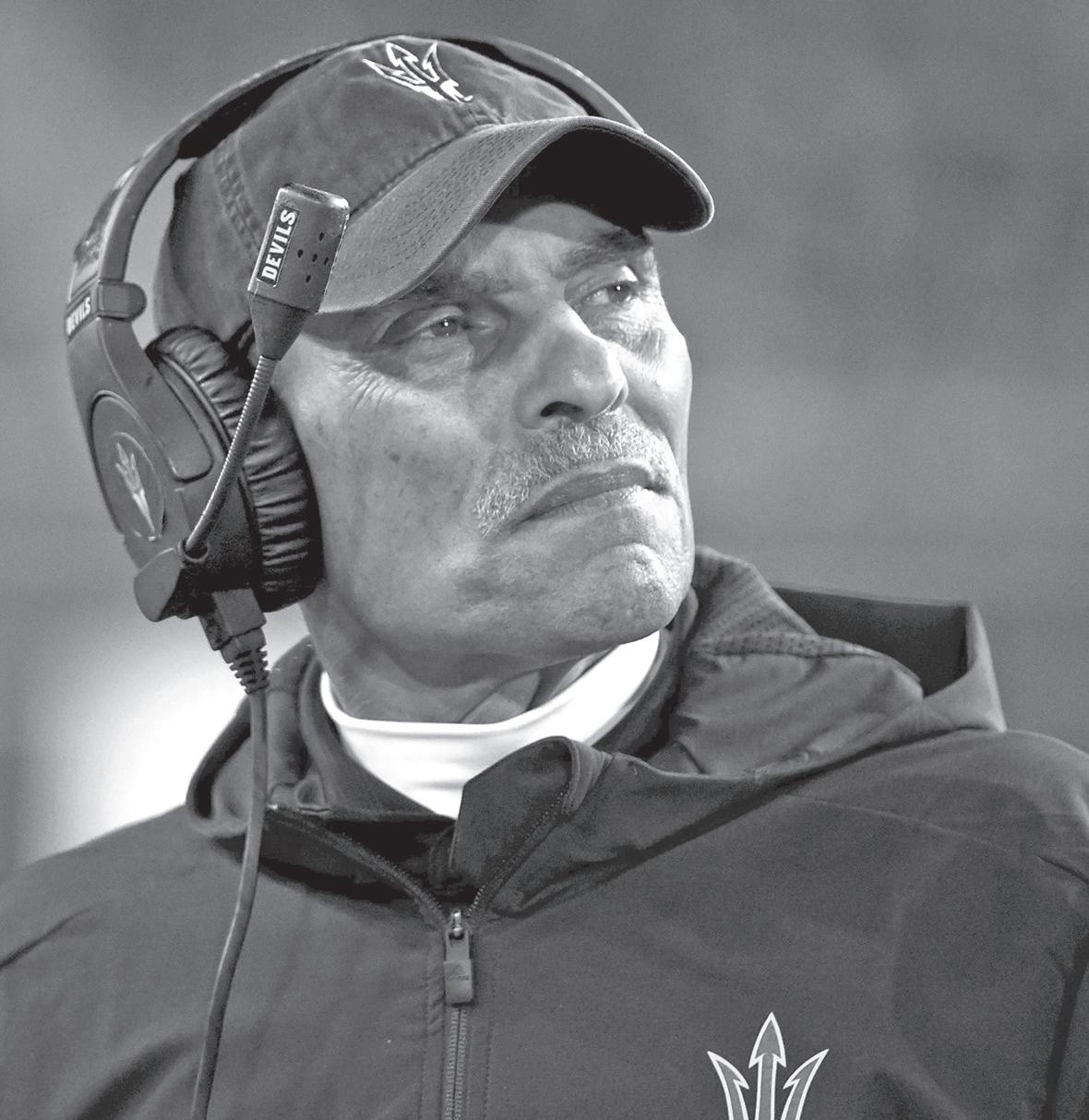
counterparts; second chances are more difficult to come by for black head coaches; and the most prominent football schools in America have rarely had a black man at the helm.
“College coaches are expected to fund-raise and schmooze with alumni as well as coach,” said Mark Naison, an African American Studies and History professor at Fordham University, who contends that non-football factors also hold back black coaches.
“College coaches are expected to fund-raise and schmooze with alumni as well as coach,” he told the AP.
“The rich alumni, most of whom are white, feel more comfortable with people who look like them. So long as alumni dollars drive college football funding, white coaches will have a huge hiring advantage.”
There is no “Rooney Rule” in college football mandating that a black candidate must be interviewed for any head coaching position, and it shows on the field.
Norvell was an assistant coach for 31 years before landing the Nevada job at the age of 53. After a 3-9 season in 2017, he has led his team to back-to-back bowl games.

He says he went though many interviews knowing the school had no intention of hiring him.
“That becomes frustrating as a candidate because you don’t want to go through the process unless you’re being taken seriously,” he said.
“There were several of those I went through, but we just have to keep pushing.”
AP sports writer Paul Newberry also shared the story of Todd Graham in his recent article.
He wrote, “(Graham) bolted from two of his head coaching jobs after only one season — which should’ve raised some red flags — and was fired by Arizona in 2017.
“Career over? Hardly. He recently landed the top job at Hawaii, which become the fifth FBS school to hand him the keys to its program.
“Graham, of course, is white. College football, have you no shame?”
A Paige in history
The late, great Satchel Paige’s daughter, Linda Paige Shelby, captured the spirit of her father and former players during the opening celebration of the 100th anniversary of the Negro Leagues last Thursday in Kansas City.
“You couldn’t keep them down,” she said.
“They loved the game of baseball and nothing was going to stop them from playing it. If they were alive, they would be overwhelmed. They never expected this kind of appreciation.”
Major League Baseball and
the Major League Baseball Players Association showed their respective appreciation with a joint donation of $1 million to the Negro League Baseball Museum.
“This will be a time of celebration, but also a time of reflection,” said NLBM Chairman Stewart Myers.
“(It’s) a time to acknowledge the courage of those who helped change America’s national pastime and America too,” NLBM chairman Stewart Myers said.
On June 27, all MLB players, managers, coaches and umpires will wear a patch commemorating the Negro Leagues 100th anniversary.
The St. Louis Cardinals are scheduled to be in Boston taking on the Red Sox that afternoon.
“It commemorates baseball history, and it’s a tribute to African-American entrepreneurship in the culture that existed at the time,” MLB Commissioner Rob Manfred said.
St. Louis’ All-Time Black Athletes
I commend sports writer Seth Berkman for his list of 50 Black Athletes That Transformed American Sports that was written for the website Stacker and MSN Sports.
It includes three athletes special to St. Louis – Arthur Ashe, Curt Flood and Jackie Joyner-Kersee.
Most of the names are familiar, including Muhammad Ali, Henry Aaron, Jackie Robinson and more.
He recognizes some other
not-as-well-known sports giants including Fritz Pollard, the NFL’s first black player and Blake Bolden, the first Black player in the National Women’s Hockey League. A glaring omission, though, is Hall of Famer and greatest pitcher in St. Louis Cardinals history, Bob Gibson. Berkman should feel free to drop one of the following to include Gibson - Laila Ali, Bo Jackson, Florence Griffith Joyner, Jon Jones or Herschel Walker.
The Reid Roundup
Twenty-one Major League teams have announced respective special recognition days honoring the Negro Leagues and its players during the 2020 season. While I have no doubt the franchise will take part, so far, the St. Louis Cardinals are not included… While an NCAA Tournament berth won’t happen unless Missouri wins the SEC Tournament, last Saturday’s emphatic win over No. 11 Auburn should be recognized as
Pittman, a grandson of former Dallas Cowboys great Drew Pearson, chose Colorado to pursue his football career –then head coach Mel Tucker took the Michigan State job. This led Pearson to call Tucker “a con man” on Twitter. “He recruited my grandson to go to CU said he wasn’t going anywhere then ups and leaves. Sat there and lied to my face he wasn’t going anywhere! So I want to beat him up today on social media. What else can I do?” You go, grandpa. Alvin A. Reid was honored as the 2017 “Best Sports Columnist – Weeklies” in the Missouri Press Association’s Better Newspaper Contest and is a New York Times contributor. He is a panelist on the Nine Network program, Donnybrook, a weekly contributor to “The Charlie Tuna Show” on KFNS and appears monthly on “The Dave Glover Show” on 97.1 Talk.” His Twitter handle is #aareid1

By Adam Reckamp
Of The Columbia Missourian
Ole Miss senior point guard
Breein Tyree was open at the top of the key down three with under 10 seconds to play. His primary defender, Missouri guard Dru Smith, slipped after Tyree stepped on his foot and the All-SEC selection from last season rose up for the game-tying shot.
Tyree’s jumper came up just short as Missouri prevailed 71-68 over Ole Miss, its third win in four games and the first time the Tigers have won consecutive conference games this season.
Missouri guard Xavier Pinson came into Tuesday’s game playing the best basketball of his career, having set a career-high in points in his last two home games, both Tiger wins. Playing against Tyree, the SEC’s second-leading scorer, Pinson cranked it up another level.
Tyree got his: The senior guard finished with 29 points on 8-for-17 shooting. But Tyree’s contributions were outpaced by Pinson’s careerhigh 32 in just 27 minutes on an efficient 9-for-13 from the field. Most crucially, Pinson led his team to victory, the Tigers’ second straight, as the Pinson-Dru Smith backcourt continued to be a shot in the arm for Missouri’s offense.
“I felt like we had a lot of guys out so Dru and I have to step up big time to make up for those guys who were out because we’re playing extra minutes,” Pinson said. “We’ve just taken the challenge and
Continued from B5 this weekend’s fight, Fury has been telling everyone who will listen that he intends to give Wilder a dose of his own medicine. Instead of trying to beat Wilder on points, he’s planning to knock out “The Bronze Bomber.”
“I’m not going to get a decision. I’m going to knock him out because I need to,” Fury told ESPN. “There ain’t no Tyson Fury points victory in America over the longest-reigning heavyweight champion. I’d rather die than do that. I’m going to drag Wilder to somewhere he’s never been before.”
Fury and his team have been screaming to the high heavens about a second-round knockout. Can that possibly be his fight strategy or is he simply selling wolf tickets to help sell the PPV?
Fury might be crazy, but he’s not that crazy.
After all, though Fury has 20 KOs in 30 fights, his stoppages have come against badly overmatched opponents. Derek Chisora may be his most accomplished knockout victim and he’s been stopped more
Continued from B5
Championship Game: Friday, February 28, 7 p.m.
Earl’s Prediction:
Christian-O’Fallon
Girls: Lutheran St. Charles received the No. 1 seed as they have enjoyed a very solid campaign. The Cougars will be challenged by Hermann, Montgomery County and
(are) owning it.”
Pinson picked up right where he left off against Auburn, scoring the first seven points against Ole Miss for the Tigers.
“He played good against us last year,” Mississippi coach Kermit Davis said of Pinson. “I think he had 20 points and six assists. He’s a good player, he’s fast with the ball, plays with a lot of confidence.”
While Pinson started hot, two early fouls, one of which was technical for taunting after he made a layup, limited him to just seven first-half minutes.
The technical didn’t really bother Missouri coach Cuonzo Martin, who noted that he played with a similar swagger during his career at Purdue.
“I ran my mouth a little bit back in the day,” Martin said.
Fouls were again a problem for Missouri, the most foulprone team in the SEC, which allowed Ole Miss to reach the bonus before the 12-minute mark of the first half.
With Pinson off the floor, the combination of Dru Smith and freshman Parker Braun, who played a career-high 24 minutes, along with the Tigers not letting their opponent make a 3 in the first half for the third straight game, managed to allow the Tigers to bring a 31-27 lead into halftime.
“He can play four or five but with most fives from a physical standpoint, he’ll struggle,” Martin said of Braun.
“But he’s a good athlete, he can block shots, but you saw when they ducked him in late in the game, you saw against Austin Wiley (Braun struggled)
times than a young, black man driving through North County. Wilder is one of the hardest-punching heavyweights in history. The only man to last 12 rounds with Wilder, besides Fury, was Bermane Stiverne – who lost a unanimous decision to Wilder in 2015. In the rematch, nearly three years later, Stiverne went to sleep in Round 1. A then-undefeated Luis Ortiz lasted 10 rounds before getting stopped by Wilder during their first matchup in 2018. Ortiz, whose only two losses have come at the hands of Wilder, was stopped in the seventh round of the rematch.
“His right hand is more powerful than one could imagine,” Ortiz told Business Insider
Ortiz said that before his rematch against Wilder. Despite knowing the danger of Wilder’s right hand and despite being one of the top heavyweight tacticians around, Ortiz was still knocked out again.
Like Fury, Ortiz out-boxed Wilder for long stretches. Ortiz swept the first five rounds on the judges’ scorecards in November. In the seventh round Wilder landed a flush right hand and “King Kong” came crashing to the
Bowling Green.
Championship Game: Friday, February 28, 5:30 p.m.
Earl’s Prediction: Lutheran St. Charles
Class 2
District 4 (at Crystal City) Boys: A very competitive district in Jefferson County featuring Brentwood, host Jefferson City and Valley of Caledonia. Brentwood boasts the area’s leading scorer in

so he doesn’t have that part. But he has all the other stuff and it’s just a matter of him getting time and him having comfort on the floor just playing basketball.”
Braun finished with six points, seven rebounds, but most crucially, four blocks. His mobility on both sides of the floor caused the Rebels issues and was the key to him being more successful than either of Missouri’s more traditional big men in Reed Nikko and Mitchell Smith.
Then at the start of the second half, after Ole Miss took a 32-31 lead, Pinson got cooking again. He froze his defender with a crossover and nailed a mid-
canvas. Wilder can be out-boxed, but for how long? That is a question that Fury will answer Saturday night.
Should he really try to take out Wilder early, I wouldn’t expect Fury to last beyond the fourth round – and that’s taking his remarkable heart and chin into consideration. If he sticks to his superior boxing, I still don’t expect Fury to last beyond the seventh round.
Wilder knows that he can hurt Fury. Fury knows it deep down too. Furthermore, Fury recently switched trainers. He ditched Ben Davison and hired Sugar Hill Steward, the nephew of Hall of Fame trainer (the late) Emanuel Steward
Changing trainers months before a major fight is rarely a great idea. While Fury is experienced enough that a change in trainers should not hurt him terribly, it’s unlikely to help him. If anything, Steward is more likely to stop the fight should Fury find himself in trouble. Davison didn’t throw in the towel during the first fight when Fury appeared unconscious. Without spending a lot of time together to understand his resolve, Steward may have made a different call.
Though Wilder is still an imperfect fighter, he has bet-
senior guard Chris Hill.
Championship Game: Friday, February 28, 7:30 p.m.
Earl’s Prediction: Brentwood
Girls: Northwest Academy gets the top seed followed by Brentwood, host Crystal City and Valley. Northwest is led by All-Public High League performer Keisha Watkins.
Championship Game: Friday, February 28, 6 p.m.
Earl’s Prediction: Northwest Academy
range jumper. On his next trip down the floor, he swished a 3 from the left wing and on the next a 3 from the corner. Moments later, Pinson again crossed his defender for yet another 3-point play, this time the old fashioned way, capping his own personal 11-0 run.
When the Tigers took a 50-41 lead with just under 12 minutes to play in the game, Pinson had 13 second-half points; Mississippi had 14.
“We try to put him in position to help him score the ball because he’s a guy that needs to go north and south and he’s very effective that way,” Martin said about Pinson.
“When you have him going east-west with guys pressuring
ter boxing instincts than he is often given credit for. He also possesses the ultimate equalizer – that right hand. It’s made a believer out of me.
Wilder put it perfectly before his second fight against Ortiz.
Vashon – Boys Basketball
The senior standout enjoyed a pair of big performances in leading the Wolverines to two big non-conference victories. The 6’7” Fletcher scored a game-high 27 points in a 74-44 victory over Trinity Catholic. He followed up with a 24-point performance in a 70-63 victory over Mehlville. Fletcher made

seven 3-pointers in the win over Mehlville. For the season, Fletcher is averaging 18.3 points and 8.9 rebounds while shooting 41 percent from 3-point range. Fletcher will be headed to the University of Kentucky to play for John Calipari’s Wildcats next season.
Mississippi’s KJ Buffen, right, tries to block the shot of Missouri’s Xavier Pinson, left, during second-half action Tuesday, Feb. 18, 2020, in Columbia, Mo. Missouri went on to win 71-68.
guard woke up. Tyree scored eight points in the span of 1:35 as Ole Miss went on a 10-0 run to tie the game at 55 with just under nine minutes to play.
After Ole Miss grabbed a 58-56 lead, Javon Pickett hit arguably the biggest shot of the night, a corner 3 that put the Tigers back ahead for good. Ole Miss kept the game close, even tying it up at one point, but Missouri continued to get to the free-throw line and Pinson and Dru Smith continued to knock down their free throws to seal the victory, though Tyree did get a good look to tie on the last possession.
While Tyree managed to get his points, Missouri held Mississippi guard Devontae Shuler to one point on 0-of-7 shooting, a big factor in the Tigers win.
and trapping him, he’s not the same player. So you got to keep him moving and attack and play in space. But he’s also making shots, but that’s the preparation and the work that he’s put in.”
When Pinson is shooting the way he did against the Rebels, going 4-of-4 from behind the arc, the defense seems like it has no chance to stay in front of the shifty guard, who scored 24 of his 32 points in the closing half.
While Pinson was heating up for Missouri, Tyree went the first 9 minutes and 13 seconds of the second half without a shot attempt. But with Missouri ahead 55-45 and threatening to pull away, the Rebels senior
“As I always say, these guys have to be perfect for 12 rounds, I only need to be perfect for two seconds,” Wilder said. “And then in the blink of an eye it’s bam baby, goodnight!”
Prediction: Deontay Wilder
Asked if the goal is to score 40 points next time out, Pinson laughed, saying “That’s the goal, score as many points as you can as long as we get the win.”
Missouri’s next game is against Arkansas at noon Saturday in Fayetteville, where the Tigers will look to continue their hot streak that started with a home win against the Razorbacks.
“I definitely think that we’re playing our best basketball of the year,” Dru Smith said. “Honestly I’m not sure exactly what changed. I just feel like guys are playing with confidence. They’re playing aggressive and we’re playing good team basketball and team defense.”
wins via KO7 Fight schedule: Saturday, Feb. 22 | Time: 8 p.m. CST; Televised by ESPN+/FOX PPV Follow Ishmael and In the Clutch online at stlamerican. com and on Twitter @ishcreates.
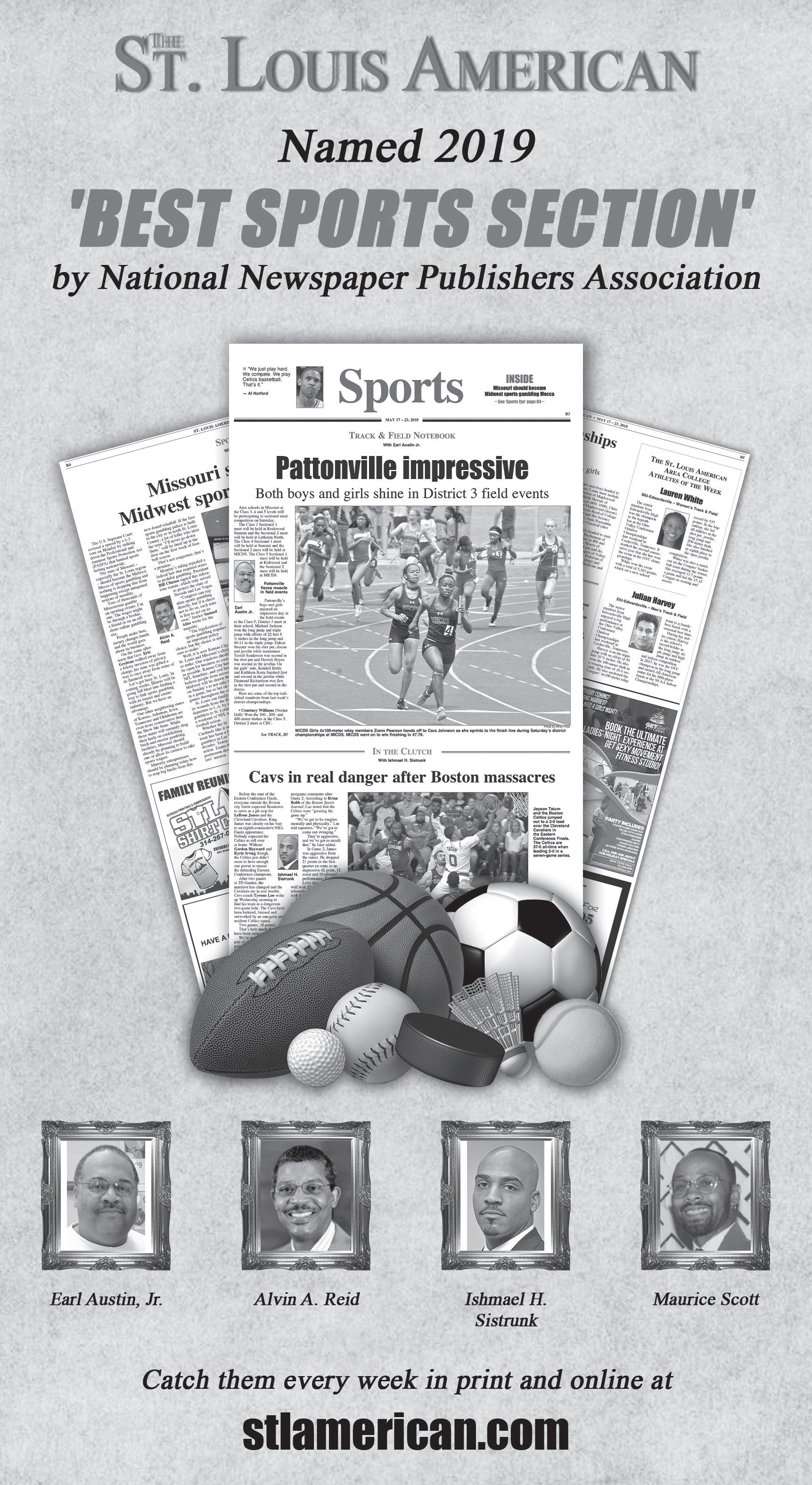
By Charlene Crowell
For The St. Louis American
Once again, the White House Budget Proposal slashes funding and programs that many low- and -moderate income consumers rely upon.
From higher education to a repeated attack to deny the Consumer Financial Protection Bureau its full funding and financial independence from the annual congressional appropriations process, efforts to increase support to businesses continue while retreats from programs that citizens have come to rely upon is the crux of the proposal’s fiscal priorities.
Housing experts have a different perspective.
“With this proposal, President Trump and Secretary Carson make clear their willingness to increase evictions and homelessness –through rent hikes for some of the lowest-income people in subsidized housing, and slashing or eliminating funding for programs that keep the poorest people in our country affordably and safely housed,” said Diane Yentel, president and CEO of the National Low Income Housing Coalition.
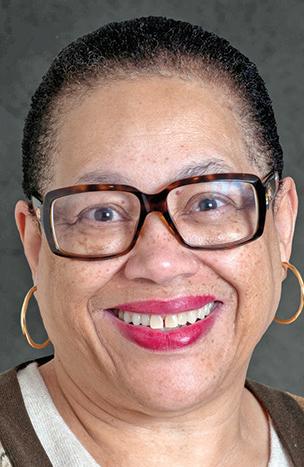
Among federal agencies, one of the most severe budget cuts would occur at the Department of Housing and Urban Development (HUD). A proposed 15 percent reduction from current funding levels will mean $8.6 billion would either eliminate or severely cut programs serving many of the nation’s most vulnerable citizens and communities.
“This budget advances our key priorities, including empowering HUD-assisted families to achieve selfsufficiency,” HUD Secretary Ben Carson said. “For generations, the idea of the federal government providing housing assistance meant only one thing—helping to pay the rent so families can have a roof over their heads.”
For example, Public Housing’s Capital Improvement Fund that provides revenues for major repairs, would end, while the Public Housing Operating Fund would be slashed 21 percent. Together, these two cuts would worsen housing conditions for the estimated 1.2 million households living in public housing units, managed by some 3,300 local housing authorities across the country.
The biggest portion of the HUD cuts would end the $3.3 billion Community Development Block Grant (CDBG) program that uses a formula to support over 1,200 metropolitan city, county and state governments. An additional 214 counties receive direct CDBG grants.
Begun in 1974, CDBG has earned longstanding bipartisan praise for its ability to lure much-needed private

investment. According to the National Association of Counties, every CDBG dollar leverages $4.09 in non-CDBG revenues. Further, it is one of the few federal programs that enable local communities to design community development services that respond to local priorities and needs.
Other HUD programs proposed to end include: Choice Neighborhoods Initiatives, Veterans Affairs Supportive Housing Vouchers, Self-Help Homeownership Opportunity, and Housing Opportunities for Persons with AIDS (HOPWA).

Although HUD would not shutter its Fair Housing and Equal Opportunity efforts, its capacity to pursue equal housing would be cut 7 percent in FY2020. Tenant-based Rental Assistance would also have 21 percent fewer renewed contracts.
Even before the February 10 budget proposal’s release, Lisa Rice, president and CEO of the National Fair Housing Alliance, sounded an alarm on the heels of HUD’s announcement to abandon its rule promulgated during the Obama Administration, Affirmatively Furthering Fair
Housing (AFFH).
“Access to fair housing determines where we live, which in turn determines the quality of education and health services our children have access to, among other resources. That’s why HUD’s proposed AFFH rule is so troubling,” said Rice. “By seeking to dismantle the 2015 requirements put in place specifically to address discrimination and segregation, HUD’s plan could negatively impact the lives of millions of children.”
Nikitra Bailey, an EVP with the Center for Responsible
Lending also spoke out about HUD’s troubling actions against fair housing.
“The 2015 AFFH rule was designed to address the impact of residential segregation and the harmful inequities that result from the discrimination behind it. Discrimination in housing is not a thing of the past, it is ongoing and real,” Bailey said. “Low-income communities and communities of color now more than ever need the government to provide them with critical tools to combat discrimination in housing and the insidious harms that result. Instead we’ve seen HUD, under the current administration, do the opposite.”
Hannah Matthews, deputy executive director for Policy with the Center for Law and Social Policy (CLASP), a national, nonpartisan, nonprofit organization advancing policy solutions for low-income people pointedly summarized the budget proposal.
“The roadmap laid out in the administration’s budget proposal is not a viable path forward, said Matthews. “Instead, we need a federal budget that invests in America’s future. We need investments that reduce poverty, promote economic opportunity, and reduce racial and ethnic disparities.”
Charlene Crowell is the deputy communications director with the Center for Responsible Lending. She can be reached at charlene. crowell@responsiblelending. org.


By Kenya Vaughn Of The St. Louis American
Aaron Neville has been leaving his mark on the music industry across six decades and a host of genres ranging from funk, soul, pop, R&B, country and gospel. And on Saturday, he promises to give St. Louis a taste of it all when he takes the stage as half of the Aaron Neville Duo Saturday night (Feb. 22) at Powell Symphony Hall.
“I love St. Louis,” Neville said. “A good friend of mine is from there – Chuck Berry. So, we are going to do some of his stuff too. He was the architect of rock and roll – him and Little Richard and

By Kenya Vaughn
Of The St. Louis American
When Ronald Isley emerged on stage the day after Valentine’s Day in head-to-toe red and his signature “Mr. Biggs” cane, it was clear that the audience would be in for a treat. The Isley Brothers 60th Anniversary Tour that began last spring and is stretching into 2020, made its way to Lindenwood University’s J. Scheidegger Center for the Arts Saturday night. Ronald and Ernie Isley have been residents of the St. Louis region for more than two decades, but the magnitude of the musical experience they served up on stage was not lost or taken for granted by anyone in attendance – including the Isleys.
“We have about 350 songs to do tonight,” Ronald said, only half-joking. Their influence on music has stretched as wide as their career has been long. Saturday night fans were given a

musical experience that didn’t feel labored – or provide any indication that the best days of the band are long behind them. For just under two hours, the Isley Brothers gave their fans a filling, and fitting celebration of their music that also served as an example of their staying power. Ronald’s signature falsetto isn’t as pristine
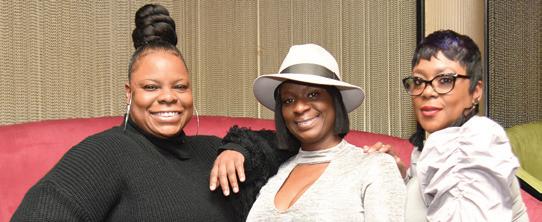
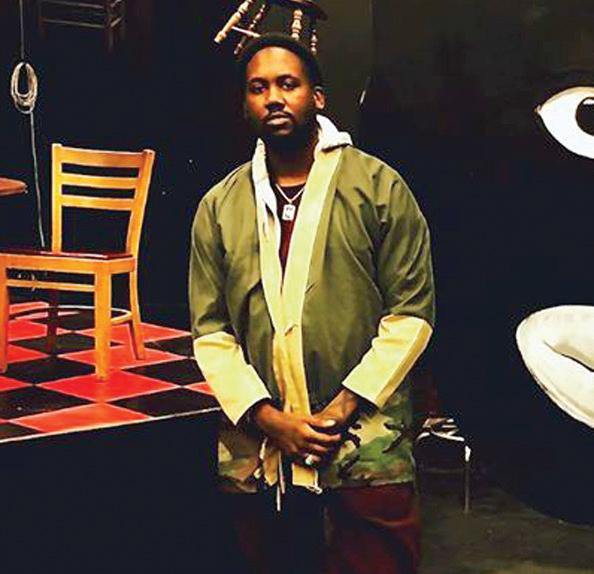
The Black Rep’s presentation of Ntozake Shange’s ‘Spell #7’ opened this week at Hotchner Studios inside Edison Theatre on the campus of Washington University and continues through March 8.
By Kenya Vaughn Of The
St. Louis American
“It’s almost like I’m playing myself in a parallel dimension,” Tef Poe said of his role on the Black Rep stage. He has made a name for himself as a rapper, activist, cultural critic and academic. This week, Poe will introduce the world to Tef Poe the actor when he makes his stage debut in their production of Ntozake Shange’s “Spell #7” at The Hotchner Studio inside the Edison Theatre.
“I didn’t come in as Tef Poe the rapper. I came in as the unproven actor that is trying to prove myself in this hemisphere,” Poe said. “And Ron [Himes] is not the type to give me the padded landing because I’m already doing something someplace else [music].”
Poe plays Eli, a bartender/bar owner poet in Black St. Louis that is the favorite haunt of black artists in the early 1970s. The play’s narrator, a magician named Lou, wants to use his magic to have these regulars embrace their artistry and their blackness.
n “I didn’t come in as Tef Poe the rapper. I came in as the unproven actor that is trying to prove myself in this hemisphere.”
- Tef Poe
“His bar is like a place for starving artists to congregate,” Poe added. “I can relate to that too, because I’m always trying to have an outlet for St. Louis artists. The ingredients that made Eli the person he is aren’t that different from the ingredients that made me who I am. It just all boils down to decisions. The template is the same.”
He finds so much of Eli in himself that he called the character a blueprint from another era.
“I get to have these grand monologues about poetry and words,” Poe said. “My relationship with poetry and my relationship with St. Louis gets explored a lot in this play. It’s based in St. Louis. That’s me. St. Louis and poetry and St. Louis and music. That’s my whole life. I relate to the basic premise of the story too, because we are still living it. The same stuff that Ntozake was writing about –the needle hasn’t moved that far.”
The striking similarities between himself and his character didn’t make the process of stepping on stage and presenting a role as an actor for the first time any easier.
“There’s this one monologue that I do where I’m talking about keeping my feet on the ground,” Poe said. I talk about being a poet and I say, ‘I am a poet. I am not a part-time poet. I am not an amateur poet.’ I can relate to that, because growing up, my parents didn’t’ give me the gasoline to be in the space that I’m.”
During that scene, Poe vividly remember his stepfather saying, “I don’t know what you going to do with your life, but it won’t be this stuff you’re out here trying to do now,” referring to Poe’s rap

How to place a calendar listing
1. Email your listing to calendar@stlamerican. com OR
2. Visit the calendar section on stlamerican.com and place your listing
Calendar listings are free of charge, are edited for space and run on a space-available basis.
Fri., Feb. 21, 7:30 p.m., St. Louis Symphony Orchestra presents Lift Every Voice: Black History Month Celebration. 718 N. Grand Blvd., 63103. For more information, visit www.slso. org.
Sat., Feb. 22, 3 p.m., Do You Know Your Black History Trivia Event. Union Memorial United Methodist Church, 1141 Belt Ave., 63112. For more information, visit www. unionmemorialstl.org.
Sat., Feb. 22, 3 p.m., The Legend Singers Choral Ensemble presents the Annual Festival of AfricanAmerican Spirituals. For more information, visit www. eventbrite.com.
Sun., Feb. 23, 3 p.m. doors, Community Women Against Hardship Black History Month Concert featuring Ferguson native Grammy-winning trumpeter Keyon Harrold. For more information, call (314) 289-7523 or email: communitywomenstl@yahoo. com
Tues., Feb. 25, 4 p.m., Why Black Study? Why Now? The Black faculty at SLU will discuss the continued relevance of Black Study at SLU and throughout the Academy. Pere Marquette Gallery, DuBourge Hall, 221 N. Grand Blvd., 63108. For more information, call (314) 977-2242.
Wednesday, Feb. 26, 6 p.m., University of Mo-St. Louis African American Alumni Chapter and ABC present An Evening with Percy Green: Civil Rights Icon, J.C. Penney Summit Ballroom, UMSL Campus. For more information, call 314 516-5833.
Fri., Feb. 28, 5:30 p.m., Black History Trivia Night.
Ferguson Community Center, 1050 Smith Ave., 63135. For more information, visit www. brownpreneurs.org.
Sat., Feb. 29, 10 a.m., Black History Month – The Story of Black St. Louis Bus Tour. Griot Museum of Black History, 2505 St. Louis Ave., 63106. For more information, visit www.eventbrite.com.
Sat., Feb. 29, 1 p.m., Black History Trivia Extravaganza, Ferguson Community Center, For tickets, visit www. eventbrite.com or email: ronnieb42@gmail.com.
Sat., Feb. 22, 7 p.m., Chaifetz Arena presents The Streetz on Lock 2K20 feat. Yo Gotti, Lil Baby, Boosie Badazz, and Lil Durk. 1 S. Compton Ave., 63103. For more information, visit www.ticketmaster.com.
Sat., Feb. 22, 8 p.m., A Night to Remember with Melba Moore and Howard Hewett Sheldon Concert Hall, 3648 Washington Blvd., 63108. For more information, visit www. metrotix.com.
Through Feb. 23, Jazz at the Bistro presents Tim Warfield Organ Band ft. Terell Stafford. Jazz St. Louis, 3536 Washington Ave., 63103. For more information, visit www. jazzstl.org.
Thur., Feb. 27, 7:30 p.m., Georgia on My Mind: A Celebration of the Music of Ray Charles feat. Take 6, Nnenna Freelon, Kirk Whalum, and Clint Holmes Touhill Performing Arts Center, 1 University Blvd., 63121. For more information, visit www.touhill.org.
Sat., Feb. 29, 8:30 p.m., R&B Only 2020 feat. Tiara Monique and Apex Laurent The Ready Room, 4195 Manchester Ave., 63110. For more information, visit www.

Kenya

rnbonly.com.
Mar. 4 – 8, Jazz at the Bistro presents Etienne Charles: Creole Soul. Jazz St. Louis, 3536 Washington Ave., 63103. For more information, visit www.jazzstl.org.
Sat., Mar. 14, 7 p.m., The Sheldon presents San Francisco Jazz Collective 3648 Washington Blvd., 63108. For more information, visit www.metrotix.com.
Thur., Feb. 20, 8 p.m., The Ready Room presents Tarrus Riley. 4295 Manchester Ave., 63110. For more information, visit www.thereadyroom.com.
Sun., Feb. 23, 5 p.m. (4 p.m. doors) Chuck Flowers and Acoustic Soul, BBs Jazz Blues and Soups, 700 S. Broadway. For more information, visit www.artistecard.com/cflowers
Tues., Mar. 17, 6 p.m., Gordon’s Entertainment presents Honoring Our Own: Miz Renee Smith Performances by Denise Thimes, Joe Mancuso, Eugene Johnson, Laura Green, and more. Sheldon, 3648 Washington Blvd., 63108. For
more information, visit www. metrotix.com.
Thur., Feb. 20, 8:30 a.m. or 1:30 p.m., Norwegian Cruise Line Job Fair. Marriott St. Louis Grand, 800 Washington Ave., 63101. For more information, visit www. eventbrite.com.
Thur., Feb. 20, 5:30 p.m., The St. Louis American Foundation 10th Annual Salute to Young Leaders Four Seasons, 999 N. 2nd St., 63102. For more information, call (314) 533-8000 or visit www.stlamerican.com.
Fri., Feb. 21, 7 p.m., Best Dance and Talent Center 3rd Annual Trivia Night Fundraiser. Heman Park Community Center, 975 Pennsylvania Ave., 63130. For more information, visit www. eventbrite.com.
Fri., Feb. 21, 7 p.m., Mayor’s Mardi Gras Ball. City Hall, 1200 Market St., 63102. For more information, visit www. stlmardigras.ticketspice.com.
Feb. 21 – 23, Working
Women’s Survival Show. St. Charles Convention Center, 1 Convention Center Plz., 63303. For more information, visit www.discoverstcharles. com/event/working-womenssurvival-show.
Sat., Feb. 22, 10 a.m., Soundwave Comic Xpo. .Zack, 3224 Locust St., 63103. For more information, visit www.soundwavecomicxpo. com.
Sat., Feb. 22, 3 p.m., Delta Sigma Theta Sorority, Inc., St. Louis Metropolitan Alumnae Chapter invites you to their 2020 Jabberwock: My Purpose Is Evolving. Missouri Athletic Club, 405 Washington Ave., 63102. For more information, visit www. eventbrite.com.
Sat., Feb. 22, 6 p.m., Mound City Bar Association Trivia Night. Ameren Corporate Office, 1901 Choteau Ave., 63103. For more information, visit www.moundcitybar.com.
Sun., Feb. 23, 2 p.m., Sip Shop & Support Mixer. Live DJ along with mini fashion show. Book T’s Boutique, Mid Rivers Mall, 1600 Mid Rivers Mall, 63376. For more information, call (314) 6903660.
Sun., Feb. 23, 12 p.m., Maryland Heights Cultural Arts Commission and Parks and Recreation Department World Fest 2020. Community Center, 2300 McKelvey Rd., 63043. For more information, visit www.facebook.com.
Tues., Feb. 25, 9 a.m., Alpha Kappa Alpha Sorority, Incorporated Presents: 2020 AKA Day at the Capitol Missouri. The day will include the bus ride to Jefferson City State Capitol with a panel discussion and luncheon at Lincoln University. Bus leaves at 6 a.m. For more information, call (314) 5410378.
Thur., Feb. 27, 5:30 p.m., 7th Annual Whitney M. Young Society Reception. Anheuser-Busch Biergarten, 1127 Pestalozzi, 63118. For more information, visit www. ulstl.com.
Thur., Feb. 27, 6 p.m., St. Louis University Black Alumni Association Happy Hour and Game Night. Up-Down STL, 405 N. Euclid Ave., 63108.
Sat., Feb. 29, 11 a.m., Delta Sigma Theta Sorority, Inc., St. Louis Alumnae Chapter invites you to Founder’s Day Luncheon. With special guest speaker Bishop Vashti Murphy McKenzie. The America’s Center, 701 Convention Plaza, 63101. For more information, visit www.dst-sla.org.
Sat., Feb. 29, 2:30 p.m., Better Family Life’s 7th Annual Jr. Unity Ball. 5415 Page Blvd., 63112. For more information, visit www. bflyouth.org/jrunityball.html.
Sun., Mar. 1, 1 p.m., Off White: The Wedding Show 2020. Palladium, 1400 Park Ave., 63104. For more information, visit www. offwhitestl.com.
Sat., Mar. 7, 6 p.m., International Food Festival 2020. Sample foods from Asia, Latin America, Africa, Europe, and more. Proceeds benefit local food banks. 5 N. Skinker Blvd., 63105. For more information, visit www. facebook.com.
Sun., Mar. 8, 3 p.m., Alpha Kappa Alpha Sorority, Inc., Gamma Omega Chapter and Alpha Phi Alpha Fraternity, Inc., Epsilon Lambda Chapter invite you to The Phirst Experience Fashion Show. 1600 N. Broadway, 63102. For more information,

visit www.eventbrite.com.
Fri., Mar. 13, 6:30 p.m., Shalom Church City of Peace invites you to Generation Next Basketball Tournament. Proceeds will be donated to the St. Children’s Research Hospital. North County Recreational Complex, 2577 Redman Ave., 63136. For more information, visit www.shalomccop.org.
Sat., Mar. 14, 9 a.m., Phenomenal I Am Women’s Conference: Still I Rise. Bridgeton Conference Center, 12259 Natural Bridge Rd., 63044. For more information, visit www.eventbrite.com.
Sat., Mar. 21, 10 a.m., Minority Vendor Fair. Jewelry, art, treats, crafts, clothing, and more. North County Christian School, 845 Dunn Rd., 63031. For more information, visit www. eventbrite.com.
Mar. 21 – 26, Shalom Church City of Peace
HBCU Experience Tour 2020. Schools include Florida A&M University, Alabama State University, Tuskegee University, and Alabama A&M University. For more information, visit www. shalomccop.org.
Mon., Mar. 23, 5 p.m., Urban League of Metropolitan St. Louis’ 102nd Annual Dinner. Marriott Grand, 800 Washington Ave., 63101. For more information, visit www. ulstl.org.
Fri., Feb. 21, 8 p.m., Hilarryous Productions & SWCX present But Baby I Love You part 6 feat. Larry Greene, Libbie Higgins, Rick Royal, Charlie Winfrey, and Nick Nichols. Sun Theatre, 3625 Grandel Sq., 63108. For more information, visit www. metrotix.com.
Sat., Mar. 7, 8 p.m., Stifel Theatre presents Chris Tucker. 1400 Market St.,
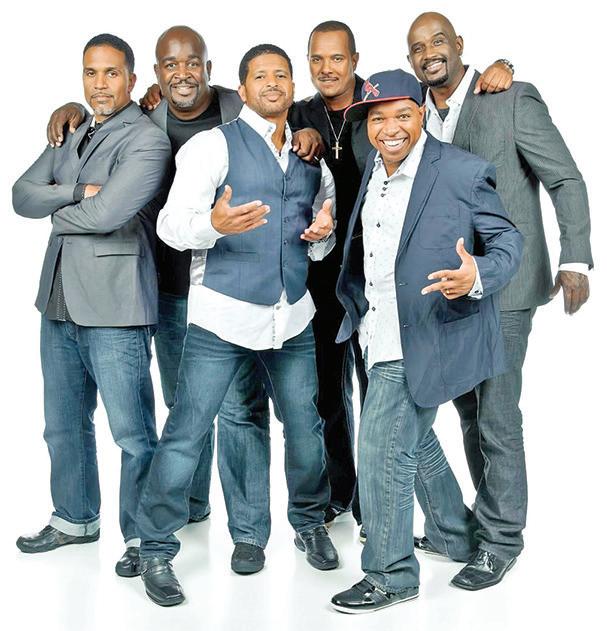
metrotix.com.
Vaughn recommends & Speak. An evening of networking, conversation, giving back, music, and hors d’oeuvres. Fresh & Co. Studio, 4366 Manchester Ave., 63110. For more information, visit www.eventbrite.com.
Through March 1, Metro Theater Company presents Ghost, Grandel Theatre, 3610 Grandel Square. For more information, visit www. metroplays.org

63103. For more information, visit www.ticketmaster.com.
Sun., Mar. 8, 6:30 p.m., Helium Comedy Club presents KevOnStage Slightly Problematic Tour. 1151 St. Louis Galleria, 63117. For more information, visit www. heliumcomedy.com.
Fri., Mar. 20, 8 p.m., Chaifetz Arena presents Festival of Laughs starring Sommore, Lavell Crawford, Michael Blackson, and Don DC Curry. 1 S. Compton Ave., 63103. For more information, visit www. ticketmaster.com.
Wed., Feb. 26, 8:30 a.m., The 5th Annual Webster Diversity and Inclusion Conference (taking place from Feb. 24-27 on the campus of Webster
University) hosts author Michele Norris, author of The Grace of Silence: A Family Memoir. Winifred Moore Auditorium, Webster University, 470 E. Lockwood Ave., 63119. For more information, visit www.webster.edu/ conversations.
Sun., Mar. 8, 3 p.m., Dream Builders 4 Equity & Your Words STL present Dreams Made Real: Book Signing & Poetry Slam. .Zack, 3224 Locust St., 63103. For more information, visit www. eventbrite.com.
Thur., Mar. 12, 7 p.m., St. Louis Public Library hosts author Lisa M. Corrigan, author of Black Feelings: Race and Affect in the Long Sixties. Central Branch, 1301 Olive St., 63103. For more information, visit www.slpl.org.
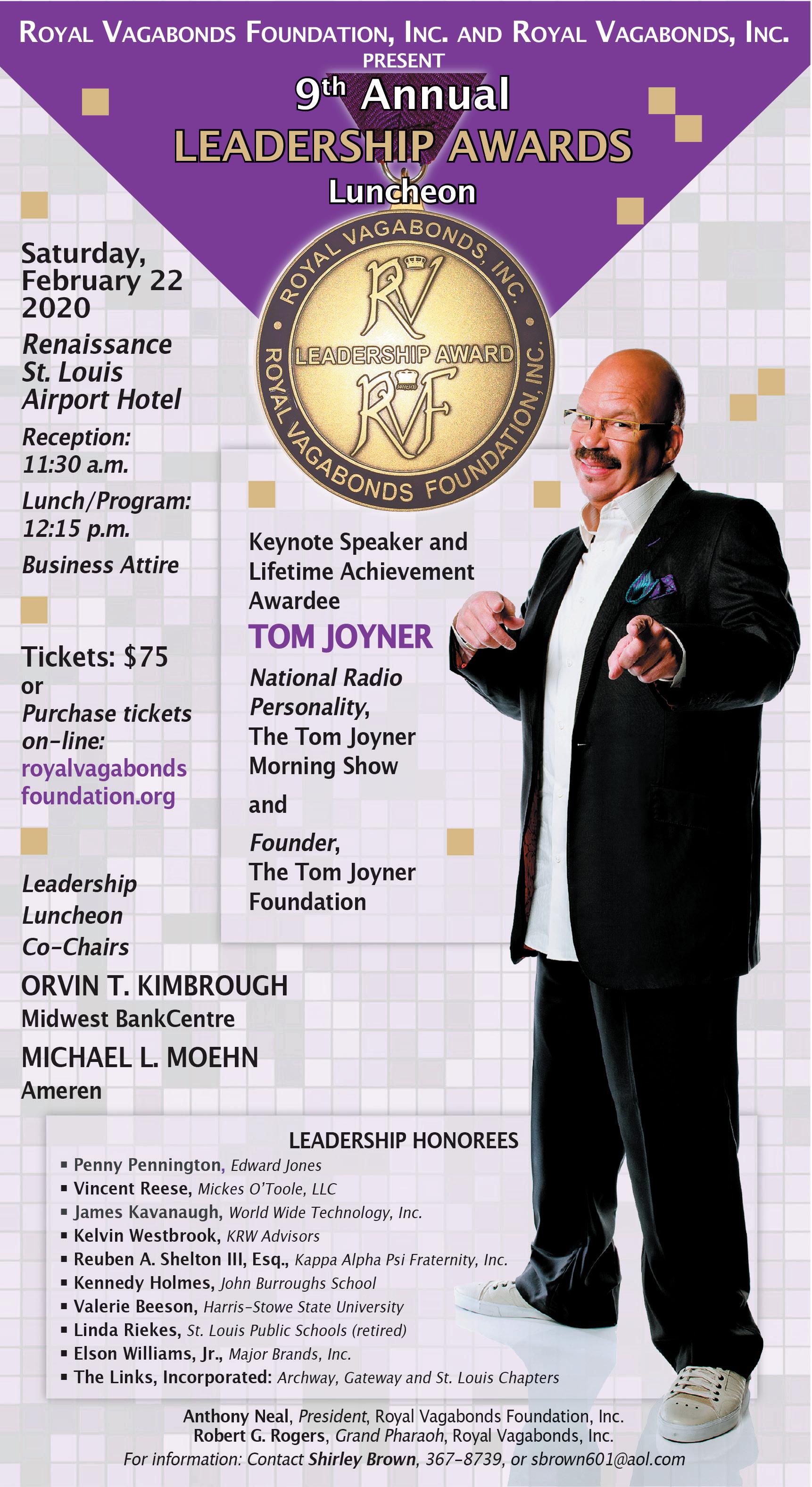
Through Mar. 8, The Black Rep presents Ntozake Shange’s “Spell #7,” AE Hotchner Studio Theatre inside Washington University’s Edison Theatre, 6445 Forsyth. Tickets are available at www. theblackrep.org/, or by calling the box office at 314-5343807.
Sat., Mar. 14, 7 p.m., Change to Passage. A new original musical that tells of the lives of the many historical black figures that made changes in America. Kranzberg Arts Center, 501 N. Grand Blvd., 63103. For more information, visit www.metrotix.com.
Thur., Feb. 27, 6 p.m., Mound City Bar Association @ Contemporary Art Museum. Dr. Reynaldo Anderson will offer a discussion followed by a curated presentation of art from the Afrofuturism genre. 3750 Washington Blvd., 63108. For more information, visit www.moundcitybar.com.
Sat., Mar. 7, 11 a.m., Don’t Touch My Hair: A Talk and Demonstration by Maurice Harris. St. Louis Art Museum, 1 Fine Arts Dr., 63110. For more information, visit www. metrotix.com.
Feb. 21 – 23, Fox Theatre presents RENT. 527 N. Grand Blvd., 63103. For more information, visit www.
Thur., Feb. 20, 6:30 p.m., North County Counts! 2020 Census Ambassador Training. Dellwood City Hall, 1415 Chambers Rd., 63135. For more information, call (314) 521-1822 or email kelly. mcgowan@gwrymca.org.
Wed., Feb. 26, 6:30 p.m., Decision-Making: Using Award Letters to Assess Affordability. Students will understand college financial aid award letters, compare financial aid packages. The Scholarship Foundation of St. Louis, 6825 Clayton Ave., 63139. For more information, visit www.sfstl.org.
Thur., Feb. 27, 6:30 p.m., We Live Here and AIGA St. Louis invite you to Designing Equity. UMSL at Grand Center, 3651 Olive St., 63108. For more information, call (314) 516-6779.
Sat., Feb. 29, 6 p.m., Queen of Resilience presents SIP
Fri., Mar. 6, 7:30 p.m., National Geographic Live: When Women Ruled the Earth with Dr. Kara Cooney, Egyptologist. Touhill Performing Arts Center, 1 University Blvd., 63121. For more information, visit www. touhill.org.
February 22, 10 a.m., Live! Love! Life! Foundation presents their Spirit, Mind, Body Fair, Marquette Recreational Center located 4025 Minnesota. For more information contact Live! Love! Life! Foundation 314312-3486.
Sat., Mar. 14, 6 p.m., Sing for Siteman. Feat. Opera Theatre of St. Louis’ finest performers singing Broadway, opera, jazz, and more. Also feat. the Sheldon All-Star Chorus and performers from The Bach Society of Saint Louis. Haertter Hall, John Burroughs, 755 S. Price Rd., 63124. For more information, visit www. singforsiteman.org
Sat., Mar. 21, 9 a.m., Alpha Kappa Alpha Sorority, Inc., Gamma Omega Chapter & Ivy Alliance Foundation present Health Fair 2020 Olivet Missionary Baptist Church, 12200 New Halls Ferry Rd., 63033. For more information or to pre-register visit, www.signupgenius.com.
Fri., Feb. 28, 7:30 p.m., Refuse to Lose: A Victory Tour with Sarah Jakes Roberts. Friendly Temple Church, 5553 Dr. Martin Luther King Dr., 63112. For more information, visit www. womanevolve.com.


Wonderful World,” “You Send Me” and “Another Saturday Night.”
as it once was, but he still has the vocal charisma and tone to keep the endearment of those who fell in love with his signature voice. And Ernie’s guitar riffs and tricks were just as awe inspiring on stage as they are in recorded form – perhaps even more so. The show began with “Fight The Power” and included just about all their greatest hits. And even with the robust roster of songs, they paid tribute to several other music legends while simultaneously celebrating their own 60-year success story. At transition points between their heavy hitting set list that included “It’s Your Thing,” “Twist and Shout,” “Smooth Sailin’ Tonight,” “Groove With You” to name a few, were tributes to Luther Vandross, Frankie Beverly, Aretha Franklin, Sam Cooke and James Brown, that came by way of snippets throughout the night. After performing their classic “This Old Heart Of Mine,” Ronald segued into a medley of the Sam Cooke hits “What A
Ronald also gave a nod to Lionel Richie with an intro of “Hello” before jumping into the Isley Brothers classic ballad “Hello It’s Me.” Ronald gave former wife and St. Louis native Angela Winbush a shoutout for writing the Isley Brothers hit “Spend The Night.” The Isley Brothers also gave themselves a nod as hip-hop influencers.
“I love it when you call me Big Poppa,” Ronald said with all the swag of Notorious B.I.G. and then some, before he jumped into singing “Between The Sheets.” B.I.G.’s hip-hop classic was heavily sampled the Isley Brothers slow jam. And after singing “Footsteps In The Dark,” a rapper emerged on stage to rhyme the first verse of Ice Cube’s “Today Was a Good Day,” another hip-hop classic that also relied on the Isley Brothers’ ability to create a vibe few could match with their signature grooves.
Of all the tributes, the time he dedicated to his dear friend Aretha Franklin was most compelling. Ronald told the crowd that she was one of his closest friends – and that they spoke three times a week up until her health went into crisis mode in
2018.
He reflected on one of her appearances at The White House and jumped right into
“I Never Loved A Man.”
“I better leave that thing alone,” Ronald said when the song reached the point where Franklin flexed her incomparable upper register of her vocal range.
“She grew up in the church just like us – when we were knee high to a grasshopper.”
He then jumped into “Yes, Jesus Loves Me,” a song he says he sings and dedicates to Franklin, and his wife Kandi Isley’s dear friend Whitney Houston every night.
Kandi, who sang background vocals for the evening along with her sister Kim Johnson, picked up where Ronald left off and gave the audience a full praise break moment that included a word for the believers in the building.
“You don’t have to be perfect for him to love you – and you don’t have to be perfect to love him,” Kandi said.
After the spiritual moment, the evening pivoted back to the Isley Brothers party.
After “Summer Breeze,” “Let Me Know” and “Atlantis,” they closed things out with a dancing inducing “Shout.”

Continued from C1
aspirations.
“I keep asking myself, ‘How am I going to respond doing this monologue as this other person while looking him in the eyes in the audience saying this?’” Poe said. “I’m triggering my real emotions. This might be the first time in my life where I’ve had the space to verbally say these things to him, but it’s through the guise of somebody else and somebody else’s writing.”
The process has been a learning experience that extends beyond the stage –and given Poe a new level of respect for Black Rep founder and Producing Director Ron Himes.
“It’s not just the talent that he has,” Poe said of Himes, who is also directing the production. “We are looking at a black man who built his whole situation from the ground up and has kept it going for over 40 years – the business acumen that it takes to really be self-made. To say, “You know what? Today we are going to do ‘Spell #7’ and nobody is going to tell me different – and have the means to make it happen. To do it on a world class level and do it how they truly want it to be – to not have to pander for fans, to not have to pander for attention. Seeing the powerhouse of a brand that it is, it is constant education if you are willing to learn.”
“Spell #7” also features Drummond Crenshaw, Robert Crenshaw, Jacqueline Thompson, Brian McKinley, Tyler White, Christina Yancy, and Camille Sharp.
Continued from C1
Fats Domino – and we do some of all of their stuff.”
The intimate show features Neville on vocals and Michael Goods on piano. The set list includes music from his own catalog and music that he listened to growing up – some of which he later recorded.
“I would tell people that you won’t be disappointed,” Neville said. “We are going to bring you from here to there and everywhere else in my music world and Michael Goods’ music world.”
Neville’s music world goes hand in hand with his hometown of New Orleans and the rich legacy the city has for influencing American music, from jazz, blues, rock and roll (through Fats Domino and others) and more.
“It’s a musical gumbo,” Neville said. “I’m glad I grew up there. I don’t think I would want to have grown up anywhere else. New Orleans nurtured me and raised me.”
He had been performing since a teen, but when he broke through in the 1966 with the ballad “Tell It Like It Is,” Neville became the first to make his famous musical family a household name.
“I went into to the studio
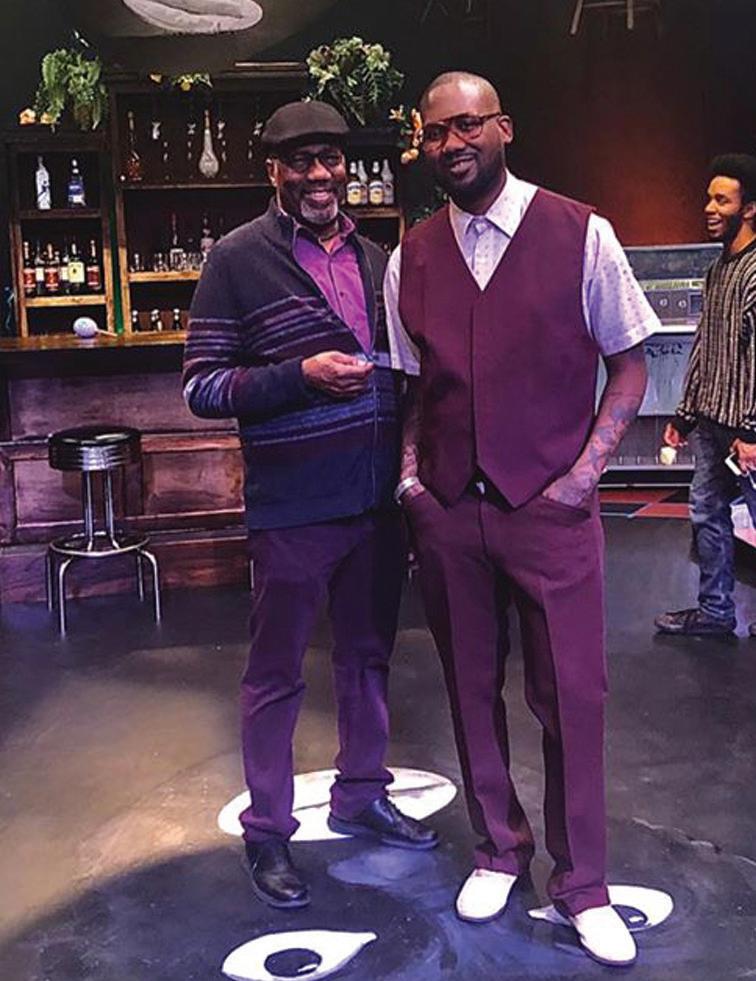
And for Poe, his fellow cast members, the play, playwright and the company producing it prompted him to deepen his appreciation of St. Louis’ rich cultural history.
“Playing this role has reminded me of the rich legacy of entertainment that comes from here – from playwrights to poets to singers,” Poe said.
“The blues, rock and roll – of all the things we don’t even claim that are so intertwined with our heritage [as cultural innovators]. I feel like when
expecting to do an up-tempo record, because that’s what mostly everyone was doing at the time,” Neville said of his breakthrough hit. “But I heard the song and said, ‘No, this is the one right here.’ And sure enough, it was.”
The single became an instant hit and is still beloved more than a half-century after its original release and is known the world over. The song set in motion a career that has transcended genres and cultures.
“Music is the international language,” Neville said. “We can be in Japan or someplace where they don’t speak English, but they understand the vibes coming from me. You don’t have to understand the words.
My voice connects to the people and gives both of us joy – it gives me joy to put it out and gives them joy to hear it, so it’s the total package.”
Neville credits his genuine love for singing as the secret to his success.
“I’m in heaven,” he said.
“They have a saying that ‘he who sings, prays twice.’ I don’t care what I’m singing – R&B, doo wop or country and western – it’s always spiritual to me.”
A decade after his initial solo success, he teamed up with his brothers Art, Charles and Cyril as the Neville Brothers.
They had been in bands since they were young, with one or two members of the
she wrote this character, Ntozake Shange wrote with a knowledge of that. You can feel those subtleties within the play and the character.”
The Black Rep’s presentation of Ntozake Shange’s “Spell #7” continues through March 8 at the AE Hotchner Studio Theatre on the campus of Washington University, 6445 Forsyth Blvd. Tickets are available at www.theblackrep.org/, or by calling the box office at (314) 534-3807.
Neville brothers in a band at any given time. But their uncle, George “Big Chief Jolly” Landry, recruited them all – along with Art’s band The Meters – to record the album
“The Wild Tchoupitoulas” in 1976.
“Then in 1977, we decided we would all come together as the Neville Brothers,” Aaron said. “Charles was living in New York and he moved to New Orleans. We got together and did that record with Uncle Jolly and did our first record in ’78 called ‘The Neville Brothers.’ From then on, we ran up and down the highway for 40 years spreading that music.”
He takes pride in knowing that he and his brothers represented New Orleans all over the world.
“From Australia and New Zealand to Japan and you name it, everywhere we went there was joy and having a great time listening to great music –world music that’s from New Orleans,” Aaron said. “Now my two older brothers are gone on to heaven, but me and are Cyril holding up the fort. And now our kids are doing it.”
The Aaron Neville Duo will play Powell Symphony Hall at 7:30 p.m. on Saturday, February 22. For tickets and additional information, visit www.slso.org or call (314) 5341700.



Nidec Motor Corporation St. Louis, Missouri 8050 West Florissant, St. Louis Mo 63136
Using exp w/Electromagnetic design concepts & permanent magnet motor design, apply theoretical & practical skills in electromagnetic motor design and development for precision motor brushless DC motor drive systems. Reqs: Bach’s or frgn equiv in EE. Send CV to Nicholas.Emas@nidec-motor. com. Please reference code: LL-01
Marian Middle School, an all-girls, Catholic school committed to breaking the cycle of poverty through a life-altering education, seeks the following for 2020-2021.
6th-8th grade social studies
teacher. Ideal candidates have certification, content area degree and 2+ years’ experience teaching adolescents from low-income backgrounds.
Administrative assistant. Ideal candidates have 2+ years’ experience in school office; are dependable, flexible, and welcoming, wtih strong communication and technology skills.
Send letter of interest and resume to broche@mms-stl.org. Applicants of all racial and ethnic backgrounds encouraged to apply.
Hiring Home Health Care Aids in the St. Louis City and County (314) 201-3200
POLICE OFFICER
City of Alton, IL
Accepting applications
ONLINE UNTIL 5pm April 8, 2020
For Requirements and Applications visit: www.cityofaltonil.com/careers
Written Testing will be held April 25th for those that qualify
Senior account executive who is highly sought after by reinsurance intermediaries and relied upon by SN management to develop and provide solutions for insurance company reinsurance purchases. Responsible for the production, selection, underwriting, processing, retention, profitability and other analysis of the Treaty Reinsurance (TRe) portfolio. To apply, please visit: https://www. safetynational.com/careers-page/
Bayer U.S. LLC’s St. Louis, MO, office seeks Cloud System Analyst to perform the design & build, continued feature development, daily operational support, & project management/SCRUM Master duties that support the advancement of our public cloud platforms. Apply at https://career.bayer.us, #105743.
Two Non-Exempt Part-Time Positions Primarily working during the week M-F Responsible for the safe transport of clients to and from non-emergency and medical trips in company-owned vehicles.
Requirements: Applicants must have at least:
• A High School diploma or G.E.D.
• Ability to communicate with seniors, staff and the general public
• Valid Missouri Drivers’ License with a clean driving record
• Be at least 26 years of age and older, reliable and dependable
• Knowledge of St. Louis City streets and neighborhoods
• Experience driving a passenger van preferred Hourly Rate $10.50
Please submit resumes to llane@nsyssc.com
Responsible for assisting and supporting the operational needs of the Valued Customer Experience (VCE) initiatives. Assist in the daily tasks necessary to support the overall VCE strategy and execution of initiatives. To apply, please visit: https://www. safetynational.com/careers-page/
Explore St. Louis has an immediate opening for a Human Resources Coordinator to assist the VP of Human Resources and perform highly confidential administrative tasks & services to support the effective and efficient operations of the HR Department. Essential duties include: maintaining employee files / records and documentation, conducting new hire orientations, assisting with job fairs, benefit enrollment and various employee events, processing bills, and supporting the Payroll Specialist. preferred. Bachelor’s degree in HR or HR experience is beneficial. Excellent organizational skills + attention to detail required. Effective written & oral communication is critical. Ability to work a flexible schedule including nights/weekends & holidays is necessary. Experience with HRIS & payroll systems including UltiPro & ADP is beneficial. Must possess a valid drivers license. To apply, go to https:// explorestlouis.com/job-opportunitiesinternships/ . NO PHONE CALLS!
Explore St. Louis is seeking a Mechanical Systems Manager to manage and oversee the activities of HVAC Techs & Stationary Engineers engaged in maintaining the building mechanical systems & associated building assets for the America’s Center complex. Overall responsibilities include: operation, maintenance & optimization, planning & coordinating the installation of new equipment, modifying & improving existing equipment, and ensuring that all preventive maintenance is carried out in a correct and timely manner. Required to work a flexible schedule including nights / weekends / holidays, and be on call 24/7. HS Diploma or GED required. Bachelor’s degree in related field and/or experience working in arenas, convention centers or stadiums preferred. Completion of an approved apprenticeship program in HVAC + Refrigeration systems & 5 yrs of Journeyman Level HVAC + Refrigeration experience is necessary. 4 to 7 yrs’ supervisory experience desired. To apply, go to https://explorestlouis.com/jobopportunities-internships/. NO PHONE CALLS! EOE.
The Missouri Historical Society has position openings for the following:
• Community Outreach Coordinator (African American History Initiative)
• Early Childhood and Family Programs Manager
• Early Childhood and Family Programs Coordinator
• Exhibition Design Fellow (1-year fellowship w/benefits)
Please visit www.mohistory.org under the “Current Openings” tab for position details and to apply. An Equal Opportunity Employer
The City of Jennings is accepting applications for Code Enforcement Inspectors, Correctional Officers, Public Works Street/Park Laborers, Court Clerk, Economic Development Coordinator, P/T Bus Driver, P/T Concession Stand Workers, P/T Umpires, & P/T Scorekeeper. Please see the full job descriptions online at www.cityofjennings.org. Applications are available at the Jennings City Hall or on the website at www.cityofjennings.org.
The City of Jennings is an equal opportunity employer. All applicants will be considered for employment without attention to race, color, religion, sex, sexual orientation, gender identity, national origin, veteran or disability status.
The Brentwood School District seeks to hire the following position
Principal responsibility is to manage the District’s financial operations and annual budget preparation. Position will have the sole responsibility for ensuring effective and efficient operation of accounting, financial planning, payroll and risk management, through establishing the finance and accounting policies and procedures for the District.
Position will supervise Accounts Payable Specialist and Payroll Specialist
For complete description and minimal qualifications and hiring timeline, please visit our district website www.brentwoodmoschools.org Click on the Join Our Team tab at the top of the page, review the Q and A section and proceed to the link in the middle of the page, Employment Opportunities. Position is open until filled, however review of applications and interviews will be completed per hiring timeline listed on our website. Please No Phone Calls. EOE.

Forest Park Forever has an opening for a Development Associate. Interested applicants should apply online at: www.forestparkforever.org/jobs.
Forest Park Forever is a drug free workplace in accordance with federal law.
Equal Opportunity Employer
Webster University has an opening for a CMS Representative. Please visit our website at https://apptrkr. com/1753331 for a complete job description. No phone calls please. We are proud to be an equal opportunity affirmative action employer. Women and minorities are encouraged to apply.
Responsible for various tasks related to: categorizing and imaging incoming mail, processing corporate mail, and storage duties. To apply, please visit: https://www.safetynational. com/careers-page/
Deaconess Foundation is looking for young adults, as Servant Leader Interns, who are committed to active lives of leadership and service for children. Servant Leader Interns will serve in the capacity of classroom facilitators for seven weeks serving children in grades kindergarten through five in the St. Louis region. More information is available at www. deaconess.org/applycdf. Applicants must upload a cover letter and resume by February 28, 2020 for consideration.
Metro Transit is committed to ensuring fair and equitable access to transit service and amenities, regardless of race, income, or English language proficiency. The public is invited to provide input regarding Metro’s Title VI Policy at one of four locations on the dates and times below.
Mon., March 2 from 4-6:30 p.m. at Carpenter Branch Library, 3309 S Grand Blvd, St. Louis, MO 63118
Tues., March 3 from 4-6 p.m. at Civic Center Transit Center, 401 S 14th St, St Louis, MO 63103
Wed., March 4 from 6-8:30 a.m. at Belleville Transit Center, 800 Scheel St, Belleville, IL 62221
Thurs., March 5 from 6-8 a.m. at North County Transit Center, 3140 Pershall Rd, St. Louis, MO 63136
is seeking a General Contractor for the Webster Groves School District; Alterations and Additions to Hixson Middle School. Sealed bids are requested from qualified contractors for additions and alterations to the school referenced above. A mandatory pre bid meeting will be conducted on Thursday March 5th, 2020 at 4:00 p.m. at Hixson Middle School. Bids will be received by Mr. Robert Steuber, WGSD Construction Project Manager, on Thursday April 2nd 2020 by 2:00 p.m., at the District Service Center Building, 3232 South Brentwood Blvd, Webster Groves Mo 63119. Public bid opening will follow immediately thereafter.
The Invitation to Bidders will be available online @ www.webster.k12.mo.us, (under RFP heading) Thursday February 27th, 2020. The owner reserves the right to reject any and or all proposals
The following people are in debt to Gateway Storage Mall of Belleville, Columbia, & Dupo. The contents of their storage unit(s) will be sold at auction to compensate all or part of that debt. Auction will be held online with Jersey County Auctions starting on March 4, 2020 at 9:00 am. A cash deposit will be REQUIRED for all winning bids.
DUE DILIGENCE
CONSULTATION
RFP 2020
The Saint Louis Zoo seeks bids from qualified contractors to assist the Zoo as a consultant in an evaluation of processes and experience as it pertains to the selection of a new Point of Sale System. Bid documents are available as of 2/19/2020 on the Saint Louis Zoo website: stlzoo.org/vendor
Great Rivers Greenway is seeking sealed bids for one (1) 2 Passenger Cargo Van. Go to www.greatriversgreenway.org/ jobs-bids/ and submit by April 03, 2020.
HillsboroTreatment Center,Hillsboro, Missouri,Project No.H1912-01will bereceivedby FMDC,Stateof MO,UNTIL1:30 PM,3/10/2020via M
. Biddersmustbe registeredtobid. Forspecificproject informationand orderingplans,go to:http://oa.mo.gov/ facilities
All are welcome. To request interpretation services, please call 314-231-2345 72 hours prior to the event you wish to attend. For more information about Metro’s Title VI Policy, please go to metrostlouis.org. LETTING #8717
Units Col. 30-Brian Killingsworth, Col. 48, 120, 126-Janet Gotto, Dupo 65-Jennifer Goforth, Dupo 89-Pudge Richardson, Dupo 105-Amanda Venus, Dupo 128-Twila Lambert, Dupo 148-Raymond Schlemmer, Dupo 401-Junior Macke, Dupo 403-Roy Venus, Bel. 217-Chris Ciszczon, Bel. 402-Debby Hedrick, Bel. 416-Angela Davis, Bel. 510-Marion Houston, Bel. 518-shawna Kindred, Bel. 532-Beverly Driver, Bel. 547-David Barth, Bel. 618-Aaron Muhamed, Bel. 633-Rachelle Russell, Bel. B01-Latrice Eiland, Bel. B05-Anissa Wilbourn, Bel. B08 & E01-Jonas Unaeve, Bel. B13-Chasity Orr, Bel. D21-William Collins, Bel. E05-Mary Owens, Bel. E10-Lamont Hudson, Bel. F08-Joe Vassen. Bel. G12-Breize White, Bel. G42-Shane McCottrell, Bel. H04-Erisha Moore.
For all rules, regulations and bidding process, contact Jersey County Auctions. All other questions, please call 618-744-1588 or mail 300 Rueck Road, Columbia, IL 62236.
ST. LOUIS COMMUNITY COLLEGE
St. Louis Community College will receive separate sealed bids for Contract No. F 20 503, Renovation for Nursing Simulation Lab, St. Louis Community College at Florissant Valley, until 2:00 p.m. local time, Tuesday, February 18, 2020. Bids will be publicly opened and read aloud at the office of the Manager of Engineering and Design, 5464 Highland Park Drive (Plan Room). Specifications and bid forms may be obtained from the Manager’s office, at the above address or by calling (314) 644-9770. Voluntary Pre-bid Meeting: 10:00AM, February 7, 2020, Florissant Valley, Renovation for Nursing Simulation Lab, Engineering Building, Room E161 An Equal Opportunity and Affirmative Action Employer
Curtiss-Manes-Schulte, Inc. is soliciting bids from MBE/WBE/ SDVE/DBE subcontractors and suppliers for work on the Sinclair School of Nursing, University of Missouri, Columbia, MO. Bids are due Thursday, February 27, 2020 by 1:00 pm and can be faxed to (573) 392-4527 or emailed to shawn@cms-gc.com. For more information, call Shawn @ (573) 392-6553.
Curtiss-Manes-Schulte, Inc. is an Equal Opportunity Employer.
FOR PROPOSAL STATIONARY CONVEYOR SYSTEM
RAIL UPGRADE, PHASE II-B
MUNICIPAL RIVER TERMINAL 14 NORTH MARKET STREET ST. LOUIS, MO, 63102
The City of St. Louis Port Authority will receive sealed bids for the installation of a stationary conveyor system at the Municipal River Terminal on 2/19/2020. For more info, visit https://www.stlouis-mo.gov/government/ departments/sldc/procurement/index.cfm

ST. LOUIS COMMUNITY COLLEGE
St. Louis Community College will receive separate sealed bids for CONTRACT NO. F 20 406, Classroom Renovation in L-024 at St. Louis Community College at Forest Park Campus, until 2:00 p.m. local time February 20, 2020. Bids will be publicly opened and read aloud at the office of the Manager of Engineering and Design, 5464 Highland Park, St. Louis, MO 63110-1314. Specifications and bid forms may be obtained from the Manager’s office, at the above address or by calling (314) 644-9770.
Voluntary PREBID MEETING: February 10, 2020 1:00pm, Forest Park, Library 1st Floor Entrance
An Equal Opportunity and Affirmative Action Employer
NOTICE TO CONTRACTORS Notice is hereby given that The Metropolitan St. Louis Sewer District (District) will receive sealed bids for Brunston Dr. #4875 Bank Stabilization under Letting No. 11623-015.1, at this office, 2350 Market Street, St. Louis, Missouri 63103, until 02:00 PM on Friday, March 13, 2020, at a place designated. Bids will be received only from companies that are pre-qualified by the District’s Engineering Department for: NATURAL CHANNEL STABILIZATION Plans and Specifications are available for free electronic download. Please go to MSD’s website and look for a link to “ELECTRONIC PLANROOM.” Plans and Specifications are also available for viewing or purchase at Cross Rhodes Reprographics located at 1712 Macklind Avenue, St. Louis MO 63110. All bidders must obtain a set of plans and specifications in order to submit a bid in the name of the entity submitting the bid. The Metropolitan St. Louis Sewer District is an Equal Opportunity Employer.
Great Rivers Greenway is requesting Bids for Riverfront Vendors - St. Louis City Riverfront Go to www.greatriversgreenway. org/jobs-bids/ and submit by February 28, 2020.
VACANT LAND FOR SALE OR LEASE 1014 Spruce Street, St. Louis, MO Request for Proposals: www.stltreasurer.org/ avada_portfolio/request-for-proposal-topurchase/
Notice is hereby given that the Metropolitan St. Louis Sewer District is proposing to procure: Microsoft Unified Support Service. The District is proposing single source procurement to Microsoft for this service because Microsoft is the creator and developer of this program/ service. Any inquiries should be sent to swassler@stlmsd.com.
Metropolitan St. Louis Sewer District is an Equal Opportunity Employer.
Notice is hereby given that The Metropolitan St. Louis Sewer District (District) will receive sealed bids for Louisiana and Holly Hills Storm Sewer under Letting No. 11522-015.1, at this office, 2350 Market Street, St. Louis, Missouri 63103, until 02:00 PM on Wednesday, March 18, 2020, at a place designated. Bids will be received only from companies that are pre-qualified by the District’s Engineering Department for: SEWER CONSTRUCTION – St. Louis City drainlayer’s license required Plans and Specifications are available for free electronic download. Please go to MSD’s website and look for a link to “ELECTRONIC PLANROOM.” Plans and Specifications are also available for viewing or purchase at Cross Rhodes Reprographics located at 1712 Macklind Avenue, St. Louis MO 63110. All bidders must obtain a set of plans and specifications in order to submit a bid in the name of the entity submitting the bid. The Metropolitan St. Louis Sewer District is an Equal Opportunity Employer.
Bids for Construct Solar Array, Macon Field Maintenance Shop, Missouri National Guard, Macon, Missouri, Project No. T1929-01 will be received by FMDC, State of MO, UNTIL 1:30 PM, 3/5/2020 via M i s s o u r i B U Y S . Bidders must be registered to bid. For specific project information and ordering plans, go to: http://oa.mo. gov/ facilities

RELOCATION OF FAA ASDE-X FACILITY AND AIRPORT BEACON at St. Louis Lambert International Airport
Sealed proposals will be received by the Board of Public Service, Room 208, City Hall, 1200 Market Street, St. Louis, Missouri, 63103 until 1:45 PM, CT, on March 17, 2020, then publicly opened and read. Plans and Specifications may be examined on the Board of Public Service website http://www.stl-bps. org (BPS On Line Plan Room) and may be purchased directly through the BPS website from INDOX Services at cost plus shipping. No refunds will be made.
REQUEST FOR QUALIFICATIONS FOR GRASS MAINTENANCE AND TRASH AND DEBRIS SERVICES
The St. Louis Development Corporation (“SLDC”) of the City of St. Louis is requesting qualifications for grass maintenance and trash and debris removal.
The complete RFQ can be viewed online at www.stlouis-mo.gov/sldc or picked up at the office of the St. Louis Development Corporation located at 1520 Market Street, 2nd floor in the Real Estate Department.
The funding of this project, is financed in part through a grant from the Department of Housing and Urban Development and the Community Development Administration under the provision of Title 1 of the Housing and Community Development Act of 1974 (Pub. L 93-383 42 USC 5301 et seq) and/or HOME Title II of the National Affordable Housing Act of 1990, as amended (Public Law 101-625).
McCarthy Building Companies, Inc. requests bids from qualified and certified MBE and WBE subcontractors and suppliers for the following project:
Washington University School of Medicine 4370 Duncan - Research Building and Garage Bid Package 3
For the following scopes of work: ELEVATORS
BIDS DUE: March 19, 2020 by 2:00 PM CST Contact: Mike Bax at mbax@mccarthy.com or 314-919-2215
Prequalification is required and can also be accessed through the McCarthy website above.
McCarthy Building Companies, Inc. is proud to be an equal opportunity and affirmative action employer.
Bidders shall comply with all applicable City and State laws (including MBE/WBE policies). Mandatory pre-bid meeting will be held on Tuesday, February 25, 2020, at 10:00 A.M. in the Ozark Conference Room (AO-4066) at the Airport Office Building, 11495 Navaid Rd., Bridgeton, MO 63044. All bidders must regard Federal Executive Order 11246, “Notice of Requirement for Affirmative Action to Ensure Equal Employment Opportunity”, the Equal Opportunity Clause” and the “Standard Federal Equal Employment Specifications” set forth within and referenced at www.stl-bps.org (Virtual Plan Room).
TO
Corporation is seeking proposals for the following project: University of Missouri Sinclair School of Nursing.
project includes demolishing the existing School of Nursing to construct a new building in its place. The new building is a 4 story building approximately 60,000 sf. The project includes but is not limited to the following scopes of work: Demolition, concrete foundations & flatwork, masonry, structural steel, carpentry, architectural woodwork, waterproofing, EIFS, air barrier, metal wall panels, membrane roofing, applied fireproofing, firestopping, joint sealants, doors/frames/hardware, sluminum entrances and storefronts, drywall, tile, acoustical ceilings, relilient flooring, epoxy-resin flooring, carpet, operable partitions, specialties, roller window shades, elevators, fire sprinklers, plumbing, HVAC, electrical, earthwork, asphalt paving, site utilities. All bids should be sent to bids@paric.com.
This project has a diversity participation goal of 10% MBE and 10% combined WBE, DBE, Veteran Owned Business and 3% SDVE.
Bids for this project are due on February 26th, at 1:00 p.m. For any questions or would like to find out more detailed information on this opportunity, please contact Evan Chiles at 816-878-6003 or emchiles@paric.com.
All bids should be delivered to Paric via e-mail (bids@paric.com) or fax (636-561-9501).
Great Rivers Greenway is requesting Bids for Office Moving Services. Go to www.greatriversgreenway. org/jobs-bids/ and submit by March 10,


Great Rivers Greenway is requesting proposals for Construction Management Services. Go to www.greatriversgreenway. org/jobs-bids/ and submit by March 5, 2020.
Great Rivers Greenway is seeking Bids for Resetting Tree Pit Pavers at Gateway Arch National Park. Go to www.greatriversgreenway.org/ jobs-bids/ and submit by February 24, 2020.







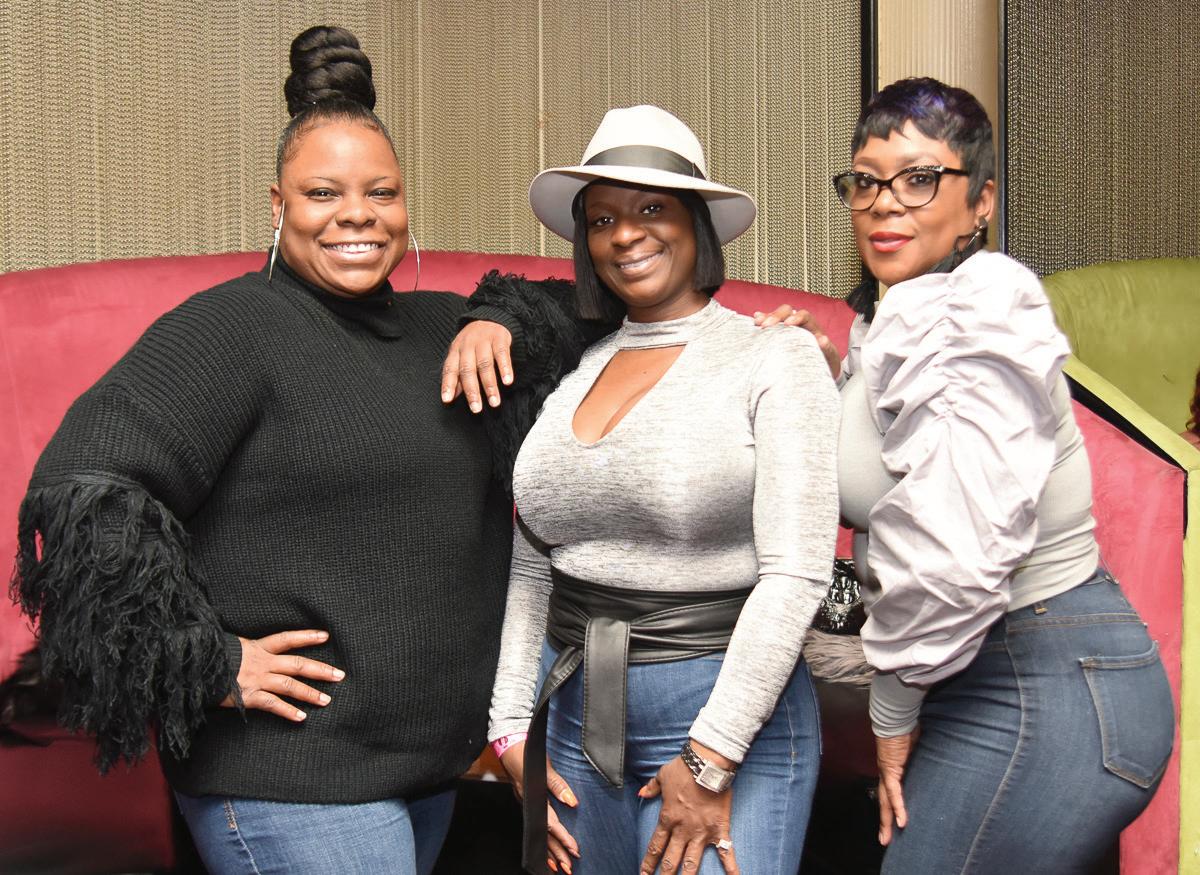
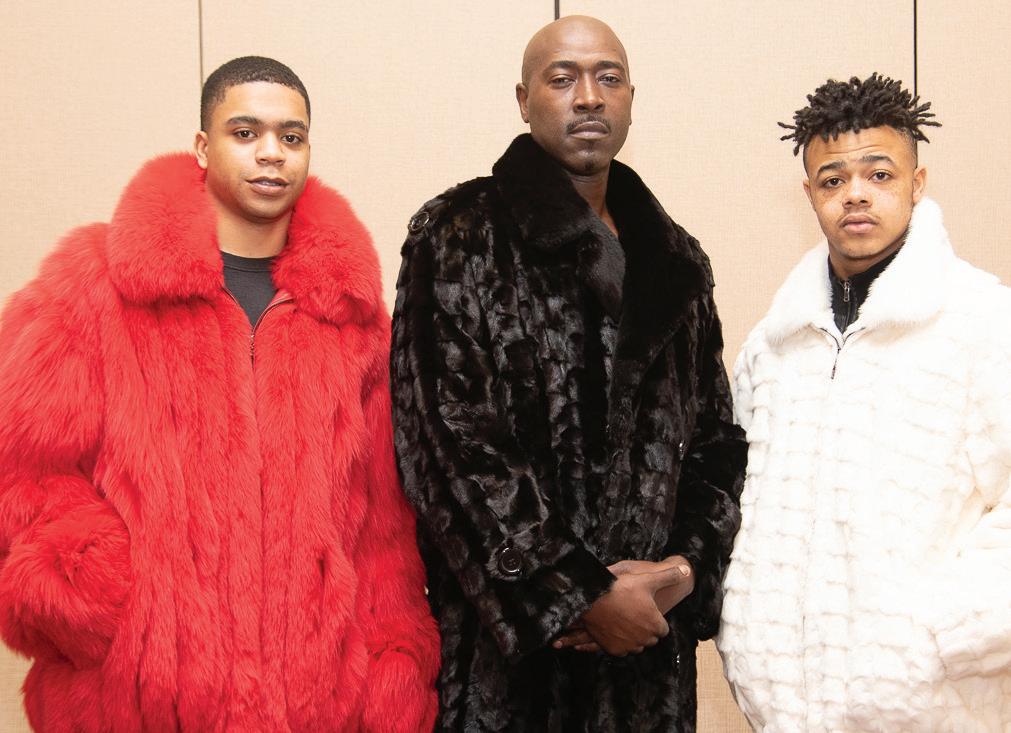
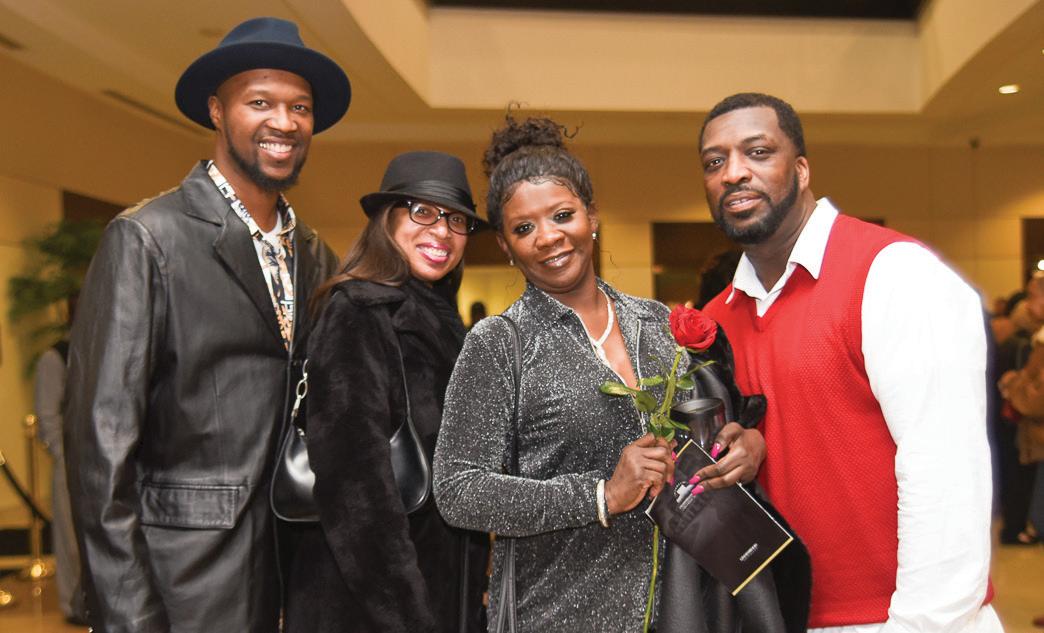

Tonight, we celebrate our love for Young Leaders. I know y’all are thrilled that I referenced a Roberta Flack and Peabo Bryson duet as the hour arrives for the St. Louis American Foundation to pay homage to a group of young people making a difference on all fronts in the metro area. I won’t take too much time with this today, since you should already be there. But I will say that if you are reading this between the hours of 4:30 and 5:30ish p.m. on Thursday, February 20 and are not at least on your way to the Four Seasons – put this paper down, go into your closet and hop into your best “corporate realness good clothes” and get yourself down here with us for the 10th Annual Salute to Young Leaders Awards and Networking Reception. We’ve got some name brand folks that we will honoring. Side note: see for yourself in the special section made just for this occasion. And mistress of ceremonies Rebeccah Bennett is ALWAYS good for an inspiring word. If you happen to be reading this earlier in the morning or afternoon, visit www.stlamerican.com or call (314) 533-8000 and get your tickets.
St. Louis Muted Festival. Listen, there are probably still some people at Chaifetz Arena waiting for Bobby Brown to sing “My Prerogative” after the St. Louis Music Festival turned into the concert that never ends with microphones we never heard. I must say that the folks were much more polite to these folks than they were to Master P and ‘nem, mainly because it was clear from the get that the issue was the sound and not the artist. A trusted inside source told me that the contractor sound company and engineers gave the promoter and stage manager the absolute blues with their “nightmarishly bad quality.” El DeBarge was up first and it was a mess. He didn’t look to be in top form and when the sound started tripping, he didn’t know how to recover. So he just sat there, sang here and there while playing keys over a few tracks and hit it. When they finally got the track to “Rhythm of the Night” to play, he cued it up to the “la la la la” part and two-stepped right off the stage. DJ Kut took his “keeping it real” game to new heights when he essentially said “we’ve all got somebody in our families going through the same thing, so treat him like our cousin and keep him in our prayers” before playing El’s finale all the way through. Speaking of Kut, if a promoter wants to skimp out on the sound for the artists, they better hire Kut as the DJ. I feel like he is the only reason why there wasn’t a lowkey revolt. Anyway. After waiting forever, Jagged Edge emerged. I think one of the twins was fighting off the coronavirus because he was sweating and coughing and had a towel wrapped around him like a shawl. They came out looking like the Snow Patrol from SuperFly 2.0. They did alright considering the microphones were in and out. Doug E. Fresh powered through and did his thing. But poor SWV wasn’t so fortunate. I feel like one of the sound people had it out for Coko, because for the first three of their four songs, her microphone wanted no parts of the performance. I say that it was a vendetta against her because Taj and Lelee’s mics would be working, and they would hand their mics to her, and when she would try to serve us that soprano, we got whispers. Lelee solidified her status as my favorite member of the group when she cussed the sound people out and read the other acts and the promoter for filth because they didn’t get a sound check. She accused another act, who she was gracious enough not to name, of lip syncing and said they should have been the ones with a soundcheck because SWV actually sings. Help. Then she let all the male performers on the bill know that she was none too pleased because they didn’t extend any type of Valentine’s gesture to them. I know it had to be frustrating to hit those little soft shoe steps knowing that folks couldn’t get into the singing – because there wasn’t any. If Coko was so mad she cussed on the mic, you know it had to be bad – because she has a gospel album. Anyway. Word on the curb is that there was also issue with who was going to close the show. Even though Teddy Riley and Blackstreet were the designated headliners, Bobby Brown reportedly made a fuss about closing the show. Which he did at 12:20 a.m. Aside from the audience – who was held against their will for at least two hours longer than we expected – Teddy and Blackstreet (including David Hollister, who sounded great) were victims in this as well. Because they gave a great show, but everyone was so bothered by the logistical nightmare that they couldn’t really get into it. And Bobby’s finale was short at least three of his hits. I guess it’s his prerogative whether he does the song or not. The promoters and the performers were not to blame, but suffering through that show was still traumatic. For me, the trauma was also rooted in missing every.single. other.place I had planned to attend and shout out among the many events being held in the name of love Friday night – which is why I’m so light on variety, as far as my recaps go for this week.
The Isley Brothers got it in. Listen, Ronald Isley made my heart skip a beat on the day after Valentine’s Day when he stepped out on to the stage Saturday at Lindenwood with a three-piece suit made from my grandmother’s Christmas tablecloth with matching top hat and shoes. I was able to get my whole life from the fact that he opted out of a suit shirt and was serving us shoulders, elbows and upper chest so seductively I could barely focus. His voice has seen better days, but the performance sold me on absolutely everything about that show – including Ernie’s sickening guitar solos. They did all the hits – except for anything Mr. Biggs related, which is understandable considering the current status of the collaborating partner in that persona. But the Isley Brothers don’t owe me a thing for that show! It’s easy to forget our icons’ musical contributions when you don’t have them packaged together on the regular. The singing, the dancing, the praise break... I was checking for all of it. And his wife and her sister threw down as backup singers. And I was thrilled to my core that Ronald gave his ex, St. Louis’ own Angela Winbush (his ex-wife and the reason he still resides here to this very day) a shout out for her songwriting contribution to the group!
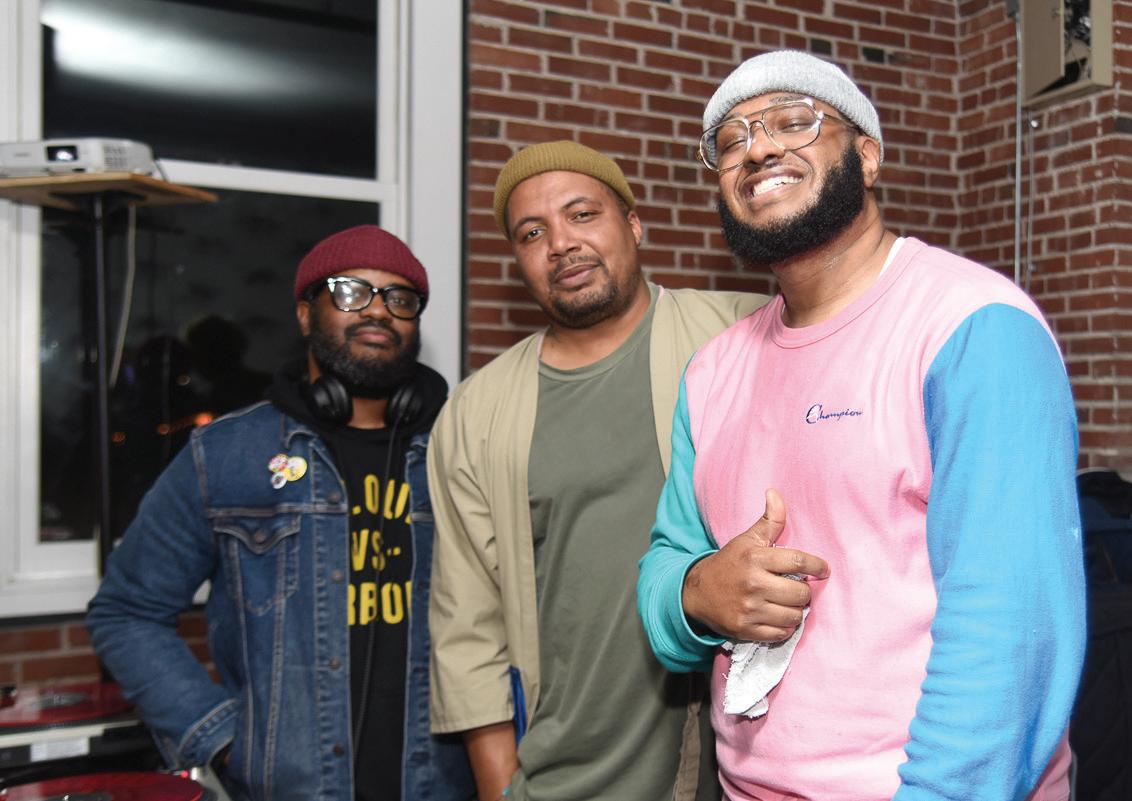

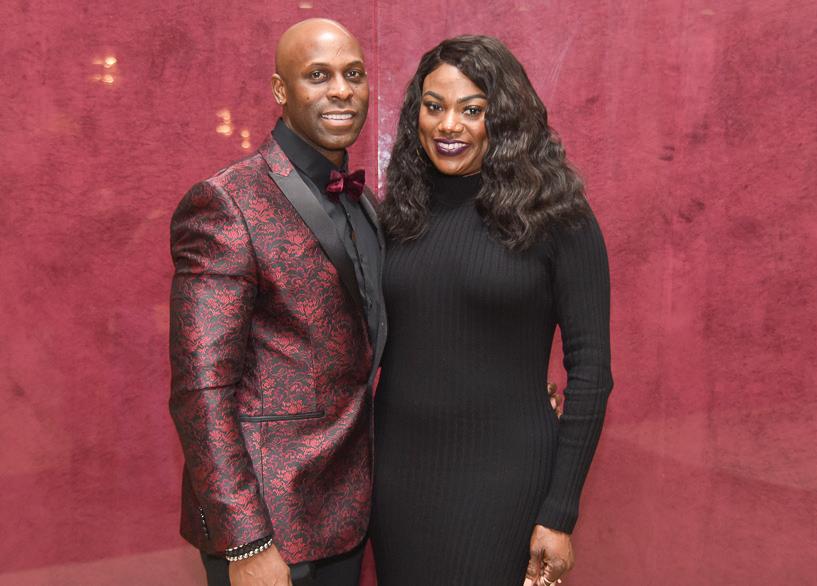

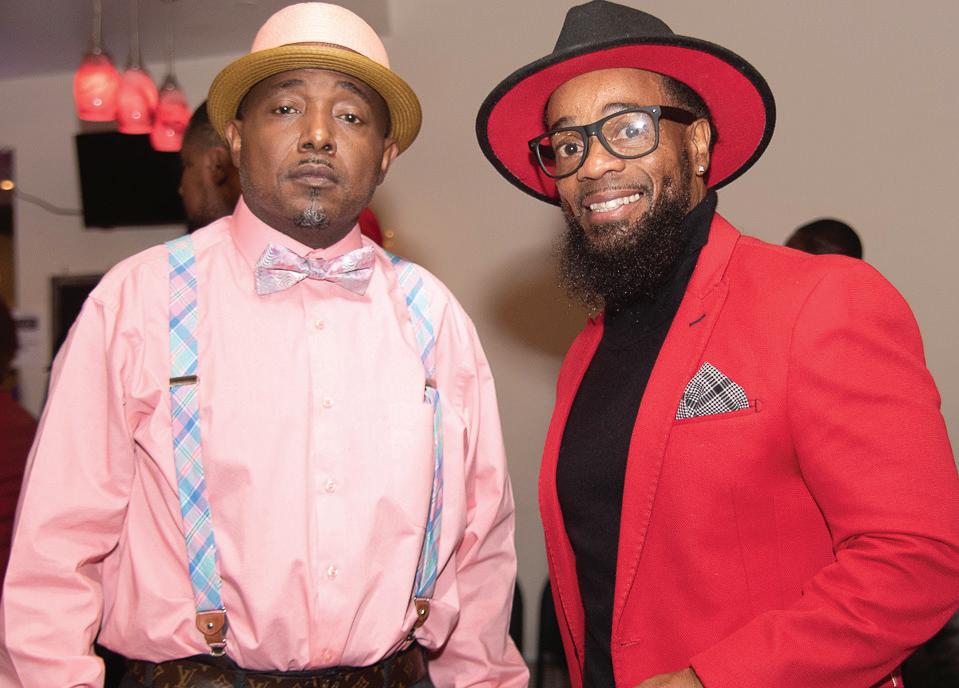


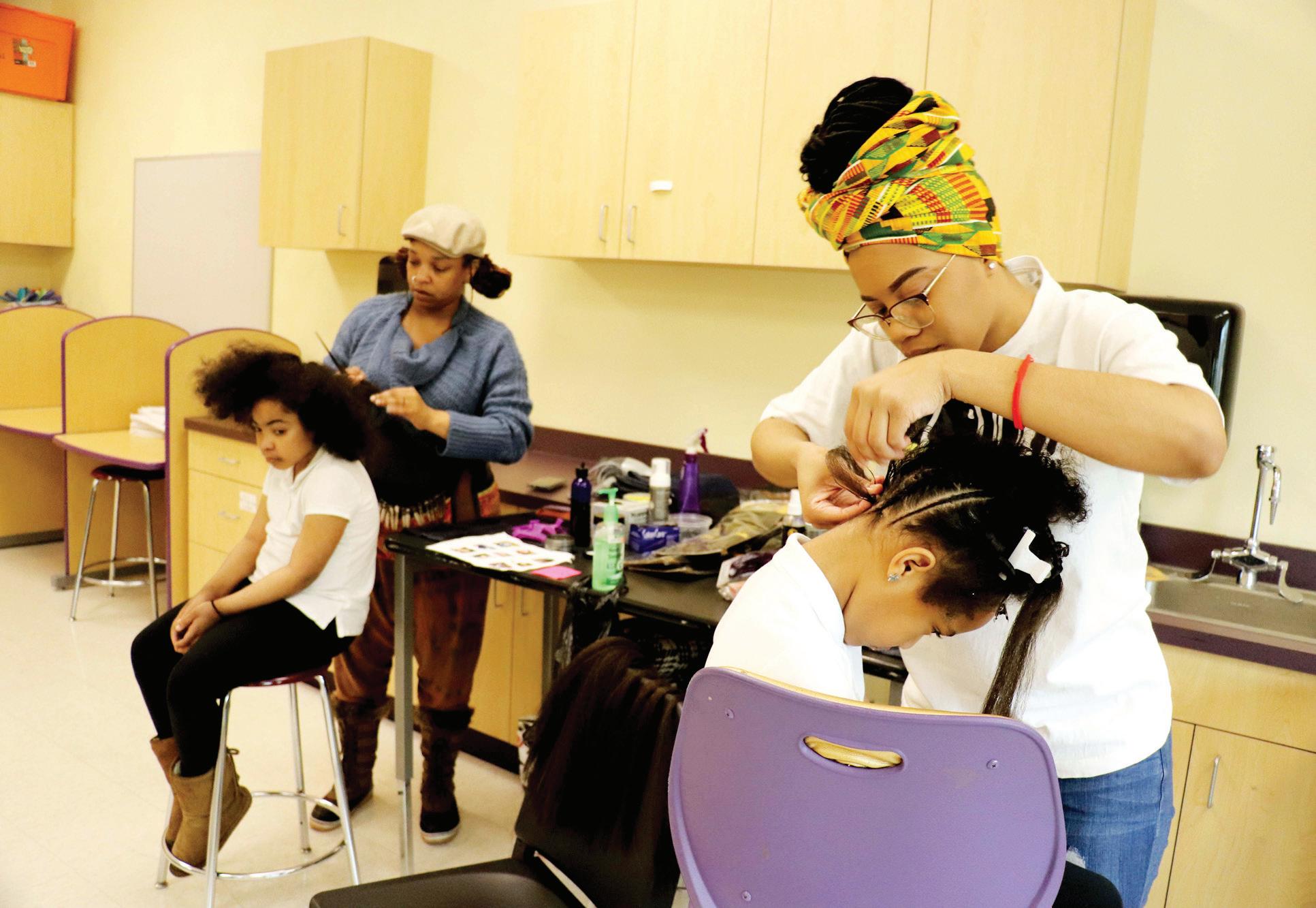
Stylists Kelly Lonise and Aliyah “Lele” Bell with The Uhuru Salon worked on students Barack Obama Elementary School in the Normandy Schools Collaborative as part of a 2019 Black History Month segment on Madam C.J. Walker and her historic contributions to the hair care industry. Jameca Falconer, a counseling psychologist and Webster University adjunct professor, said that contributions of women like Madam C.J. Walker are often left out of Black History Month presentations.
Photo courtesy of Normandy Schools Collaborative
By Andrea Y. Henderson
For St. Louis Public Radio
St. Louis Public Radio’s Andrea Y. Henderson spoke to Jameca Falconer, adjunct professor and director of Webster University’s Applied Educational Psychology and School Psychology program, about current ways to teach black history and what aspects of African-American history should be highlighted more. This interview was edited for brevity and clarity.
Andrea Henderson: Where would parents or educators start when talking about the many contributions of black people?
Jameca Falconer: Most of that would depend on the age group that you’re speaking to. So, if you’re dealing with little children, you would
U.S. Navy veteran and successful business owner reflects on lessons learned
By James E. Williams Jr.
For The St. Louis American
This summer, in formal ceremonies in Pensacola, Fla., the U.S. Navy will commission and launch a new ship named for our community – the seventh USS St. Louis in American history. So what? you might wonder. What difference does that make to me? A lot more, in my view, than you might think.
Many people today know me through my role as a businessman who owns 20 McDonald’s restaurants in the St. Louis area. Many fewer know that one of the reasons I’ve become a successful businessman is the eight and one-half years I served in the U.S. Navy. I was lucky as a kid to have been exposed to many outstanding people, starting with my dad, James Williams, the first African-American mayor of East St. Louis, and my mom, Lillian
Presenting sPonsors
have to start with the basics like, “Who are you?” “What color are you?” “Do you know that is a race?” and “Do you know that you’re different from the next person, and why?” Then, as you go up in ages, like middle schoolers and high schoolers, you can talk about more complex theories, ideas and movements that maybe younger children wouldn’t understand. But it really depends on the perspective of the person. Henderson: What’s a comprehensive approach to teaching black history that’s not repetitive or uneventful?
Falconer: The only way you can have a really complex understanding of the role of African Americans is to look at black people all across the span of every area. So that’s the arts, that’s music, that’s literature, that sports. It’s really everything — education and politics. You
have to look at all the pieces and not just focus on one era, which most people do, and it tends to be the Civil Rights Movement.
Henderson: What are some specific topics that you feel you must discuss when teaching black history?
Falconer: Starting from the beginning, slavery. When and why did African Americans come to this country? When you start there, it really kind of paints the picture of the whole rest of the story. Talk about the Middle Passage and what that was like, and then you would probably go up through some other political parts of that, like the Underground Railroad, the 14th and 15th Amendments, Voting Rights Act and Civil Rights Movement. Then talk about different
See History, D3

Croom Williams, a teacher. I was influenced by many mentors such as Dr. Benjamin Davis, a dentist and McDonald’s franchisee himself. I also had the advantage of an excellent education. But even with those advantages, the Navy had
plenty to teach me. Part of it, of course, was the travel. The Navy takes you all over the world, providing you an invaluable education about
See St. Louis, D2
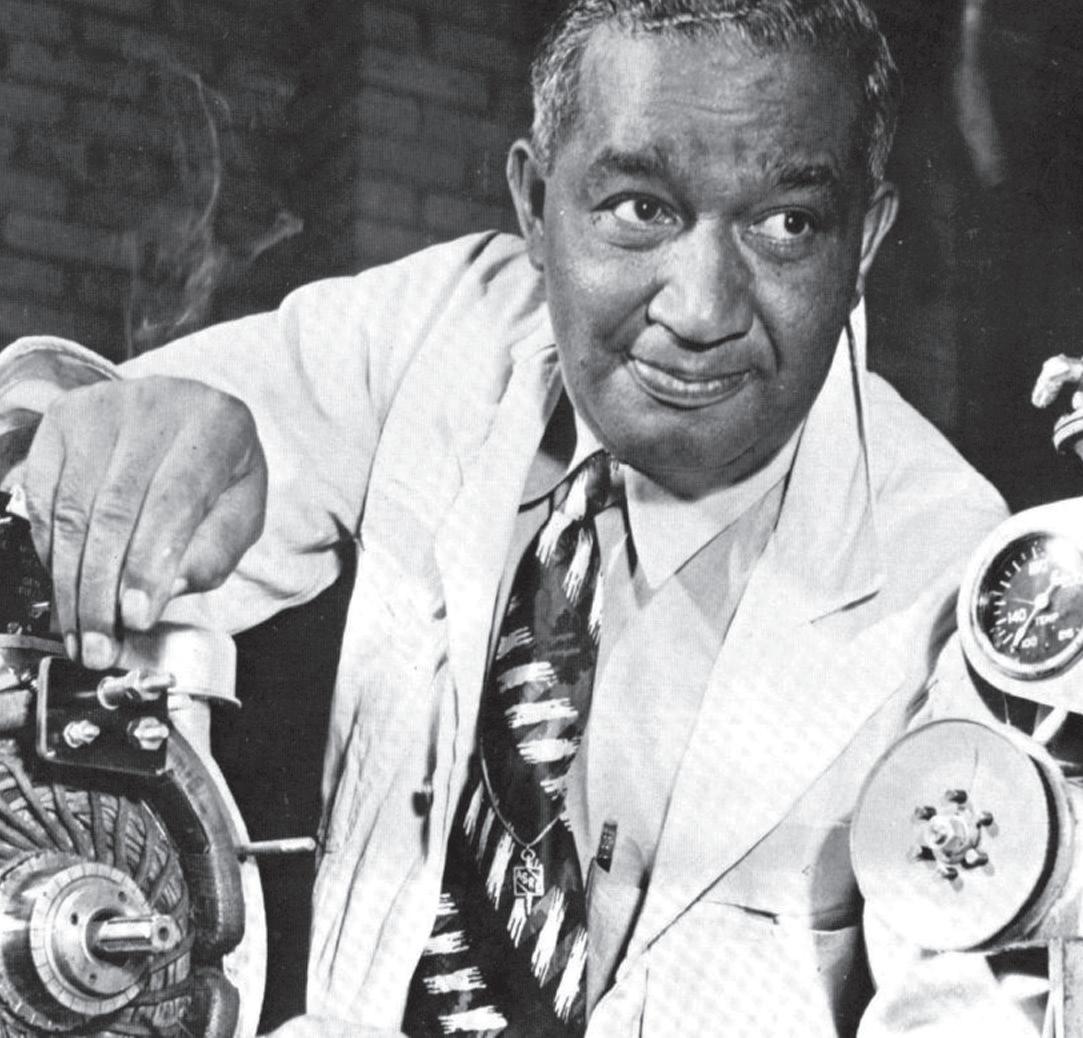
Frederick McKinley Jones, invented a container making it possible to store blood for battlefield use.
Dr. Charles Drew discovered the process, Frederick McKinley Jones invented cooling systems
By William L. Clay For The St. Louis American
An African American, Dr. Charles Drew of Howard University, discovered the process for preserving blood, which made it possible to establish blood banks. Another AfricanAmerican inventor, Frederick McKinley Jones, invented a container making it possible to store blood for battlefield use. Jones designed the special refrigeration unit that kept blood serum fresh for transfusions and medicines.
Jones was one of the most prolific inventors ever, black or white. He patented more than 60 inventions in his lifetime. While more than 40 of those patents were in the field of refrigeration, in addition to the procedure for blood plasma, he is also famous for inventing an automatic refrigeration system for longhaul trucks and railroad cars.

Dr. Drew was an AfricanAmerican surgeon who pioneered methods of storing blood plasma for transfusion and organized the first large-scale blood banks in the world. He made some remarkably groundbreaking discoveries in the storage and processing of blood for transfusions.
Dr. Drew set up the blood bank for Great Britain and was credited by the government with saving the lives of thousands of English people maimed by bombs and shrapnel from the nightly air raids of Hitler’s bombers. In 1941, British leaders cabled him that they were eternally grateful for his contribution and, now that their own blood banks were operative, his services were no longer required.
As U.S. involvement in the war loomed more certain each day, the National Research Council of the Red Cross recognized the need to establish its own blood bank program and in 1941 hired Dr. Drew to develop and administer the monumental task. He was called upon to undertake the mammoth operation. But deep-seated racism in American society dictated otherwise. Otherwise. The U.S. War Department declared, “It is
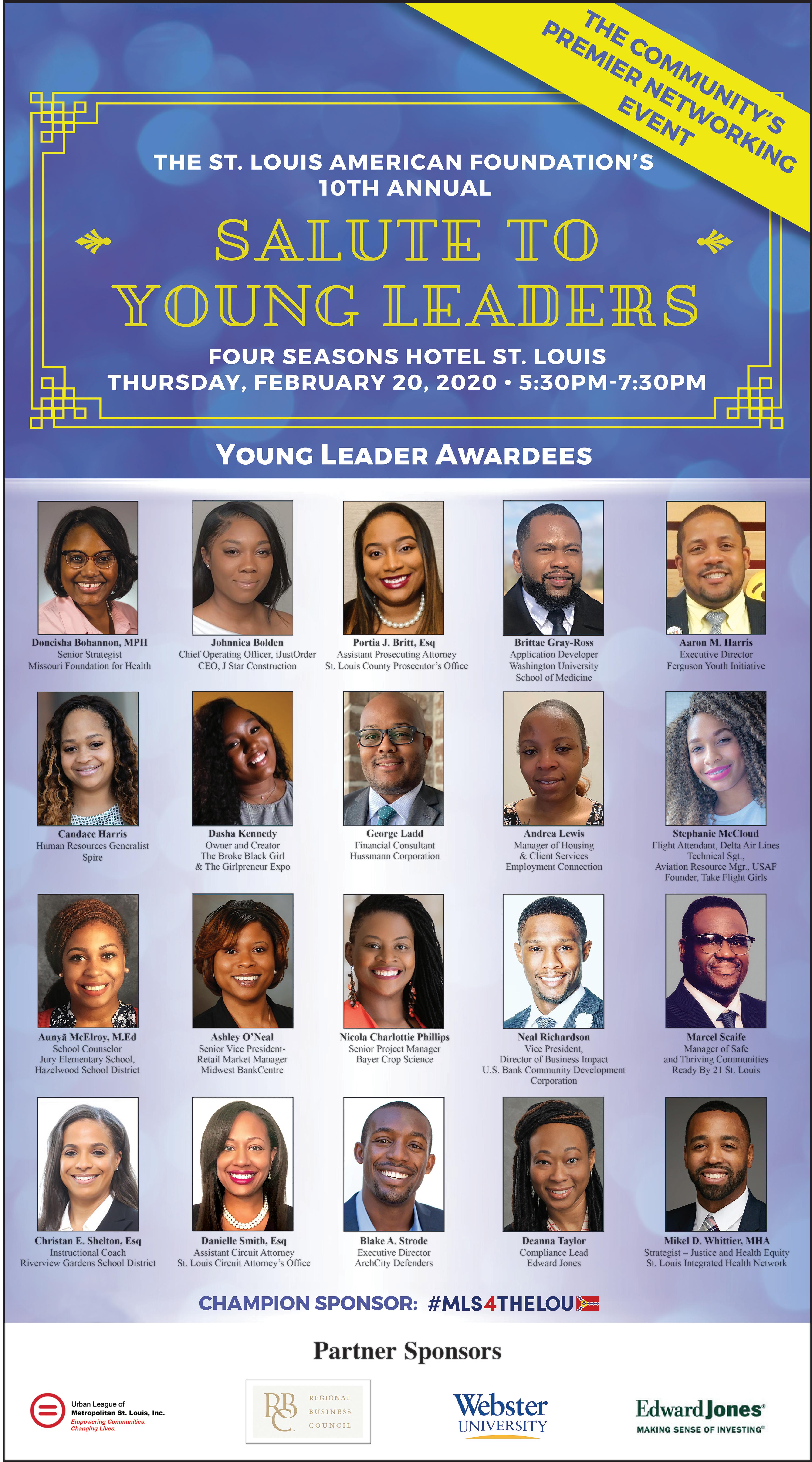
not advisable to collect and mix Caucasian and Negro blood indiscriminately for later administration to members of the military forces.”
Initially, the Red Cross sided with most renowned scientists and the American Medical Association in support of the fact that there was no factual basis for segregating blood by race. Leaders of both groups concluded, “No soldier bleeding and about to die on the battlefield is going to arise from the operating table and say, ‘Stop, doctors! Wait a minute! If you are not absolutely positive that not one single drop of that blood is from a Negro – let me die.’”
But bigoted members of the mass media and elected officials, including President Franklin D. Roosevelt, objected to the proposal. Unfortunately, several weeks later, the Red Cross, caving-in to demands of political racists, sided with reactionary racist forces who claimed that the “red blood from white Americans differed from the red blood of black Americans.” The Red Cross withdrew its offer to Dr. Drew.
Dr. Drew protested the segregation of blood and resigned his position as director of the Red Cross Blood Bank Program.
“I watched my own blood bring life to a dying white man. He wasn’t poisoned, and he didn’t turn black. I have examined the blood of every race and every nationality conceivable, examined it in every way known to science, and I can assure you there is no difference,” Dr. Drew wrote in his letter of resignation in 1942.
“When you came to me in the beginning, you didn’t say I was the best Negro for the job. You said I was the best man for the job. But how can I, a Negro, stay on as medical director of a program in which
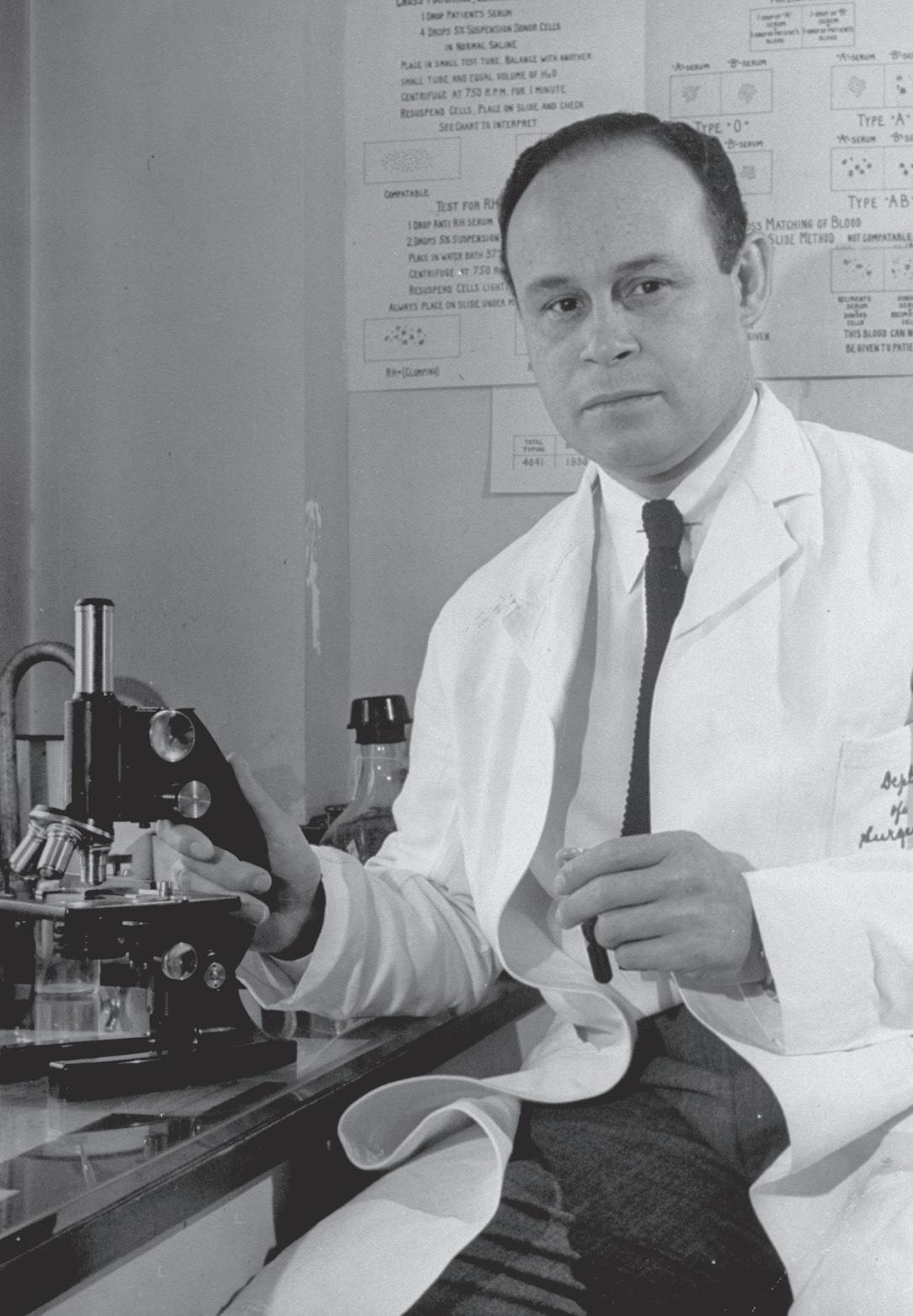
Dr. Charles Drew discovered the process for preserving blood, which made it possible to establish blood banks.
n “I watched my own blood bring life to a dying white man. He wasn’t poisoned, and he didn’t turn black.”
– Dr. Charles Drew
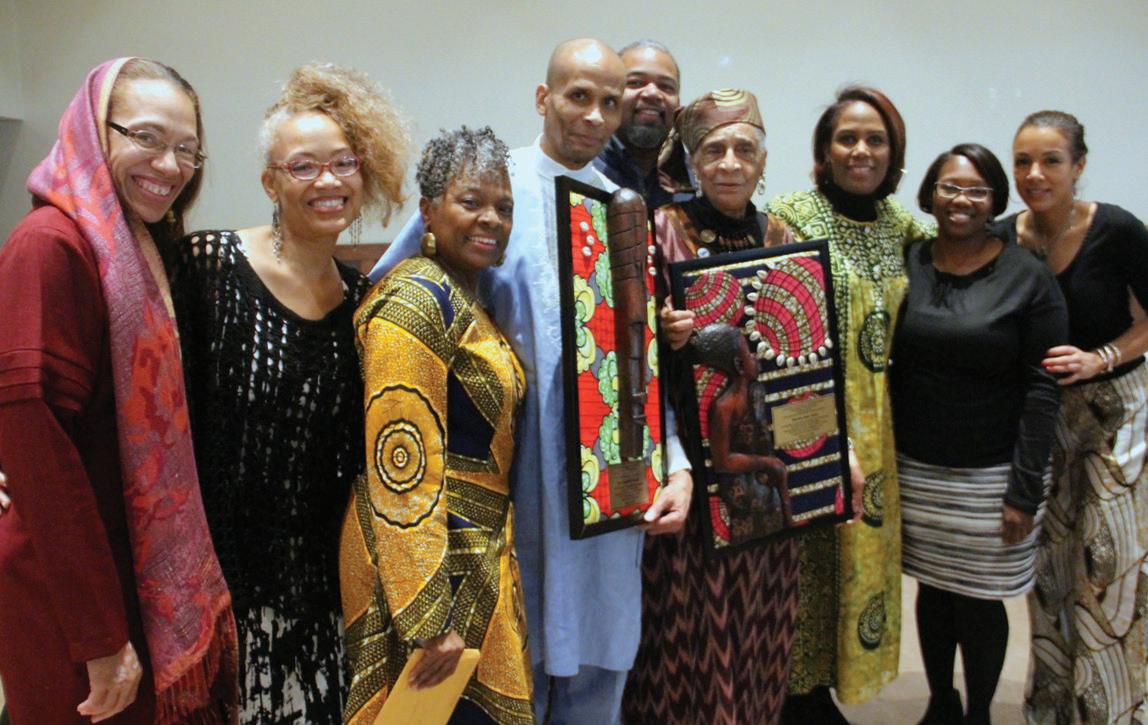
The Organization for Black Struggle celebrated its 40th anniversary on Saturday, January 25. The group, which rose to national prominence during the Ferguson uprising, was founded in 1980 by a group of students, veteran activists, and union
Continued from D1
types of activism and the ways we really have progressed and talk about some of the ways that we haven’t as a culture.
Henderson: Do you feel that it is necessary to talk about African life pre-slavery?
Negro blood is not wanted or at best is segregated?” Not until 1949 did the U.S., military stop the segregation of banked blood.
William L. Clay represented Missouri’s 1st Congressional District from 1968-2000 and is the author of “Clarence Thomas: A Black Knight in Tainted Armor,” “The
Jefferson Bank Confrontation,” “Bill Clay: A Political Voice at the Grass Roots,” “Racism in the White House: A Common Practice of Most United States,” “Just Permanent Interests: Black Americans in Congress, 1870–1991” and “To Kill or Not to Kill: Thoughts on Capital Punishment.”
Centene Corporation presents
Falconer: I think it could be crucial, but I’m not sure that it’s as necessary when talking about some of the major facts that have occurred in this country.
Henderson: Do you feel that is the parent’s responsibility to teach black history?
Falconer: I think the responsibility of teaching black history should be on the parents, teachers and the community. And I feel like the community does not do a really
good job of it. I don’t feel like all the responsibility should fall on teachers because children are only in school eight hours a day, and they are at home the other 16 hours of the day. And for most parents and families, I don’t feel like this should only be going on in February. It really has to occur all yearround.
And for parents who are not African-American, your children have to see you discussing these issues all yearround. Not just in February, but summer, fall and winter. Your children have to see you interacting with black people. They have to see you connecting with other groups of people in order for the lessons to stick.
Henderson: Are there any other aspects that you believe should be highlighted when it comes to Black History Month that we normally forget to
discuss?
Falconer: I think what they leave out are a lot of the women, women like Harriet Tubman, Sojourner Truth and Madam C.J. Walker. Now they talk more about some of the scientists like Katherine Johnson with the movie “Hidden Figures,” but before that, there was really no mention of [women].
Andrea Y. Henderson is part of the public-radio collaborative Sharing America, covering the intersection of race, identity and culture. This initiative, funded by the Corporation for Public Broadcasting, includes reporters in Hartford, St. Louis, Kansas City and Portland, Oregon. Follow Andrea on Twitter at @drebjournalist. Edited for length and reprinted with permission from news.stlpublicradio.org.
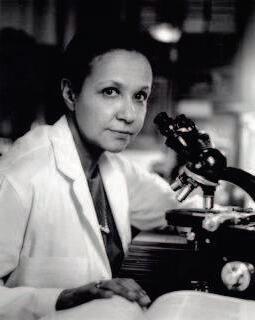
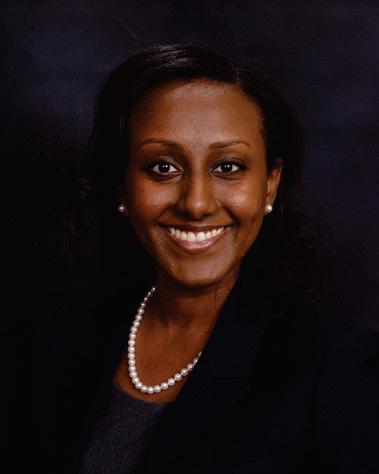

Her Life
Jane Cooke Wright was born November 20th, 1919, in New York City, New York. It is fair to say that Wright was born with medicine in her blood. Her father, Louis Tompkins Wright, was one of the first African Americans to earn a medical doctorate degree from Harvard Medical school
and her grandfather, Dr. Ceah Ketcham Wright, was born into slavery, but later became a doctor.
In 1945, Jane Cooke Wright graduated from New York Medical College with honors. She then spent her internship as an assistant resident in internal medicine at Bellevue Hospital.
After leaving her first residency position at Bellevue, she worked directly with her father who was director of the Cancer Research foundation at Harlem Hospital. After his death, she sat in his directorial seat for the foundation, being appointed director in the year 1952.

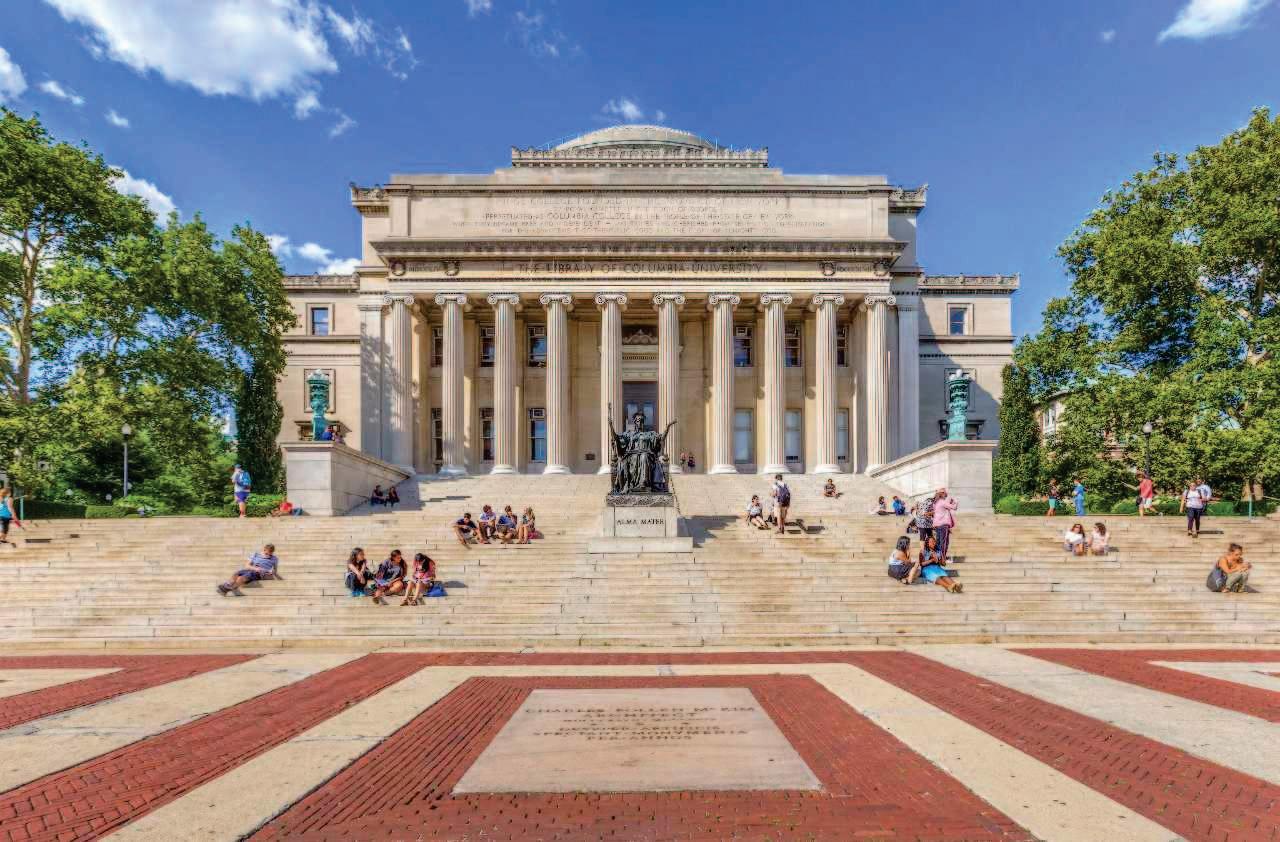


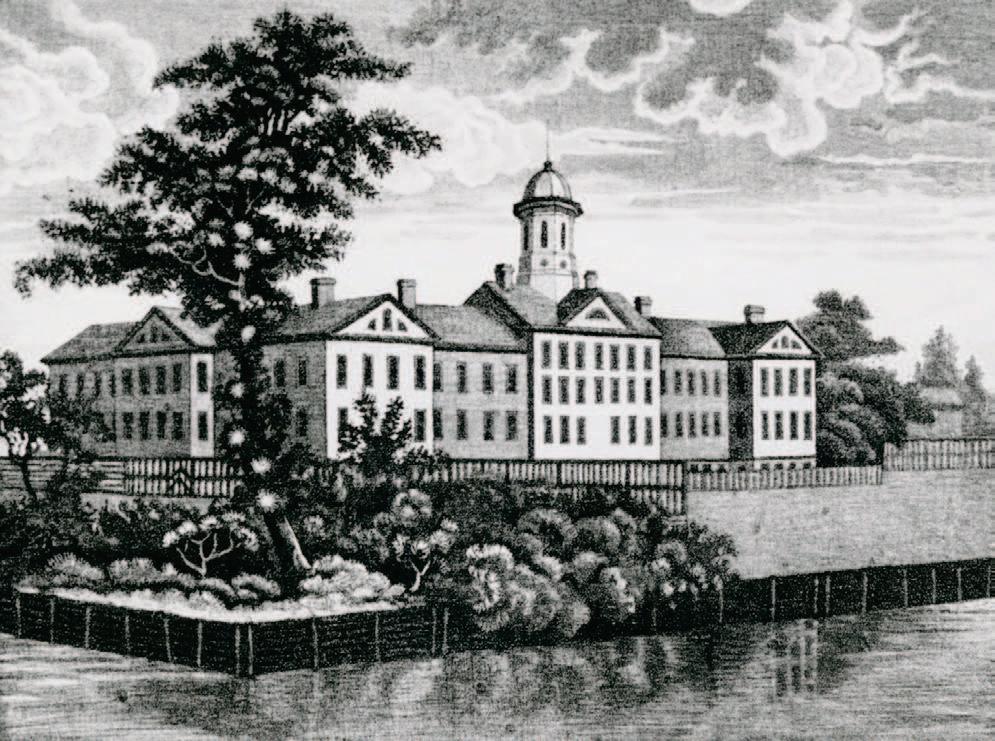
Wright simultaneously served as both director of cancer chemotherapy research and associate professor of surgical research at New York University Medical Center in 1955. It was here that she pioneered her chemotherapy breakthroughs, and developed a methodology we now call the concept of "precision medicine." Cancerous tumor cells are biopsied from a cancer patient and tr patient and treated with different cancer treating drugs in sep drugs in separate cultures to determine which drug may best drug may best treat an individual patient. This was revolutionary for research.absolutely revolutionary to cancer research. research globally.
In 1957, Wright traveled the world, leading oncologists to four other countries to treat cancer patients. This international medical work continued for the rest of her career.


St. Louis native scholar’s biography of activist singer published in French translation
By Malaika Horne and Gwen Moore
For The St. Louis American
St. Louis native, scholar and activist Gerald Horne was recently honored in Paris, France on the occasion of the launching of the French translation of his 2016 biography “Paul Robeson: the Artist as Revolutionary.”
His two sisters, Malaika Horne and Gwen Moore, both still residing in St. Louis, joined him in Paris to support him and experience the profound appreciation Parisians have for Robeson’s influence on the world stage. They also lauded Gerald Horne’s intellectual heft and tireless work ethic in churning out so many important books covering African-American history. Gerald Horne, who has written more than 30 books and 100 articles, is an endowed professor at the University of Houston, holding the John J. and Rebecca Moores Chair of History and African American Studies. He was approached by the French publishing house, Otium, with the request for the translation for the Paris 2020 concert and festival paying tribute to Robeson. A group of women expatriates, many African Americans, called Sistah Circle Paris, also supported the festival. Robeson – the noted African-American actor, singer and political radical who fell victim to the red scare of the 1950s – is widely regarded in

France for his uncompromising fight against racism and social injustice and for his vocal advocacy of workers’ rights and international socialism.
During the week-long series of events throughout the region, held January 21-25, Horne gave several presentations on Robeson and his legacy, was interviewed on French radio and participated in multiple book signings. One was in the suburb of Ivry, renowned for its left-wing activism. Horne also had a book signing at the Robeson concert at the Théâtre Romaine Rolland
in the midst of a city-wide transportation strike. Union workers reportedly gave the concert a pass and publicly announced it would not be boycotted. More than one thousand attended. Eric Bibb, a well-known African American expat residing in Sweden, sang blues and played the guitar along with his trio and his Swedish wife, who also sang. Bibb is the godson of Robeson. Horne’s powerfully written biography, “Paul Robeson: the Artist as Revolutionary,” argues that Robeson, who lived from 1898 to 1976, at the height

of his fame was probably the “best known American in the world.” Celebrated as much for his left activism as his artistic and intellectual gifts, Robeson ran afoul of the House Un-American Activities Committee and cold warrior U.S. Senator Joseph McCarthy, resulting in the loss of his career and the muting of his voice.
Horne rescues Robeson’s legacy, maintaining that he deserves as much recognition and attention as his successors Malcolm X and Martin Luther King Jr. In fact, Horne contends, one cannot truly understand the lives and trajectories of those two men without recognizing Robeson’s role in the history of the freedom struggle.
Horne, who was born and raised in the working-class communities of Mill Creek and North St. Louis, traces his own intellectual and political development and interests to those rich and nurturing black environments.
Both Malaika Horne and Gwen Moore were thrilled to visit Paris and be part of the flurry of activities recognizing Robeson and Gerald Horne’s work. They even snuck in some shopping and toured some of the city’s most iconic sites, including the Eiffel Tower.
Malaika said, “I’ve been to Paris several times, but this is the first time I had an insider view of the progressive elements of this very sophisticated and international city.” Gwen added, “We’re very proud of our brother. It was a trip of a lifetime.”
Malaika Horne is a director at the University of MissouriSt. Louis’ College of Business Administration. Gwen Moore is a curator and historian at the Missouri History Museum.
Morehouse is first HBCU with a certified polo team
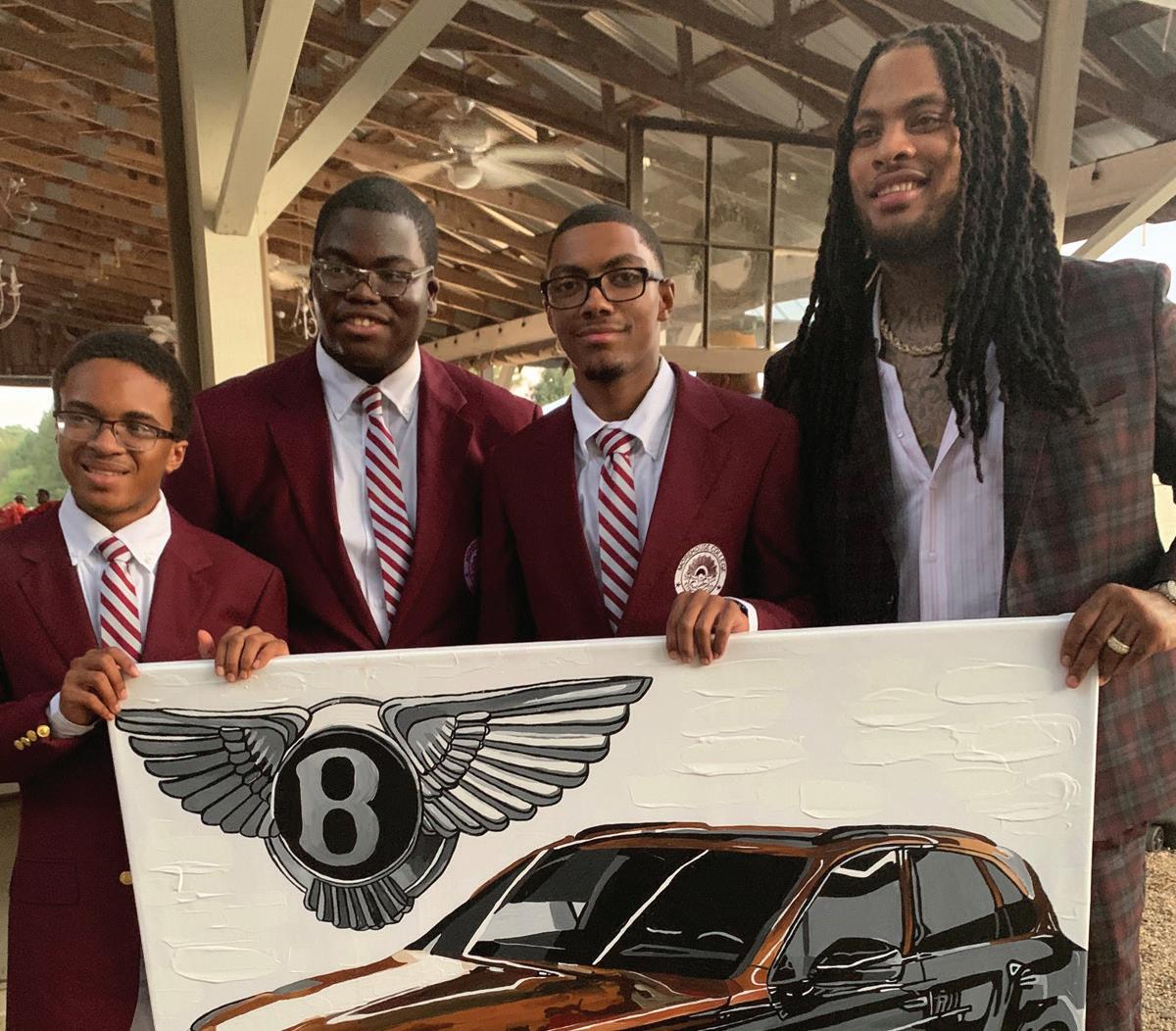
The Morehouse College Polo Club has received official notice from the United States Polo Association of their membership into the organization, making it the first Historically Black College & University (HBCU) to have a polo team.
“We would like to officially welcome Morehouse College to the I/I Family! Morehouse is in Atlanta, and will be playing out of The Atlanta Regional Polo Center with Jolie Liston and Frankie Questel,” said Amy Fraser, director Intercollegiate/ Interscholastic Polo, in a letter addressed to the Morehouse Polo Club.
Co-founded by Atlanta entrepreneur Miguel Wilson and Morehouse students Rian Toussaint, Justin Wynn, Jayson Palmer and Caleb Cherry, the Morehouse Polo Club was started in 2019 due to the help of Wilson’s Ride the Olympics Foundation.
The idea originally came from Cherry’s polo coach,
who suggested that he start a team at Morehouse. A veteran equestrian, Cherry competed in dressage for 10 years before and started playing polo five years ago. He’s the only player on the team with prior experience with horses.
Through Ride to the Olympics, the students received scholarships that support their membership of the Morehouse Polo Club, giving them access to horses, riding lessons and appropriate gear; allowing them to compete against other polo teams, both domestic and international.
“Just so there is no confusion: this is the first HBCU team in history,” Wilson said.
Last September, Wilson’s foundation raised additional funds for the team through its annual Atlanta Fashion & Polo Classic event, where high-profile Atlantans and celebrities attended to support the Morehouse Polo Club.
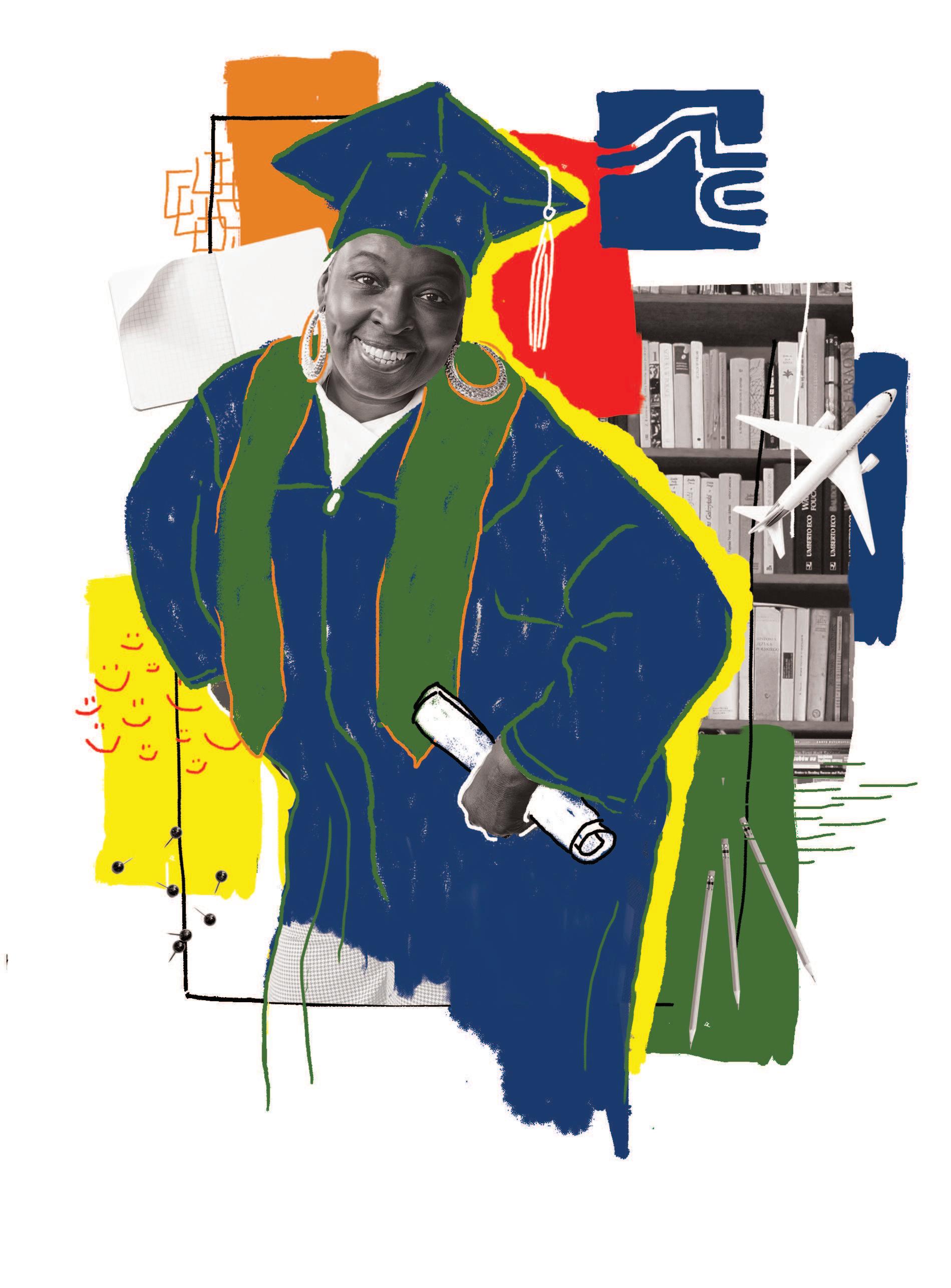
access for our diverse communities. STLCC celebrates African American History Month with a large variety of events open to the



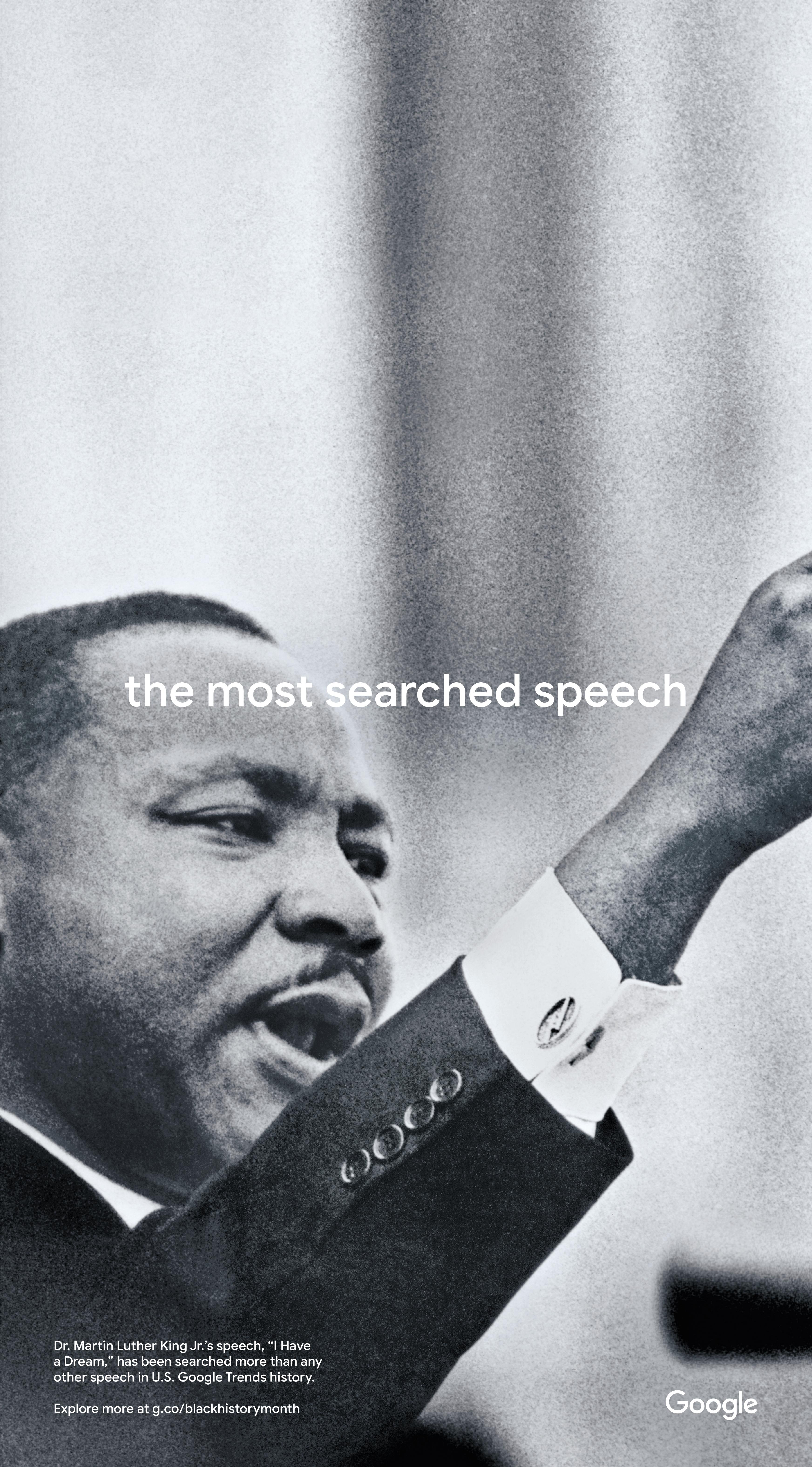

Continued from B1
other cultures and perspective on our own country.
But the Navy also instills values and character traits: Service to a greater good, a sense of concern and responsibility for one’s peers, discipline, preparation, respect, how to follow, how to lead. Day after day during my nearly decade-long tenure in uniform, all of these were drilled into me. I couldn’t help but absorb them.
All this was equally true, if not more so, for young men and women who hadn’t had the advantages I’d had. One of the great things about the Navy is that it will meet you wherever you are to work its magic.
And when I say magic, I am not using the word lightly. I left the Navy in 1995. Yet when one of the many friends I made in those years sent me a text message a few weeks ago, he addressed it to me as “Shipmate.” That tells you how deep and permanent the bond was that formed between us all those years ago.
Our city, our AfricanAmerican community, and our nation all need those kinds of bonds more than ever. In these days of racial and political polarization, we need people who can see the humanity in others no matter what their views. The Navy teaches you to think and feel that way. It also offers an education in the kinds of skills that are increasingly the ticket to a brighter economic future. Today’s Navy offers an education in the coding and other STEM skills (STEM stands for science, technology, engineering and math) that help recruits do their Navy jobs and prepare them for life after the Navy as well.
This is one of the greatest advantages that service in the

Navy now offers, and all St. Louisans – including AfricanAmerican St. Louisans, of course – have the opportunity of benefiting from it. The Navy is an engine of economic upward mobility.
Like all ships, USS St. Louis has a sponsor who is an active bridge between the namesake community and the ship’s crew and their families throughout the lifetime of the ship. The sponsor for USS St.
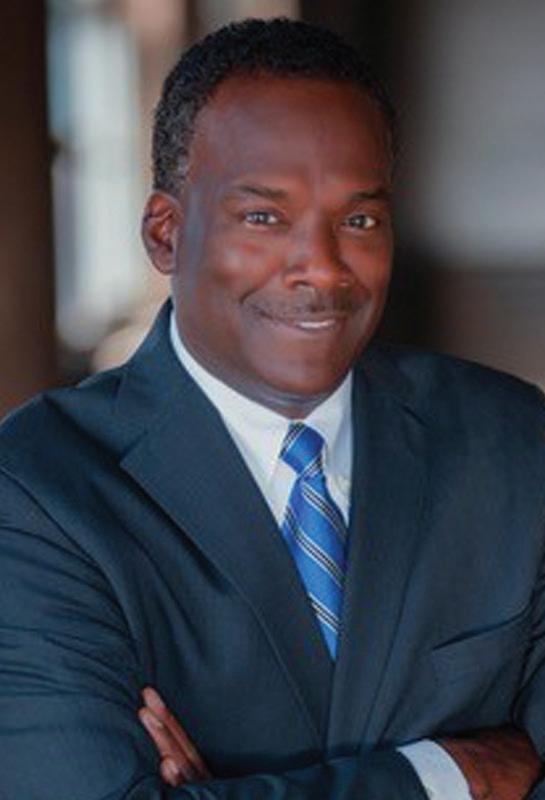
Enterprise Holdings. Mrs. Taylor is not just a figurehead in this role. She views it as one of the greatest honors of her life. Her father was a lieutenant general in the U.S. Air Force. Her father-inlaw named his company after an aircraft carrier on which he served doing bombing runs in the Pacific in World War II. The military is in her blood. She knows first-hand the sacrifices sailors and their
n “The Navy takes you all over the world, providing you an invaluable education about other cultures and perspective on our own country.”
– James E. Williams Jr.
each of about 70 men and women, who will alternate. She aims to raise funds for academic scholarships for their continuing education, and for their children. And she wants the crew to feel our community’s support and friendship, and for St. Louisans to feel pride in them and their patriotic mission. You can read more about this campaign and how to engage here: https:// supportourship.net/.
USS St. Louis is our ship. I’m doing all I can to support our crew and their families, because of what the Navy means to me. And I invite members of the African American community and all St. Louisans to join me. We all need to come together. We all need to realize: We are all shipmates.
Louis is Barbara Broadhurst Taylor, the daughter-in-law of the late Jack Taylor, founder of St. Louis-based Enterprise Rent-A-Car, and wife of Andy Taylor, the executive chairman of the company’s parent firm,
families make every day to serve America and
and, later, as productive citizens and professionals.
James E. (“Jimmy”) Williams Jr. is founder and CEO of Estel Foods Inc., a privately held company owning McDonald’s restaurants in Missouri and Illinois, and an active board member and volunteer in numerous civic organizations here.

Poor People’s Assembly and Moral March planned in Washington, D.C. on June 20
By Marc H. Morial National Urban League
“There’s no way we can inspire people to move with the normal politics that doesn’t fully address poverty. When you can work a full-time job at minimum wage and still not be able to afford a two-bedroom apartment anywhere in this country, that’s poor,” said Rev. William Barber II, co-chair of the Poor People’s Campaign.
“And if we can’t see that and if we don’t acknowledge that poverty then we are refusing to call upon these witnesses among us.”
In the richest country in the world, 140 million people struggle with poverty and low wealth.
Over the last 50 years, the U.S. economy has grown 18-fold. Yet wealth inequality has exploded. The top 1 percent’s share of the economy has nearly doubled, to more than 20 percent of our national income.
In 2017, the 400 wealthiest Americans owned more wealth than more than two-thirds of the entire U.S. population, and three individuals possessed a combined wealth equal to the wealth of 50 percent of the country.
The Poor People’s Campaign, led by the Rev. William Barber II, is a national call for a moral revival. It is a continuation of the work of Dr.
Martin Luther King Jr., who was just beginning to build the campaign when he was assassinated in 1968.
On June 20, the campaign will lead the Mass Poor People’s Assembly and Moral March on Washington, a “generationally transformative” gathering to demand that both major political parties address the “interlocking injustices of systemic racism, poverty, ecological devastation, militarism and the distorted moral narrative of religious nationalism.”
At the National Urban League’s 2017 Conference in St. Louis, Rev. Barber delivered a powerful and inspirational message of justice, drawing parallels between Nebuchadnezzar, king of Babylon, and modern political figures.
“They were former slaves, and he was oppressing them in this historical moment because they were growing in power and influence and he saw this as the last chance to stop a growing diversity,” Barber said of the Hebrew people. “He wanted to control their influence. He wanted to control their wealth. He wanted to control their faith. He even wanted to control their health.”
He suggested that the nation is in a third reconstruction.
“The first reconstruction was from 1868-1880. The second reconstruction was from 1954-
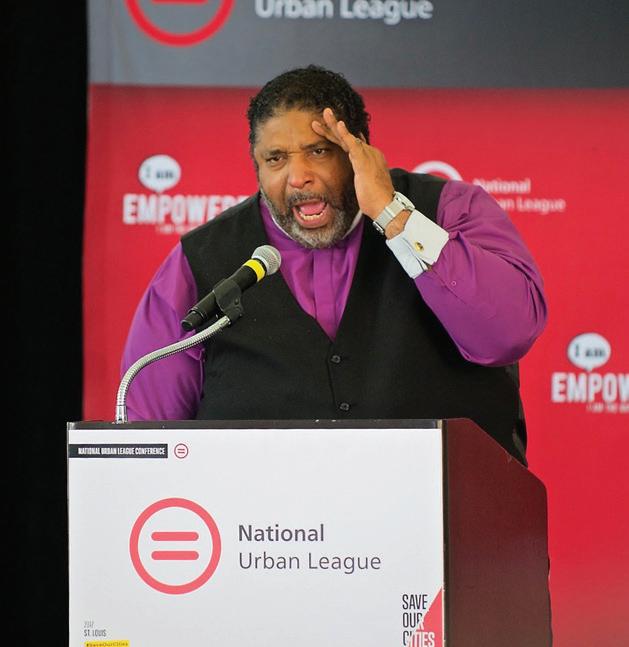
1968 , when Black and brown and white people came together — particularly in the South,”
and elected President Obama, that represented the possibility of a third reconstruction.
n The Poor People’s Campaign, led by Rev. William Barber II, is a continuation of the work of Dr. Martin Luther King Jr., who was beginning to build the campaign when he was assassinated.
he said. “And when we broke through the Southern Strategy
What we see happening is a Nebuchadnezzar spirit that is trying to block the
Dr. Gladys West helped develop what became the Global Positioning System (GPS) orbit in 1978.
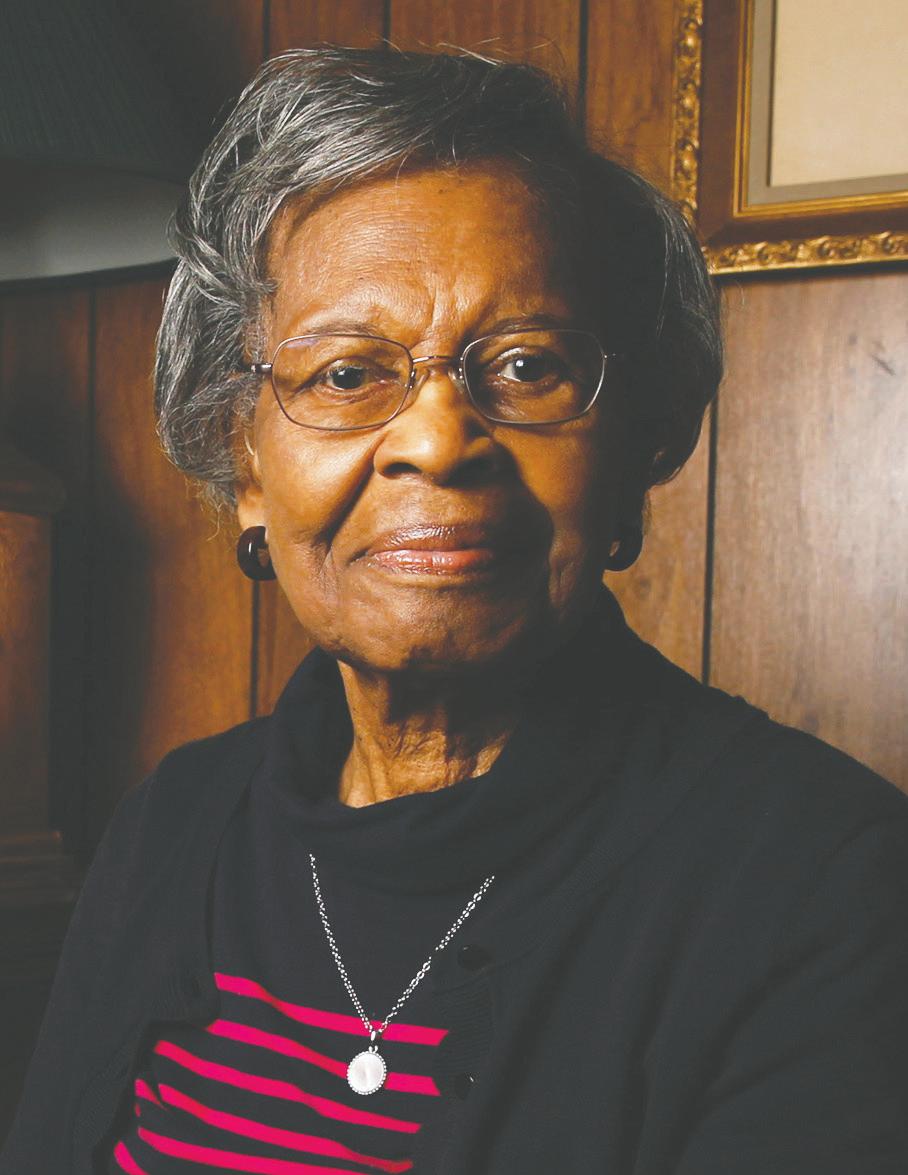
At the National Urban League’s 2017 Conference in St. Louis, Rev. William Barber II delivered a powerful and inspirational message of justice, drawing parallels between Nebuchadnezzar, king of Babylon, and modern political figures.
Photo by Wiley Price
transformation of America. Nebuchadnezzar might be dead, but the spirit — that narcissistic stuff still lives.”
That “Nebuchadnezzar spirit,” he said, is evident in the massive voter suppression effort that has swept the nation since the gutting of the Voting Rights Act in 2013.
In addition to the Poor People’s Campaign, Rev. Barber is president of the faith-based social justice organization Repairers of the Breach; Bishop with the College of Affirming Bishops and Faith Leaders; Visiting Professor at Union
Theological Seminary; and Pastor of Greenleaf Christian Church, Disciples of Christ in Goldsboro, North Carolina. He came to national attention in 2015 when, as president of the North Carolina NAACP, he organized weekly protests at the State Legislative Building that were known as “Moral Mondays.”
“Some ask the question, why don’t they be quiet? Well, I must remind you, that it has been our collective silence that has quietly opened the city gates to these undemocratic violators of our rights. If we must pray forgiveness for anything today, it will be the silence with which we have allowed this to happen in the dark?” Barber wrote of the Moral Mondays protests.
“Thoreau said in his famous essay, ‘Civil Disobedience,’ that if he had to repent of anything, it would be his good behavior. What possessed me, he asked himself, that I behaved so well in the face of such evil? As people of faith, we understand that we have been called to be the voice of the voiceless and the shepherd of God’s beloved community. What we do here today is only what any responsible shepherd does to alert God’s flock to the presence of the predators of democracy.”
The Urban League Movement is proud to support the Poor People’s Campaign and count ourselves as allies of Rev. Barber. We look forward to the assembly and ,arch in June.
Marc H. Morial is president and CEO of the National Urban League.
This Black History Month, we celebrate unknown and unsung Black innovators, inventors and contributors who have helped shape, change and improve our world. Learn more at aarp.org/blackcommunity
By Patricia Merritt
Louis American
For The St.
If a university is committed to diversity, how is that communicated to faculty and hiring committees? How does the school talk about diversity as an asset model versus a deficit one?
These were just a few of the many questions posed by Cynthia Neal Spence, associate professor at Spelman College and director of the UNCF/ Mellon Programs, who spoke January 31 at Southern Illinois University Edwardsville’s Center for Faculty Development and Innovation (CFDI).
Jessica Harris, interim assistant provost for inclusive academic excellence, coordinated Spence’s visit for the purpose of encouraging additional support for the Historically Black College and Universities (HBCU) recruitment initiative in graduate admissions and other campus-wide intentional efforts.
Spence noted and congratulated attendees on SIUE’s Statement on Diversity and Strategic Goals and for the university winning the Higher Education Excellence in Diversity (HEED) award for six consecutive years.
“It is clear that you all have been talking a lot about diversity,” Spence said. “What we are here to talk about today is: do the words meet the actions, and how do we actualize what we say?”
Spence, who has served on evaluation teams, informed the audience on some diversity items that are scrutinized.
How is diversity represented physically? What is the number of faculty of color? What are retention rates for faculty, staff and students of color? What is the tenure track like for people of color? Why do people of color come, and why do they leave? How does the
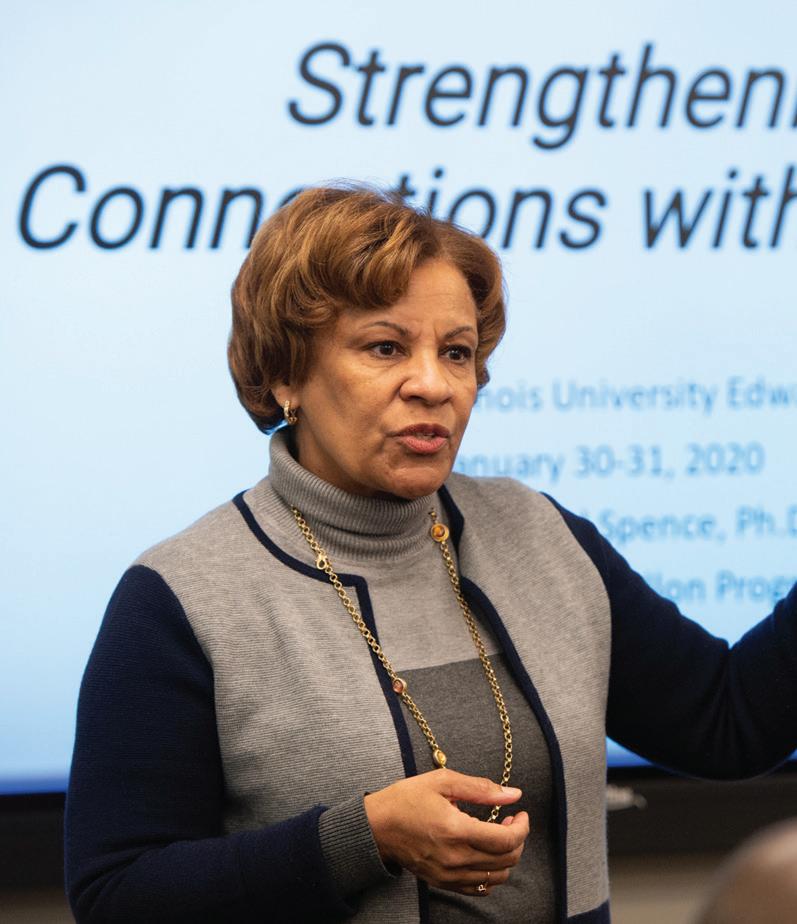
caliber individual, and there are individuals who meet those criteria who represent people of color. They are all across the universe, and I deal with them on a day-to-day basis. There are highly credentialed individuals who have gone through the same training as everyone else – and that is an asset model.”
One way to fill the diversity slack, Spence said, is to form partnerships.
“Partnerships matter because they can help bridge the gap and provide valuable resources,” said Spence. “HBCUs make for good partners, because they already have excellent track records.”
Some HBCUs facts that Spence noted:
curriculum reflect diversity across departments?
“When individuals do not stay long, what are you learning from that? What changes are you making?” she said.
“If you’re interested in diversity in faculty, staff and administrators, what are you doing? Are you just waiting around to see if anyone applies? Are you actively seeking applicants that are more diverse? Where are you publishing your advertisements? How are you letting people know that this might be a good place to work? Is your message to staff that mobility is not just for individuals who look one way?
Are you letting faculty know that SIUE is a place where they can do research that will be respected, and they will be able to move to the tenure track?”
It is critical that the university community not consider or buy into the “deficit model,” according to Spence.
“Some people believe that if you bring in diverse groups, then they won’t have the same quality as others. And that’s a problem,” she said.
“Because with diversity, you should be looking for the top-
• HBCUs enroll 20 percent of all African-American college graduates
• HBCUs account for 17 percent of bachelor degrees and nearly 25 percent of African Americans with STEM degrees
• There are 106 historically black colleges and universities in the U.S.
• Nine of the top 10 colleges that graduate most of the African-American students who earn PhDs are HBCUs.
“SIUE has a distinguished faculty member, Dr. Howard Rambsy, and an interim assistant provost, Dr. Jessica Harris, who are both HBCU alums—Tougaloo College and Dillard University, respectively— and a testament to the possibility, credibility and importance of diversity in higher education,” said Spence.
Harris said she was inspired and encouraged by the reactions to Spence’s visit.
“I am eager to collaborate with our provost, deans, faculty and staff to identify opportunities for us to partner with HBCUs and other minority serving institutions,” Harris said, “and to look forward to SIUE making a lasting contribution to the diversification of the academic pipeline.”

access for our diverse communities. STLCC celebrates African American History Month with a large variety of events open to the community.
By John U. Rees, author
Although our country’s first African American soldiers are largely unknown today, their contributions to the American Revolution were recognized during the war and through the early 19th century. William Cooper Nell, an African American, wrote the first book on the subject in 1855: The Colored Patriots of the American Revolution, with a foreword by author Harriet Beecher Stowe. But paintings and illustrations of the American Revolution depict few soldiers of color, and photography had not yet been invented. Regular and militia units fighting for American independence were largely integrated, with black, Native American, and white soldiers fighting side by side, which may have contributed to African Americans’ service being lost in the big picture.
Like their white and Native American comrades, black Continental soldiers served as musket-bearing infantry, artillerymen, cavalry troopers, officer’s servants, teamsters, wood cutters, road builders, ditch diggers, hut builders, and cooks. Continental Army soldiers of color (both African and Native Americans) received the same basic pay, provisions, clothing, and equipment as white soldiers. They suffered together in times of scarcity and jointly enjoyed the rare times of bounty. Black soldiers occasionally were singled out for labor details and, especially in the South, may have been required to serve as officers’ servants, but, by and large, commanders treated them as they did other enlisted men. White soldiers appreciated their contributions to the cause and generally valued them as human beings. Although some officers did not think African Americans would make good soldiers, black soldiers quickly proved their worth. In the end, African Americans fought in every major battle of the war and most of the smaller actions.
Throughout the conflict, thousands of enslaved people saw their opportunity and escaped to British-occupied areas. As historian Gregory J. W. Urwin observed, for enslaved blacks of the time, “freedom wore a red coat ” Early in the war, several Loyalist units supporting the British cause included musket-bearing soldiers of color. The 1775–1776 Ethiopian Regiment consisted of black private soldiers with a white command staff. But in March 1777, British commander Sir William Howe directed that “all Negroes, Mollattoes, and other Improper Persons who have been admitted into these Corps be immediately discharged.” From that point on, black soldiers in British and Loyalist units served mostly as musicians, servants, or laborers.
Soldiers of color joined the Continental Army for various reasons. Many fought for the same reasons their white comrades did: for the excitement of being a soldier, to protect their homes and communities, or for the revolutionary ideals espoused in the Declaration of Independence.
Enslaved African Americans did fight, and many were promised their freedom in return. Most were freed either before or after their military service, but some were forced to return to slavery.

During and after the American Revolution, governments, groups, and individuals strove to make real the ideals of the 1776 Declaration of Independence. Pennsylvania passed an abolition law during the war. Many freedom lawsuits were pressed in Massachusetts; in the 1790 census, no slaves were counted in that state. Some advances were made in the South as well: Virginia banned slave importation in 1778, and in 1782 made it legal for individual slave owners to free slaves privately.
However, soldiers of color, during and after their service, had the shadow of slavery hovering over them—a menace white veterans did not have to contend with. The postwar years brought with them a conservative counterreaction. After the US Constitution was ratified in 1788 and Eli Whitney’s cotton gin was patented in 1794, black bondage was cemented as a political and economic fact in the South. Detrimental racial attitudes hardened before, but more especially after, 1800. Black veterans, along with their white comrades, were eligible for service pensions, but some experienced the effects of increasing bias, especially in the South. African American military service was a direct challenge to slavery and the racial construct, and an affront to many white citizens. But the contributions of these soldiers during our founding war were invaluable, and my hope is that they finally get the full attention they have long deserved.
John U. Rees, author of “They Were Good Soldiers”: African-Americans Serving in the Continental Army, 1775–1783, will share stories of the black men and women who fought for our nation’s freedom at Soldiers Memorial in downtown St. Louis on Saturday, February 22, at 11am.

Thurs., Feb. 20, 4 p.m., Game Night: Political Warfare, St. Louis Public Library – Julia Davis Branch, 4415 Natural Bridge Ave. For more information, visit www.slpl.org.
Thurs., Feb. 20, 4 p.m., Road to the Vote: Doing My Part, St. Louis Public Library – Carondelet Branch, 6800 Michigan Ave. For more information, visit www.slpl.org.
Thur., Feb. 20, 6:30 p.m., St. Louis and the Integration of Baseball. Maplewood Public Library, 7550 Lohmeyer, 63143. For more information, visit www.maplewoodpubliclibrary.com.
Fri., Feb. 21, 7 p.m., Set The Night to Music featuring Love Jones The Band, St. Louis County Library – Florissant Valley Branch, 195 New Florissant Rd., S. For more information, visit https:// www.slcl.org/black-historycelebration
Fri., Feb. 21, 7 p.m., Best Dance and Talent Center 3rd Annual Trivia Night Fundraiser. Heman Park Community Center, 975 Pennsylvania Ave., 63130. For more information, visit www. eventbrite.com.
Fri., Feb. 21, 7:30 p.m., St. Louis Symphony Orchestra IN UNISON Chorus presents Lift Every Voice: Black History Month Celebration with special guest soloist Marlissa Hudson. An evening of music that celebrates the music of African American and African cultures. 718 N. Grand Blvd., 63103. For more information, visit www.slso.org.
Sat., Feb. 22, 2 p.m., Black History Jeopardy, testing knowledge on African American culture, music and sports, St. Louis County Library – Jamestown Bluffs
Branch, 4153 N. Highway 67. For more information, call (314) 993-3300 or visit www. slcl.org
Sat., Feb. 22, 3 p.m., The Legend Singers Choral Ensemble presents the Annual Festival of African American Spirituals. Workshop will be Feb. 21 – 22 – learn vocal style, performance practice and ensemble techniques. For more information, visit www.eventbrite.com.
Sat., Feb. 22, 3 p.m., Do You Know Your Black History Trivia Event. Union Memorial United Methodist Church, 1141 Belt Ave., 63112. For more information, visit www.unionmemorialstl.org.
Sat., Feb. 22, 3 p.m., The Importance of Voting: A Panel Discussion featuring Tishaura O. Jones, Treasurer, City of St. Louis; Michael Butler, Recorder of Deeds and Vital Records Registrar, City of St. Louis; Gena Gunn McClendon, Director, Voter Access and Engagement and Financial Capability, Center for Social Development, Washington University; Carol Strawbridge, League of Women Voters of Metro St. Louis, A meet and greet with the panelists will follow immediately after the discussion. St. Louis Public Library – Central Branch, 1301 Olive. For more information, visit www.slpl.org.
Sat., Feb. 22, 6 p.m., Mound City Bar Association Trivia Night. Ameren Corporate Office, 1901 Choteau Ave., 63103. For more information, visit www.moundcitybar.com.
Sun., Feb. 23, 10 a.m., Black History Observance, Solomon Temple Missionary Baptist Church, 4859 St. Louis Avenue, St. Louis, MO 63115. Sun., Feb. 23, 3 p.m. doors,

Community Women Against Hardship Black History Month Concert featuring Ferguson native Grammywinning trumpeter Keyon Harrold. For more information, call (314) 289-7523 or email: communitywomenstl@ yahoo.com
Tues., Feb. 25, 4 p.m., Why Black Study? Why Now? The Black faculty at SLU will discuss the continued relevance
of Black Study at SLU and throughout the Academy. Pere Marquette Gallery, DuBourge Hall, 221 N. Grand Blvd., 63108. For more information, call (314) 977-2242.
Tues., Feb. 25, 6:30 p.m., Discovery Club: African American Inventions (ages 5-11), St. Louis County Library – Jamestown Bluffs Branch, 4153 N. Highway 67. For more information, call (314) 993-
3300 or visit www.slcl.org
Wed., Feb. 26, 8:30 a.m., The 5th Annual Webster Diversity and Inclusion Conference (taking place from Feb. 24-27 on the campus of Webster University) hosts author Michele Norris author of The Grace of Silence: A Family Memoir. Winifred Moore Auditorium, Webster University, 470 E. Lockwood Ave., 63119. For more information, visit www.webster.edu/ conversations.
Wednesday, Feb. 26, 6 p.m., University of Mo-St. Louis African American Alumni Chapter and ABC present An Evening with Percy Green: Civil Rights Icon, J.C. Penney Summit Ballroom, UMSL Campus. For more information, call 314 516-5833.
Wed., Feb. 26, 6 pm., Association of Black Collegians Family Dinner, Buder Commons, 650 Maryville University Drive, St. Louis, MO 63141. For more information, e-mail: mreyes@ maryville.edu
Thur., Feb. 27, 5:30 p.m., 7th Annual Whitney M. Young Society Reception. Anheuser-Busch Biergarten, 1127 Pestalozzi, 63118. For more information, visit www. ulstl.com.
Thur., Feb. 27, 6 p.m., St. Louis University Black Alumni Association Happy Hour and Game Night. Up-Down STL, 405 N. Euclid Ave., 63108.
Thur., Feb. 27, 7:30 p.m., Georgia on My Mind: A Celebration of the Music of Ray Charles feat. Take 6, Nnenna Freelon, Kirk Whalum, and Clint Holmes Touhill Performing Arts Center, 1 University Blvd., 63121. For more information,
visit www.touhill.org.
Fri., Feb. 28, 5:30 p.m., Black History Trivia Night. Ferguson Community Center, 1050 Smith Ave., 63135. For more information, visit www. brownpreneurs.org.
Sat., Feb. 29, 11 a.m., Delta Sigma Theta Sorority, Inc., St. Louis Alumnae Chapter invites you to Founder’s Day Luncheon. With special guest speaker Bishop Vashti Murphy McKenzie. The America’s Center, 701 Convention Plaza, 63101. For more information, visit www.dst-sla.org.
Sat., Feb. 29, 10 a.m., Black History Month – The Story of Black St. Louis Bus Tour. The tour introduces participants to the rich African-American history of St. Louis since its founding in 1764. Griot Museum of Black History, 2505 St. Louis Ave., 63106. For more information, visit www.eventbrite.com.
Sat., Feb. 29, 1 p.m., The Gift of Gospel featuring emcee Pastor Shaun Williams, gospel music artist Jean Vann and additional performances by Christ Pilgrim Rest Children’s Choir, violinist Andrea Bell Darris and others. St. Louis County Library – Florissant Valley Branch, 195 New Florissant Rd., S. For more information, visit https://www. slcl.org/black-history-celebration
Sat., Feb. 29, 2:30 p.m., Better Family Life’s 7th Annual Jr. Unity Ball. Enjoy the 5th Annual America Scores Poetry Slam, awards ceremony, art activities, special guests, and more. 5415 Page Blvd., 63112. For more information, visit www.bflyouth.org/jrunityball.html.





